Contents
- Contents
- Glossary
- Creating Projects
- The Document Toolbar
- Project Outline View
- Gantt View
- Network View
- Resource View
- The Project Inspector
- The Milestones Inspector
- The Task Inspector
- The Resource Inspector
- The Styles Inspector
- The Custom Data Inspector
- Resolving Violations
- Using Dashboards (Pro)
- Importing and Exporting
- Reporting and Printing
- Working in the Cloud
- Multi-User Collaboration (Pro)
- Preferences
- Menu Commands and Keyboard Shortcuts
- Getting Help
Glossary
The following is a list of terms specific to OmniPlan or project management that you’ll encounter throughout this manual, defined and listed in alphabetical order for easy reference.
Actual schedule
- The actual schedule for a project, in contrast to a baseline schedule, is the way the project turns out in real life. Before you set a baseline for a project, its baseline and actual schedules are the same. After you set a baseline, further editing changes the actual schedule only.
Assignment
- Assigning a resource to a task means that the resource is expected to be working on that task throughout its duration. Assignment amounts are expressed as the percentage of the resource’s work time being spent on the task. Manage resource assignments on a per-task basis using the Assigned Resources inspector.
Attachment
- See linked file.
Baseline schedule
- A baseline schedule, in contrast to the actual schedule, is the way a project is planned to proceed from a given point in time. Before you set a baseline for a project, the baseline and actual schedules are the same. After you set a baseline, further editing changes the actual schedule only. You can compare a baseline schedule and the actual schedule in the Gantt chart using the View > Baseline Comparison submenu.
Child
- A member of a task or resource group is considered the group’s child. This is terminology common to outlining software.
Cost
- Both tasks and resources can have monetary costs. The total cost of a task is the sum of the task cost and the costs of the resources assigned to it. A resource can have either or both of a cost per use and a cost per hour.
Critical path
- The critical path is the series of dependent tasks which, if any of their durations change, will cause the whole project’s duration to change. You can check the critical path with View > Gantt > Critical Paths or the Critical Path toolbar button. Critical paths can be charted to individual milestones as well as to the entire project duration; view a milestone’s critical path by selecting its checkbox in the Milestones inspector.
Dependency
- The relationship by which one task must start or finish before another task can start or finish. For example, the task Buy Paint must finish before the task Paint Fence can begin.
Duration
- Duration, in contrast to effort, is how long a task takes to complete in actual working time. For example, a task which takes 4 hours of effort and is assigned to 2 resources (both at 100% units and efficiency) has a duration of 2 hours.
Efficiency
- The measure of how much work a resource can get done in a certain amount of time. Efficiency can affect duration and effort: 100% efficiency means the resource can contribute 1 hour of effort for every hour of work; 50% efficiency means it can contribute 1 hour of effort for every 2 hours of work; and so on.
Effort
- Effort, in contrast to duration, is how much work time a task takes to complete, considering all of the resources assigned to it. For example, a task which has a duration of 4 hours and has 2 resources assigned to it (both at 100% units and efficiency) has an effort requirement of 8 hours.
Elapsed Time
- A measurement of actual time required by a task or as a buffer between tasks. Elapsed time is “actual” in the sense that unlike regular duration or effort, the value refers to a specific amount of calendar time in the world and is not calculated based on the project’s work hours. Elapsed time is used when creating tasks with an elapsed duration, and can be used when setting lead/lag time between tasks.
Equipment
- Equipment is a type of resource. It represents some kind of reusable asset, such as computer hardware. It can also be useful to consider things like meeting rooms to be equipment, if you need to balance their use between different tasks.
- For equipment resources, units represent the percentage of the equipment’s time that is available for the project.
- Equipment can have Efficiency, Cost per Use, and Cost per Hour values.
Gantt Chart
- A Gantt chart is a chronological representation of the project, shown in OmniPlan on the right side of the Gantt View. Each task is represented by a bar, corresponding to a row in the task outline, and may be connected to other tasks by lines representing dependencies; the horizontal size and position of the bar indicate the expected duration and schedule for the task.
Gantt View
- A mode of the project document window in which you create, edit, and examine tasks. It contains the task outline on the left and the Gantt chart on the right.
Granularity
- The level of precision with which tasks are scheduled, as set in the Timeline inspector. Tasks can be scheduled exactly, or with hourly or daily granularity settings. The amount of effort a task requires is preserved when changing granularity (put another way, granularity only affects scheduling).
Group
- Items in the task outline or the resource list can be grouped together. The members, or children, of the group appear indented from the group itself in the outline. In the Gantt chart, a task group appears as a bracket enclosing its members.
Hammock
- A task of flexible effort whose duration changes based on constraints imposed by tasks scheduled before and after it.
Inspector
- A sidebar with tools to inspect your current selection.
- OmniPlan’s inspectors live on right side of the main window. You can click and drag on the inspectors’ left edge to hide them, offering more screen space for the main view; drag in from the right side of the window to reveal them if they’re hidden. Choosing Inspectors > Show/Hide Inspectors (Shift-Command-I) works to do this as well.
- When you select an item in one of OmniPlan’s views, the app automatically switches to the inspector most relevant to the type of item selected.
Interval Tracking
- A means of representing the cost or effort of a project at certain regular intervals. Both cost and effort can either be displayed for the given interval only, or cumulatively for the project at each interval. Interval tracking can be displayed in the Gantt chart as task labels and included with export to the CSV and OmniOutliner formats.
Item
- A single row in one of the task outlines or the resource list. General outlining commands like Expand and Collapse in the View menu and Indent and Outdent in the Structure menu work on items in any outline.
Lead Time
- Lead time is a duration you can put on a dependency to mean that some amount of time is needed between the two tasks involved. For example, a Start→Start dependency with a lead time of 1 day means that after the first task starts, the second task can start one day later.
- Lead time can be negative; for instance a Finish→Start dependency with a –2 hour lead time will allow the second task to start once the first task is 2 hours from completion.
- You can set up lead time by typing a duration (such as +3w or –2d4h) either at the end of a dependency code in the Dependents or Prerequisites column of the task outline, or in the Dependencies inspector.
- Lead time can also be a percentage of the predecessor task’s duration; for example you could enter 100% for a lead time exactly as long as the task it comes after.
Level
- Leveling the project, or leveling resources, means automatically rearranging the project to make sure the resources are being used as efficiently as possible. This means not allowing a resource to be assigned at more than 100% of its available units at any time, and finding the best order for resources to work on tasks in order to complete them more quickly.
- Newly created projects can be set to automatically level resources as they are allocated to tasks. You can disable automatic leveling in the Project menu.
- When not leveling automatically, you should level your project after making changes like updating task completion or changing resource assignments.
Linked File
- A linked file is a representation in OmniPlan of a file somewhere on your computer. You can link files with Edit > Add Link To File to the project as a whole, to a task, or to a resource, and manage linked files for any of these with the Custom Data Linked Files inspector.
Material
- Material is a type of resource, representing consumable supplies.
- For material resources, Units represent how many of the resource are being used throughout the project. This value updates as the resource is assigned to more tasks.
- Material resources can have Cost per Use values, but not Cost per Hour values.
Milestone
- A milestone is a type of task that has no duration and requires no effort. Its purpose is to mark an important point in the project timeline. Based on dependencies and work schedules, a milestone may shift in time; you can keep track of your project’s milestones in Gantt View and the Milestones inspector.
Monte Carlo Estimation
- The Monte Carlo simulation method uses random sampling based on a spread of values to estimate probable outcomes—in the case of OmniPlan Pro, the likelihood that your project or milestone will reach completion on time. When a simulation is run, hundreds of randomized possible outcomes are considered, and the average result is reported as a percentile of confidence that the milestone will be reached on a given day.
- Because the estimate data used is randomized across a range of possible values, running multiple Monte Carlo simulations on the same data set will generate slightly different results each time. However, the number of iterations in a single simulation is high enough to eliminate grossly inaccurate outliers.
Network View
- A mode of the document window that describes a project as a network diagram—a web of task nodes connected by dependencies. Unlike a Gantt chart, a network diagram deemphasizes project chronology in favor of a clear, evident depiction of the relationships between tasks.
Parent
- A group is considered the parent of all its members. This is terminology common to outlining software.
Project Outline View
- A mode of the document window in which you can create, edit, and examine tasks. It contains a task outline that spans the entire window, providing a more data-rich view with as many custom columns as possible.
Publishing
- When a project is publishing information about itself (a feature of OmniPlan Pro), it is telling other projects in a shared server repository what resources assigned to it are up to. If a resource is shared between projects (as indicated by an identifying email address), the load on that resource indicated by all publishing projects is taken into account when leveling across projects subscribing to the repository.
Resource
- Resources are the people and things needed to get a project done. Resources are listed in the resource list, and can be assigned to tasks. The three types of resources are Staff, Material, and Equipment.
Resource load
- A resource’s load is the amount of effort it is assigned to do at various times throughout the project. If a resource is assigned at more than 100% of its availability all at once, it is said to be overloaded or overutilized. Resource leveling tries to alleviate overload of resources. You can see each resource’s load in the resource timeline with View > Timeline > Resource Loads.
Resource timeline
- On the right side of the resource view is a timeline of the tasks assigned to each resource. It provides a more vertically-compressed, resource-oriented look at the project.
Resource View
- The mode of the document window in which you create, edit, and examine resources and schedules. It contains the resource list on the left and the resource timeline on the right, as well as calendars for normal working hours and custom hours.
Slack
- Also known as float, in project management terminology slack refers to the amount of time a given task can be deferred until its duration to completion conflicts with the beginning of a subsequent dependent task (thereby causing a delay). Free slack refers to slack specific to a task and its successor, while total slack refers to a sum of all free slack in the project up to completion. Both values can be displayed as columns in Gantt View.
Staff
- Staff is a type of resource, representing people who work on the project.
- Staff units are measured as percentages. A person who is fully available to the project has a units value of 100%; someone who is spending part of their working hours on other projects would have lower available units. Note that this is not the same as having fewer working hours (which can be set in the Resource view), or being less efficient (which can be set in the Resource Info section of the Resource inspector).
- Staff can have Address, Efficiency, Cost per Use, and Cost per Hour values.
Subscribing
- When a project is subscribing to a shared server repository (a feature of OmniPlan Pro), it is on the lookout for resource load data being published by other projects. When leveling loads, a subscriber will adjust resources based on usage information received from the published projects.
T day
- The first day of a project that has an undetermined start date. Until the start date is set, all dates are represented by an amount of time after T day, such as T+2w 1d.
Task
- An item of work that needs to be done for the project to progress. A task is represented by a row in the task or project outline, and by a corresponding task bar in the Gantt chart.
Template
- A template is a file you can use as a starting point for new documents, or (with OmniPlan Pro), there are also report templates, which are used for creating a HTML-based report of a project.
Units
- Units measure amounts of resources in various contexts. For staff and equipment resources, the units value is a percentage representing how much of the resource’s effort is available to be assigned to tasks in the project. For material resources, the units value is a number representing the physical quantity of the material used by tasks in the project.
Variance
- Variance is the amount of time by which the actual schedule differs from the baseline schedule.
Violation
- A violation is some sort of problem in the project that prevents it from working out properly. Violations can be resolved using the Violations Window.
Creating Projects
When you first launch OmniPlan you are presented with the New Project Assistant, a tool that offers choices for the most commonly used settings when creating a new project.
After choosing the settings you want, a new OmniPlan document appears, ready to develop for the specific needs of your project. This chapter describes creating a project using the New Project Assistant, as well as creating templates for kickstarting future projects with frequently used attributes.
Using The New Project Assistant
To create a new project, choose File > New Project (Command-N). This opens the New Project Assistant: a window with a set of initial options that form the foundation of a new project.
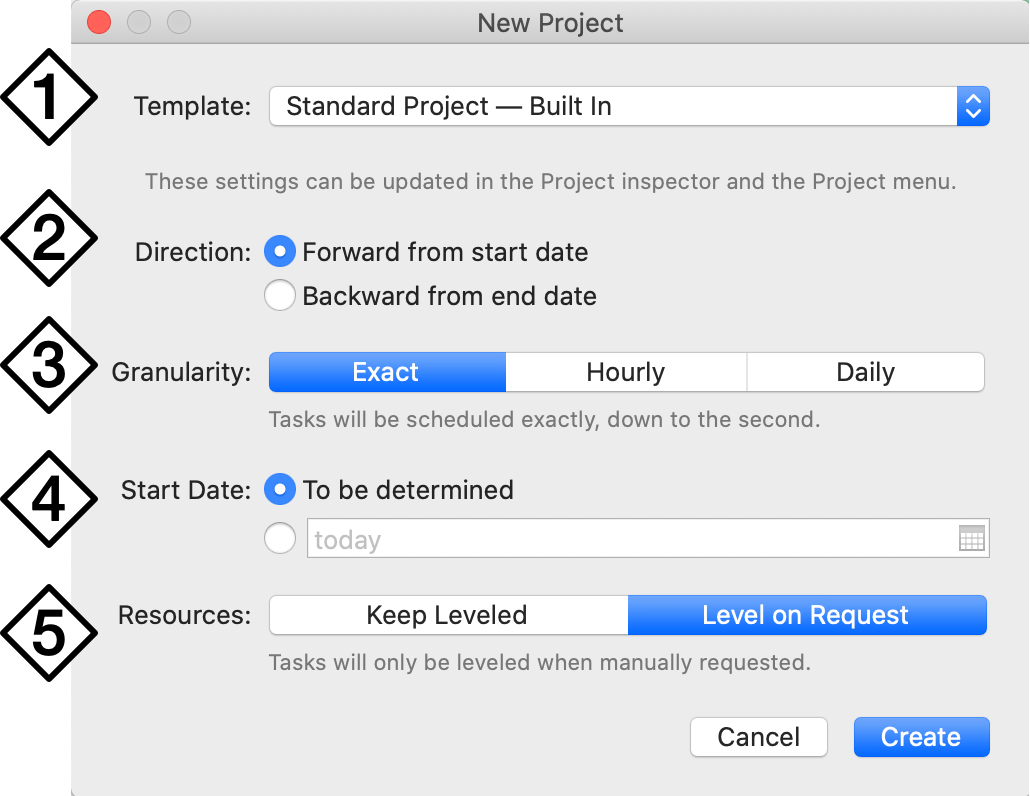
-
Template—Choose a template file with a set of predetermined characteristics for your project. Three are built-in with OmniPlan; you can create your own if you find that there are specific attributes you use frequently.
-
Direction—Choose whether the project is scheduled forward from a fixed start date or backward from a fixed end date. This corresponds to the Direction setting in the Project inspector.
-
Granularity—Choose whether tasks are scheduled exactly (down to the second), or with some degree of rounding. This corresponds to the Granularity setting in the Project inspector.
-
Start Date/End Date—If the project has a known start date (for a project with Forward direction) or end date (for a project with Backward direction), enter it here. These correspond to the Dates set in the Project inspector.
-
Resources—Choose whether the project levels resources automatically, or only upon request. This corresponds to the Automatically Level Resources setting in the Project menu.
Built-In Templates
The three templates included with OmniPlan offer a sample of useful configurations for getting a quick start on your project.
- Simple Project—This barebones template features minimal styling and includes a single task and a single resource, a good starting point for creating your own project from scratch.
- Standard Project—This template is also styled minimally, but includes an additional pre-configured Conference Room resource (useful when scheduling meetings).
- Standard Project (Styled)—This template is identical to the Standard Project template, but with additional styling for visual presentation.
After a project is created from one of these templates, any existing properties can be changed or removed to suit your project’s specific needs and workflow.
Click Create once you have the project set up to your liking, and a new document appears with your chosen settings.
When you’re ready, choose File > Save (Command-S) to save the file to a convenient location.
Choosing a Save Location
Due to macOS sandboxing restrictions, files saved outside of locations that OmniPlan’s application sandbox can reach cannot be reached by OmniPlan URLs created with Edit > Copy Link To Task/Resource.
The choice of where to save your project files may also be informed by cloud storage considerations, or your multi-user collaboration setup (with OmniPlan Pro).
Creating Templates
A template is a file set up to be a starting point for a new project. For example, there might be certain resources you use for every project, a common task structure, certain named styles you like to use, or a standard set of working hours for your company. You can configure all of these things once in a template file, then create new documents from that template.
To create a new template:
-
Start by creating a new project normally with File > New Project.
-
Set up the project however you like. Everything about a project, including its contents, its styles, the state of the inspectors, the columns displayed, and so on, can be saved in a template.
-
Once the document is ready, choose File > Save As Template.
-
Enter a name for the template and confirm it.
To edit or delete existing templates, or set a default template for new projects, use the Templates pane of OmniPlan Preferences.
OmniPlan Documents in macOS Dark Mode
Previous versions of OmniPlan relied on specific templates to create documents compatible with macOS Dark Mode. Starting with OmniPlan 4, new documents created with the default templates automatically switch color themes based on your appearance settings in macOS System Preferences > General Preferences.
The Document Toolbar
As with most applications, OmniPlan has a document toolbar that spans the top of each OmniPlan project window with buttons for commands you use frequently. The toolbar contains a default set of commonly-used controls, which you can customize to add or remove whichever ones you like.

In addition to the document toolbar, there are other toolbars available depending on your system and view configuration that can be used for quick access to common app functions: the document overview and the Touch Bar.
Customizing the Toolbar
Choose View > Customize Toolbar to open the toolbar customization sheet, which contains the full list of available toolbar buttons and spacing options, along with options for how buttons are displayed. Changes made to the toolbar of the current document apply universally to all OmniPlan documents.
To restore the default toolbar, drag it from the bottom of the customization sheet into the toolbar space of the document.
Toolbar Tools
When customizing the toolbar, the following buttons are available.
Some toolbar buttons have different functions depending on whether you single-click or click and hold the button.
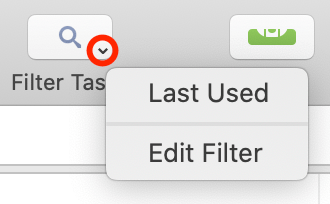
These buttons are indicated by a chevron in the lower right corner, which additionally serves as a click target for the button’s secondary mode (typically a dropdown menu).
Some buttons also have additional modes accessed by option-click. These are indicated by a change in the button icon when pressing the option key.
View 
Use the View switcher to switch between each of OmniPlan’s view modes: Project Outline View, Gantt View, Network View, and Resource View.
Critical Path 
Use the Critical Path button to show or hide the critical paths to each of the project’s milestones. Use the dropdown menu on the button (or click and hold) to choose which milestones’ paths are displayed. Critical paths only appear in the Gantt chart; see Using Critical Paths for details.
Filter 
Use the Filter button to create or apply a custom filter to tasks in the project. When a filter is applied, only tasks matching the criteria are displayed (all other tasks are hidden). While a filter is applied, a notice bar appears at the top of each view with details about the filter’s scope and options to edit, remove, or refresh the filter.
Use the dropdown menu on the button (or click and hold) to choose a saved filter to apply, create a new filter, or remove or edit the current one.
Publish (Pro) 
With OmniPlan Pro, use the Publish button to push local changes to a project in a shared sync repository up to the server. Use the dropdown menu on the button (or click and hold) to select individual publish actions or open Sync & Sharing Options.
See Multi-User Collaboration (Pro) for details.
Refresh (Pro) 
With OmniPlan Pro, use the Refresh button to pull changes from a project in a shared sync repository down to the local copy. Use the dropdown menu on the button (or click and hold) to select individual refresh actions or open Sync & Sharing Options.
See Multi-User Collaboration (Pro) for details.
Level 
Use the Level button to programmatically rearrange tasks for optimal efficiency.
Catch Up 
Use the Catch Up button to update task completion to the present day (or another chosen date). See Updating Task Completion for details.
Reschedule 
Use the Reschedule button to update the scheduling for tasks that are incomplete as of the present day (or another chosen date). See Rescheduling Incomplete Tasks for details.
Add 
Use the Add button to create a new task or resource as a peer beneath the bottommost selected task or resource (or at the bottom of the project if nothing is selected).
Add Child 
Use the Add Child button to create a new task or resource beneath and one level of hierarchy within the bottommost selected item (or at the bottom of the project if nothing is selected). That item becomes a group containing the new task or resource (if it is not already one).
Add Dependent 
Use the Add Dependent button to create a new task beneath the bottommost selected task that is connected to it by a Finish > Start dependency.
Add Milestone 
Use the Add Milestone button to create a new milestone beneath the bottommost selected task (or at the bottom of the project if nothing is selected).
Remove 
Use the Remove button to delete the selected items from the project.
Simulations (Pro) 
With OmniPlan Pro, use the Simulations button to assign estimated effort to the selected tasks and to run Monte Carlo simulations based on those estimates.
Reports (Pro) 
With OmniPlan Pro, use the Reports button to open the Report window.
Group 
Use the Group button to create a new group task or resource containing the selected items.
Split 
Use the Split button to split the selected task.
Connect Tasks 
Use the Connect button to connect the selected tasks with Finish > Start dependencies. Use the dropdown menu on the button (or click and hold) to choose another dependency type, or to remove dependencies from the selected tasks.
Disconnect Tasks 
Use the Disconnect button to remove any dependencies between the selected tasks.
Assignment 
Use the Assignment button to check and set resource assignments for the selected tasks.
Baseline/Actual 
Use the Baseline/Actual menu to choose a mode for viewing tasks that compares the actual project schedule with various baseline models for the project. See Gauging Progress with Baselines for details.
Set Baseline 
Use the Set Baseline button to take a snapshot of the project’s progress for comparison with future actual work. See Gauging Progress with Baselines for details.
Inspect 
Use the Inspect button to show or hide the inspectors on the right side of the project window.
Violations 
Use the Violations button to show or hide the Violations window.
Track Changes (Pro) 
Use the Track Changes button to start or stop tracking changes made by remote collaborators on a shared project. See Change Tracking for details.
Fonts 
Use the Fonts button to open the Fonts window, for picking font types and properties for the various style attributes of the project.
Colors 
Use the Colors button to open the Colors window, with palettes for picking colors for the various style attributes of the project.
Print 
Use the Print button to open OmniPlan’s print dialog for the current project.
Show Console (Pro) 
With OmniPlan Pro, use the Show Console button to open the Omni Automation JavaScript console. For sample Plug-Ins and to learn more about scripting OmniPlan, visit the Omni Automation website.
Space 
Drag the Space box to a spot on the toolbar to add a fixed-width gap between toolbar buttons (roughly the size of a button).
Flexible Space 
Drag the Flexible Space box to a spot on the toolbar to add a variable-width gap between toolbar buttons (the gap expands or shrinks based on the number of buttons on either side, and the width of the project window).
The Document Overview
The toolbar has an optional companion in the document overview, a horizontal bar with a condensed view of the Gantt chart that appears when you choose View > Show Overview. The overview is a great way to get a quick survey of your entire project no matter which view you are in.
In Gantt and Resource Views, the overview also offers an alternate control for browsing through your project—click and drag the selection box to scroll through the main view’s Gantt chart or resource timeline.
Customizing the Touch Bar
If your Mac supports it, OmniPlan uses the Touch Bar to bring useful tools and controls to your fingertips.
In the Gantt and Resource Views when no task is selected, the Touch Bar displays an overview of the Gantt chart or resource timeline (the same offered with View > Show Overview), along with controls to Level, Catch Up, or Reschedule tasks based on the current project status.
With a task selected, the Touch Bar adapts to offer contextual control for reviewing and assigning resources to the task.
The task’s duration is denoted by the white tick marks centered beneath the resource. A green bar between the tick marks indicates that the resource is assigned to the selected task, while a blue bar indicates that the resource is assigned to another task at that time. A blue bar to the right or left of the tick marks indicates that the resource is assigned to an adjacent task, and a red bar indicates that the resource is overloaded.
While in this view, tap the resource in the Touch Bar to assign it to (or unassign it from) the selected task.
Similarly to the toolbar, a wide range of OmniPlan-specific buttons can be displayed in the Touch Bar. Configure them to suit your needs by choosing View > Customize Touch Bar.
Project Outline View
Enter Project Outline View by clicking the first button in the view switcher in the toolbar, or choosing View > Project Outline View (Option-Command-1).

Project Outline View provides a representation of your project as a hierarchical list of tasks. Each task is represented by a row, with corresponding columns that contain specific types of information related to the tasks in your project.
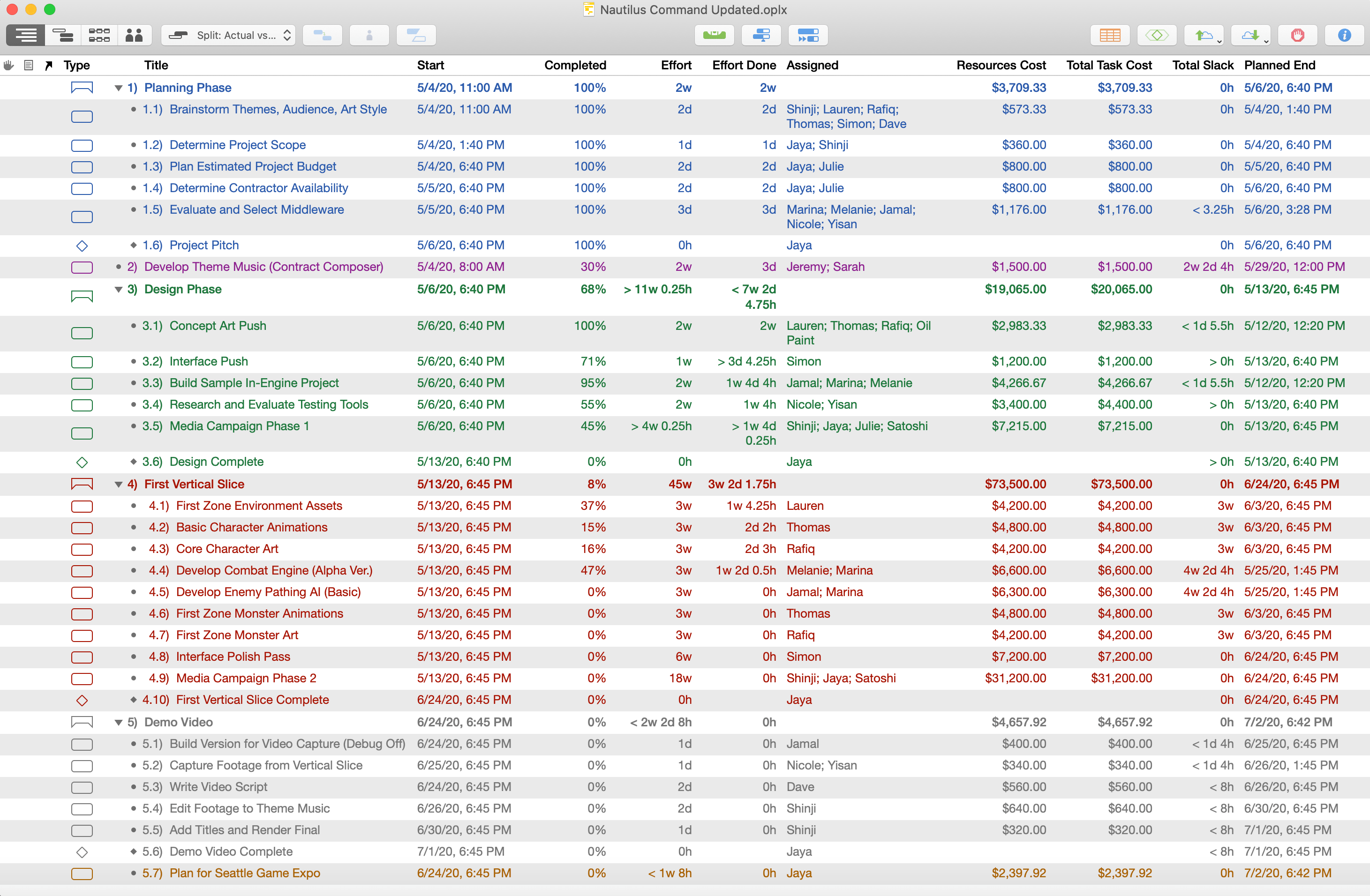

This view is ideal for quickly creating a project by entering the tasks it contains, adding the relevant information in customizable columns, and once the project is up and running, getting a data-rich spreadsheet-style overview of the project’s progress.
Creating and Deleting Tasks
As you begin building a project, rapidly creating new tasks and milestones (and removing extraneous ones) are key parts of the process, and Project Outline View is perfect for the purpose.
There are several ways to create new items in the outline:
- Select an item in the task outline and press Return (or Command-Return, depending on the keyboard options in OmniPlan’s General preferences).
- Click the Add button in the toolbar.
- Control-click and choose Add > [task type] from the contextual menu.
There are a few ways to delete a task, milestone, or group:
- Select an item in the outline, then press the Delete key.
- Select the item, then click the Remove button in the toolbar.
- Select the item, then control-click to reveal the contextual menu and choose Delete.
If you are publishing and subscribing with OmniPlan Pro, new tasks and changes can come from other users of the project. Use the change tracking sidebar to accept or reject these changes.
Project Outline Columns
You can customize the outline in Project Outline View to display a set of columns with data specifically relevant to your project. Control-click the outline header or choose View > Task Outline > Customize Columns to choose which columns to display.
Data in the these columns corresponds to task rows in the outline. Some column values (such as Task Cost) can be edited directly in the outline; others (such as Total Cost) are calculated automatically. Generally, values you can edit in the outline correspond to editable fields in the Task and Resource inspectors.
Use the arrow keys, or Tab and Shift-Tab (depending the options you have chosen in OmniPlan’s preferences), to move between cells.
Drag column titles left and right to rearrange the columns.
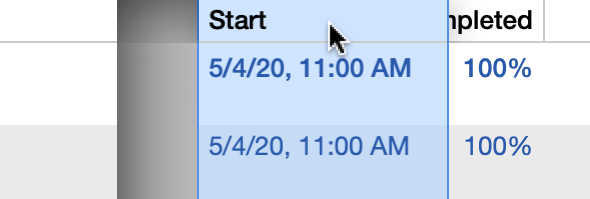
You can sort the selected items in the outline, or all items (if nothing is selected), by using the Sort commands in the Structure menu.
If you would like to add columns to the task outline that aren’t part of the default list (or if you are seeing unexpected entries in the list), note that key/value pairs you set up for tasks using the Custom Data inspector are added to the list as custom column types.
The following columns represent properties of tasks that can be included for display in the outline.
Violations
This column displays an icon for each task that has a violation. Click the icon to summon the Violations window and see what the problem is.
Status
This column shows alarm clock icons for tasks that are incomplete and due in the next few days, or in the past. Note that these icons won’t appear if your project has an undetermined start date. Each icon color has a meaning:
- Almost due (green): this task is incomplete and due in the next 3 work days.
- Due (yellow): this task is incomplete and due in the next work day.
- Past due (red): this task is incomplete and past due.
Attachments
Click the Attachment icon in the selected row to see a menu of the item’s attachments, or to link to a file if there is not one linked yet. Rows with links to files show an arrow icon even when they are deselected.
Notes
Store extra text about an item with this column. To edit the selected item’s note, press Command-’, click the Note icon that appears in the column, or use the Custom Data Notes inspector.
Once an item has a note, you can move in and out of the note field by pressing Command-’ (which hides the note after you stop editing it). Rows with notes show a note icon even when they are deselected.
Note text can be styled on a document level using the Advanced tab of the Styles inspector or customized individually with the Format menu.
Unique ID
The unique ID is a number assigned to each task to identify it unambiguously, even if its name or position in the outline changes. A unique ID won’t ever change, and each new task or resource you create gets a new unique ID number. These numbers are useful for matching up items when you are importing and exporting projects between OmniPlan and other applications.
Title
The title of the task, preceded by a number representing its hierarchical placement in the outline.
Hierarchical Title
The title of the task, preceded by the title of each task above it in the hierarchy, with each title separated by a colon.
Duration
The task duration.
Effort
The amount of total effort the task takes to complete.
Effort Done
The amount of effort completed on the task.
Remaining Effort
The amount of effort remaining before the task is completed.
Prerequisites
A list of the tasks, by number, that the task relies on in some way (as indicated by the dependency type code).
Dependents
A list of the tasks, by number, that rely on this task in some way (as indicated by the dependency type code).
Start
The actual start time for the task, as determined automatically by leveling or set manually in this cell or in the Task Schedule inspector.
End
The actual end time for the task, as determined automatically by leveling or set manually in this cell or in the Task Schedule inspector.
Priority
You can manually set a priority on a task to control the order in which tasks are leveled. During leveling, if two tasks are assigned to one resource at the same time, the task with higher priority (expressed as a larger positive number) gets to use the resource first.
Completed
The amount of work that has been completed on the task, expressed as a percentage.
Assigned
A list of the resources that are assigned to the task.
Start After
Set or display the task’s Start After constraint, if any. This is the same as the Start No Earlier Than constraint in the Task Schedule inspector.
Start Before
Set or display the task’s Start Before constraint, if any. This is the same as the Start No Later Than constraint in the Task Schedule inspector.
End After
Set or display the task’s End After constraint, if any. This is the same as the End No Earlier Than constraint in the Task Schedule inspector.
End Before
Set or display the task’s End Before constraint, if any. This is the same as the End No Later Than constraint in the Task Schedule inspector.
Task Cost
Any costs associated with completing the task other than the cost of the resources assigned to work on it.
Resources Cost
The cost of the resources assigned to the task. This value cannot be edited directly (edit the individual resource costs or change the resource assignments instead).
Total Task Cost
The task cost plus the resources cost.
Planned Start
The time at which the task is planned to start according to the baseline schedule.
Start Variance
The difference between the planned start and the actual start of the task.
Planned End
The time at which the task is planned to end according to the baseline schedule.
End Variance
The difference between the planned end and the actual end of the task.
Free Slack
Slack between an individual task and its subsequent tasks. This value cannot be edited directly.
Total Slack
Total slack refers to the time before an individual task would have an effect on the duration of the project as a whole. This value cannot be edited directly.
Min Effort Estimate (Pro)
The minimum amount of effort that you estimate the task will take. This value can be set automatically using the Simulations toolbar button. This and the following two values are part of the computation for Monte Carlo simulations.
Expected Effort Estimate (Pro)
The amount of effort that you expect the task will take. By default this is equal to the task’s actual effort.
Max Effort Estimate (Pro)
The maximum amount of effort that you estimate the task will take. This value can be set automatically using the Simulations toolbar button.
Earned Value Analysis (Pro)
OmniPlan 4 Pro offers several custom column types useful for tracking and managing the budget and progress of your project. Taken together, they represent a full implementation of the Earned Value Analysis project management technique (also known as earned value management, or EVM). We’ll be referring to it as earned value analysis (or EVA) throughout OmniPlan and throughout this manual.
Since the value of EVA lies in the comparison of the actual state of your project with its initial plan, the first thing we need is a baseline. If you don’t have one set up yet, you’ll want to do that now. If you would like to simulate a project state earlier or later in the project, choose Project > Set Current Editing Date and enter the desired date.
If you compare with a baseline set at the beginning of your project, many EVA column values won’t appear. This is because you would essentially be dividing by zero (the current actual cost at that baseline) to generate the cost performance index, and earned value is only relevant in the context of other factors affecting the project in progress. For a preview of the planned costs of your project, try using the Total Task Cost column instead.
With a baseline set, we can start building out the attributes of tasks and resources that EVA requires to deliver meaningful results. The original and derived values represented by the suite of EVA columns can be dizzying to take in all at once, so let’s break it down into some smaller pieces.
We’ll begin by enabling some familiar, pre-existing columns, and making sure they’re populated with relevant data.
In Gantt View:
- Effort—Any task you create is going to require some amount of effort to complete, so this one’s easy.
- Effort Done—EVA tracks progress compared to the baseline, so updating the amount of work done on tasks is an important component of calculating value.
In Resource View:
- Cost/Hour or Cost/Use—Tracking how much money is being spent on effort done is another key component of EVA. If your workers are salaried, you’ll want to compute their wage as an hourly value for use here.
With these set up, we can begin putting the EVA columns to use. This first group of columns tells us about the amount of money we’ve spent on tasks to this point in the project, and compares that with our initial budget.

- Actual Cost (ACWP)
- This column is pretty straightforward; it’s the actual cost of work performed up to the current date. In OmniPlan terms, this represents the amount of effort completed by resources assigned to a task, multiplied by their costs. If two 8-hour days of effort are finished and a resource is contributing at 100% units and efficiency at a Cost/Hour of $50, they’ll contribute $800 to the actual cost.
- Earned Value (BCWP)
- The earned value, or budgeted cost of work performed, is another pretty simple calculation that represents the planned budget for the amount of work done on the project at this point (“this point” being the baseline used for analysis). This value is determined at the start of the project by effort assignments and resource costs.
- Cost Performance Index (CPI)
- The Cost Performance Index is reached by dividing the task’s earned value by its actual cost. This is a handy way to see, at a glance, whether the task is over- or under-budget: values higher than 1 are under budget, values lower than one are over budget, and 1 exactly means the project’s budget is right on track.
- Cost Variance and Cost Variance %
- Cost Variance is the concrete number that gives us the good (or bad) news about how much a task is under or over budget. The Cost Variance column is expressed as a currency amount relative to the earned value, and the Cost Variance % column is (as you would expect) expressed as a percentage of the earned value. Notably, any time the planned and actual budgets agree (the cost performance index is at 1), these columns will be empty.
The next group of EVA columns describes the status of the project relative to the planned schedule.

- Planned Value (BCWS)
- Planned Value, or Budgeted Cost of Work Scheduled, lists the expected cost of work-to-date as planned in the project’s initial schedule. This is derived from the planned costs of tasks and resources, along with the baseline and editing date chosen.
- Schedule Performance Index (SPI)
- The Schedule Performance Index is derived by dividing earned value by the planned value. Like the cost performance index, it’s expressed as a number greater or less than one; higher values represent being ahead of schedule, while values less than one represent being behind schedule.
- Schedule Variance and Schedule Variance %
- Schedule Variance is the value that tells us in concrete terms how far we are ahead of—or behind—schedule. It subtracts planned value from earned value, giving us an amount in currency that represents the difference between how much we should have been paying for work-to-date, versus how much we’ve actually paid. Schedule Variance % represents this same amount as a percentage.
The final group of EVA columns is related to forecasting the budget of tasks at their completion.
- Estimate at Completion (EAC)
- This value represents the estimated actual final cost of the task, as work progresses. Before the start of the project, EAC is equal to the budget for the task (Budgeted at Completion, below). As the project progresses, EAC and BAC may diverge.
- Budgeted at Completion (BAC)
- Budgeted at Completion represents the initial budgeted cost of all work on the task. If work gets behind schedule or there are cost overruns on materials, the actual cost (and therefore the estimated cost at completion) will rise above the BAC cost.
- Variance at Completion (VAC)
- This column represents the difference between the estimated actual (final) cost of completion and the budgeted (initial) cost of completion of the task. Expressed as a currency amount, a negative VAC denotes a cost overrun, while a positive VAC represents a budget surplus.
- To Complete Performance Index (TCPI)
- The To Complete Performance Index is a bit unique among the EVA columns in OmniPlan, in that it tells you about the state of your project’s budget and schedule by way of a recommendation. The TCPI represents the cost performance index (CPI, explained above) that you need to maintain for the task, from your current editing date, in order to be on budget. A value other than 1 describes a recommended course correction: higher requires some belt-tightening, while lower indicates that there are funds to spare.

As another way to think about EVA, consider the current editing date and the baseline as the x and y axes of a chart whose parameters you can use to set up simulated scenarios for your project. The baseline provides a y-axis time anchor for your project’s state of affairs, and the current editing date is a time travel device along the calendar’s x-axis that lets you consider that snapshot as if the project’s progress to date had happened earlier, or all progress froze and the project stood still until some point in the future.
Filtering the Project Outline
When you want to focus on a specific aspect of your project, you can view a subset of its tasks by creating filters for specific criteria. Possible filters include focusing on tasks that were completed in the past week, tasks that are behind the baseline target date by greater than three days, or as in the example below, tasks that are less than 50% complete.
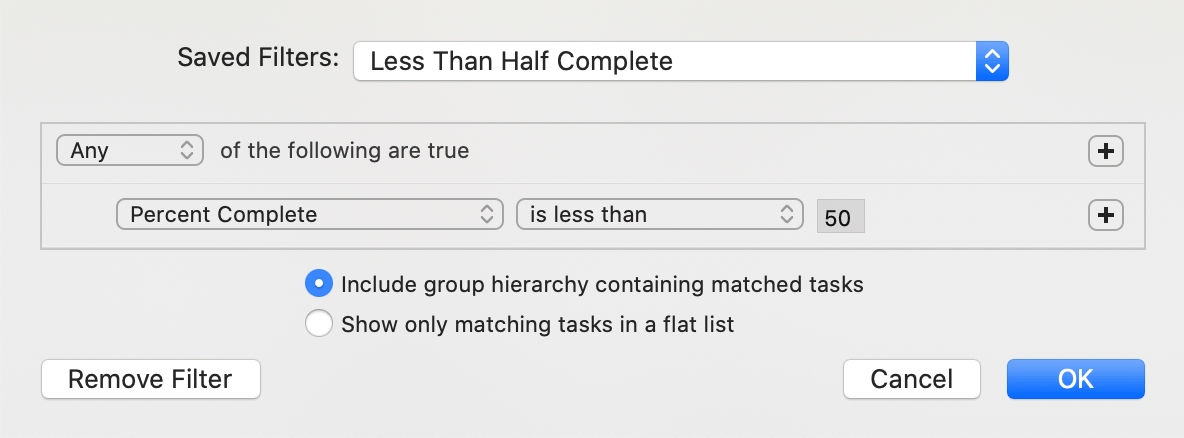
Choose View > Filter Tasks (Option-Command-F), or click the Filter button in the toolbar. A sheet appears for setting up your filtering criteria. You can add as many criteria as you like by clicking the plus icon on the right side of the entry line, and filter the criteria themselves by Option-clicking on the add button to create nested criteria within the filter hierarchy. When your criteria are set up the way you want them, click the Save Filter dropdown menu to save the current filter or restore a previously saved filter. (You can also use the View > Restore Saved Filter menu item.)
When your filter is set, any tasks which match your criteria remain in the outline, while the rest of the project is hidden away. You can work with the project normally while it is filtered, but you can only edit the visible tasks. While your filter is in use the Filter Bar appears, providing options to refresh, edit, or remove the filter and showing the number of tasks hidden.

When you are done, choose View > Remove Filter or click the toolbar button again; all of your tasks reappear, no worse for the wear.
Filter Notes
-
Any tasks created while a filter is in place will not have the filter applied to them by default, so they will appear in the task outline (regardless of whether the filter would hide or show them) until the filter is refreshed or reapplied.
-
If you export or print a project while a filter is on, only the visible tasks are included in the exported file.
Gantt View
Enter Gantt View by clicking the second button in the view switcher in the toolbar, or choosing View > Gantt View (Option-Command-2).


Gantt View consists of two parts: a task outline on the left, and the Gantt chart on the right. The outline provides a space to quickly create, edit, and group related tasks, while the Gantt chart is a visual representation of the project, with built-in tools for editing tasks and the relationships between them.
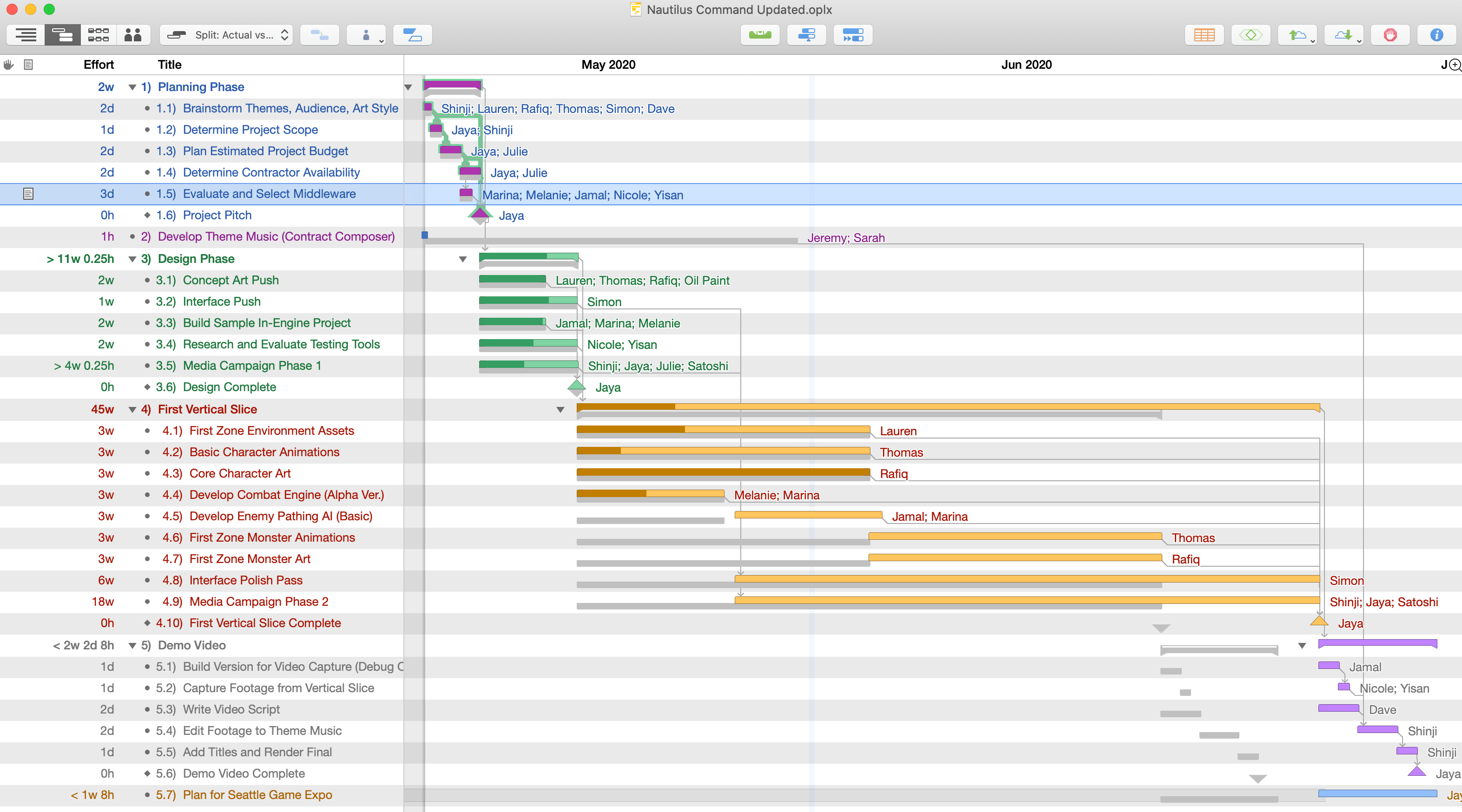

The Gantt View Outline
The outline on the left side of the Gantt View works the same as that in Project Outline View; both outlines display the list of tasks that the project contains, both add tasks in the same way, and both can be customized with your choice of columns independently from one another.
Gantt View Outline Columns
The columns available for display in the Gantt View’s task outline are the same as those available in Project Outline View. See Project Outline Columns for a complete list.
Building Project Structure
Organizing tasks with the tools provided in the Gantt chart, the Task inspector, and menu commands is a fast and effective way of adding shape to your project. By selecting tasks—represented by bars in the chart—and moving them around, or choosing from an array of transformative commands related to task and project structure, you can accurately model the work at hand.
Grouping Tasks
When initially creating a project, tasks can be organized in a flat list with each task a peer of every other. However, it can be useful to group tasks into hierarchical arrangements to better represent their relationships.
Tasks are represented in the Title column by a number that precedes each task. When View > Task Outline > Hierarchical Numbering is selected, tasks at the top of the hierarchy are represented by integers, while tasks at lower levels have points appended to them for each level of hierarchy below the top. The first child of Task 1 will be Task 1.1, the first child of Task 1.1 will be Task 1.1.1, and so on.
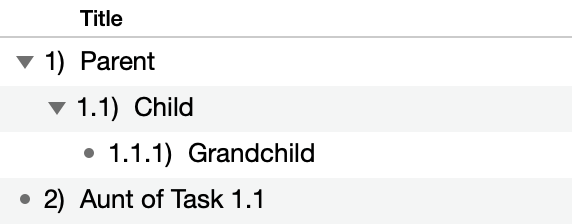
To represent task numbering as a flat list of integers without taking hierarchy into account, choose View > Task Outline > Flat Numbering instead.
When a task gains its first child task it is converted to a group task, and takes properties unique to to the Group task type.
There are a few ways to approach grouping, depending on whether you are starting with an existing set of items you want to add to a group, converting an existing item to a group, or creating a brand new group task.
-
To convert a task to a group with new child tasks inside it:
- Select the item you want to grant sub-tasks.
- Choose Structure > Add > Add Child Task (Command-}).
- The selected item becomes a group with one child task.
- Add more tasks to the group by pressing Return.
-
To bring tasks into a group within a peer task above them in the outline:
- Select the items to be grouped.
- Choose Structure > Indent (Command-]) or Tab, depending on your preference.
- The items become children of the item above them in the outline.
-
To bring tasks into a newly created group:
- Select the items to be grouped.
- Choose Structure > Group (Command-Option-L).
- The selected items become children of a newly created group.
-
To create a new group with nothing inside it:
- Choose Structure > Add > Group.
- A new, empty group item is created.
- To add items inside the group, open it by clicking the disclosure triangle next to the group name (or its bar in the Gantt chart), and with the group selected, create new tasks as normal.
Characteristics of Group Tasks
A group task determines most of its characteristics from the tasks it contains, rather than having characteristics of its own. A group’s characteristics can be viewed (and in some cases defined) in the Task inspector.
- Name—A group task has its own name.
- Type—A group task can contain tasks, milestones, and other groups, but its own type is always group. (An empty group has no effort or duration and can serve as a placeholder.)
- Effort—The effort of a group is the sum of the effort of all tasks it contains.
- Duration—The duration of a group is the amount of time between the beginning of its first task and the end of its last task, not the sum of the durations of all its tasks. If a group contains three one-hour tasks all happening at the same time, the group has a duration of one hour, not three hours.
- Scheduling—A group can have start and end constraints, which can then affect the dates of tasks inside it. Group tasks cannot have manually scheduled start or end dates themselves.
- Dependencies—A group can have dependencies just like a regular task.
- Resource Assignments—If you assign a resource to a group task, the resource gets assigned to all tasks in the group. The group itself can’t have any resources assigned.
Connecting Tasks with Dependencies
When a task must be completed before another can begin, a dependency exists between them. Charting dependencies in your project is a key part of understanding the critical path of tasks that leads through to its successful completion, on time and within budget.
Using the Gantt chart in Gantt View, you can represent the relationships between tasks with dependency lines. A dependency line is drawn from the beginning or end of one task (or group, or milestone) to the beginning or end of another.
When you create a dependency, the dependent task automatically reschedules itself to respect the dependency. With further changes to the schedule and leveling, the tasks continue trying to follow the dependencies. If a dependency becomes impossible or you manually cause a task stop obeying its dependencies, a violation occurs, which can be resolved with the Violations window.
There are a few ways to connect tasks:
- Select two or more tasks in the outline view or the Gantt chart, then click the Connection toolbar button to create a Finish to Start dependency between each subsequent task.
- Select two or more tasks in the task outline or the Gantt chart, then click the triangle in the corner of the Connection button—or click and hold the Connection button—to summon a menu of dependency types; choose the type you want.
- Put the mouse pointer over a task bar in the Gantt chart, then drag one of the arrows that appears at the beginning or end of the bar. It becomes a dependency line, which you can then drop onto the start or end of another task, group, or milestone. Whether you drag from the start or the end of the prerequisite task, and whether you drop onto the start or end of the dependent task, determines the type of dependency.
- In the Dependents or Prerequisites columns of a task, type a dependency or prerequisite code. These codes combine the IDs of the tasks involved and the type of dependency like so:

- A Start to Finish dependency from task ID 1
- A Start to Start dependency from task ID 1
- A Finish to Start dependency from task ID 4.1. (FS is the most common type of dependency, so a task ID by itself without any letters is assumed to be FS.)
- A Finish to Start dependency from task ID 4.2, with a lead time of 1 day.
Recurring Tasks
A recurring task is a task designated to repeat multiple times. This can be useful for planning weekly meetings, restocking inventory, or accounting for quarterly milestones of a project’s progress.
To set a task or milestone as recurring, select it and open the Task inspector. In the Task Info section, open the Type pop-up menu and and choose Make This Task Recur. The task recurrence dialog appears for setting up the properties of the recurring task.
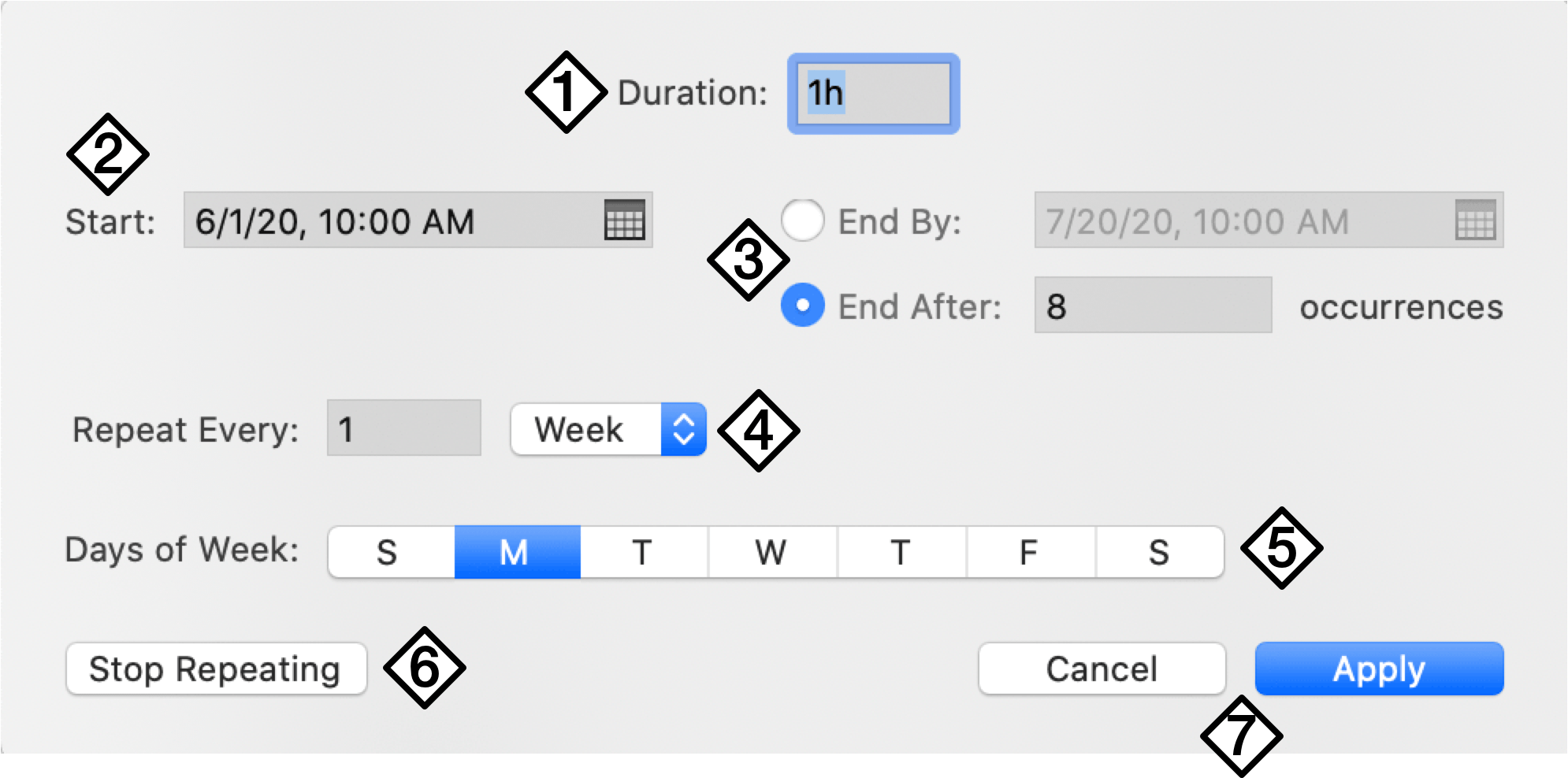
-
Duration—Set a duration for the recurring task.
-
Start—Set a start time for the task. If the first occurrence of the repeat interval would be later than the start time, the start time changes to the first occurrence automatically.
-
End—Choose whether to End By a specific time—scheduling enough occurrences to fill the interval between start and end—or to End After a set number of occurrences.
-
Repeat Interval—Use the popup menu to pick an interval in days, weeks, months, or years, and set a value for how many of the interval elapse between repeats.
-
Interval Details—Use these controls to refine the parameters of the chosen repeat interval. This section changes depending on whether day, week, month, or year is chosen.
-
Stop Repeating—Click to change the task from a recurring task to a regular task or milestone, canceling future occurrences. Only appears when editing an existing recurring task’s recurrence rules.
-
Cancel, Apply—Click to cancel any changes, or to apply them to the task.
After setting up a recurring task, you can subsequently use the Task Info inspector’s Type menu to Edit Recurrence Rules, which opens the dialog to change the recurrence properties of the task, and Stop Recurring, to cancel future planned occurrences of the task.
A recurring task is represented in the task outline and Gantt chart as a group task that contains each instance of the task that is scheduled to occur; this group is shown as rolled up when closed by default.
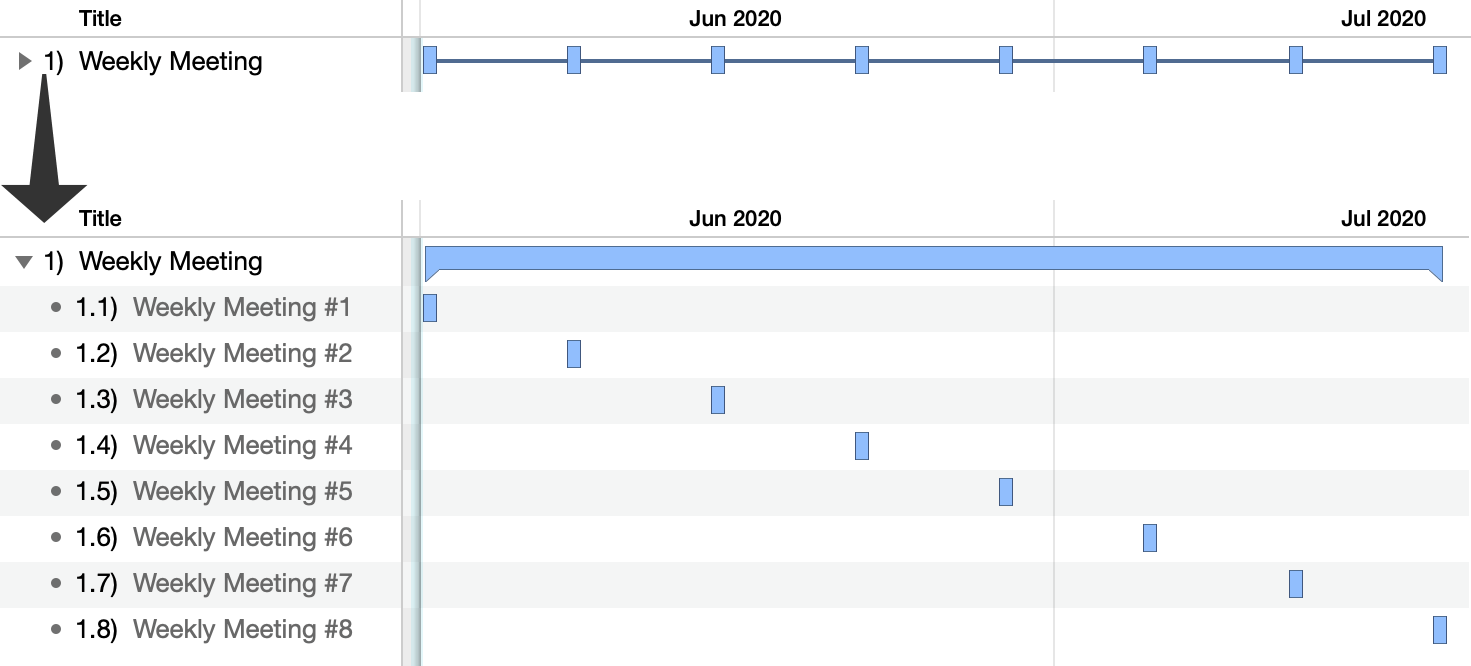
Splitting Tasks
Whether because a key collaborator is on vacation or another part of the project has taken priority, suspending work on a particular task can be very helpful. When you want a resource or team member to devote time to something other than the task they’re currently assigned to, splitting the task into parts around the “time out” period is an ideal solution.
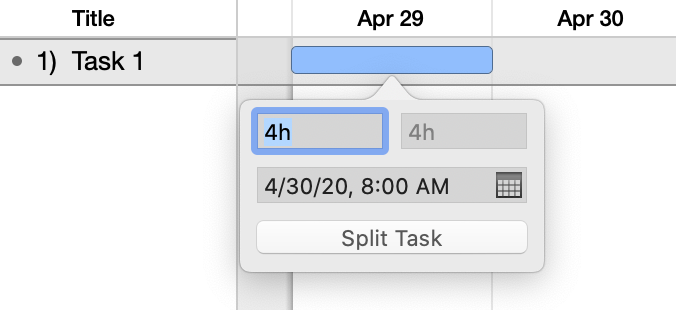
To split a task:
- Select the task in the outline.
- Choose Structure > Split Task (Option-Command-S).
- In the popover, adjust the duration of both sides of the split, choose the date and time you want the task to resume after the break, and click the Split Task button; the task is split for later completion.
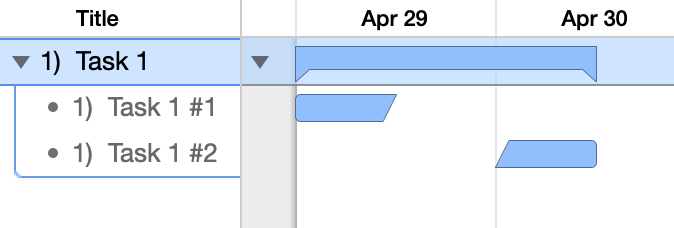
To rejoin a split task, click on one of its parts and drag it to the other. The two segments will merge back into a single task on the Gantt chart.
After splitting a task it’s always a good idea to level to be sure the split is the most efficient way to manage the task at hand given the project’s available resources and time constraints.
A split task may mysteriously re-merge after leveling. If this is not what you want, make sure that Allow Splitting is checked in the leveling dialog.
Creating Hammock Tasks
A hammock task is one in which the duration is dependent on both when the previous task ends, and the next task starts. This type of task is useful when facing a hard deadline and deciding what can be compressed if the project is running behind schedule, or if external factors influence when parts of the project must happen.
For example, if you were to prepare a written document, the time allotted for editing would vary depending on the completion of the document and its due date.
Using that scenario, let’s create an example hammock task. Our starting point is a set of two tasks and a milestone connected by Finish to Start dependencies: Write Newsletter, Edit Newsletter, and Publish Newsletter.

We want to publish the newsletter on June 12th, so we set the Start No Earlier Than date of the milestone to reflect that.

Next, we add a dependency to indicate that editing finishes when publishing starts. Because Publish Newsletter is a milestone rather than a task its start and end dates are equivalent, so this dependency is Finish to Finish (if publishing were a task, this would be a Start to Finish dependency instead).
Because this dependency is directional, for OmniPlan to understand the relationship you’ll want to select the milestone and drag a dependency arrow to the Edit task rather than choosing the dependency type from the Dependencies section of the Task inspector.
After creating this dependency, we delete the unneeded Finish > Start dependency from Edit to Publish to avoid creating a dependency loop.

With our dependencies set up properly, the final step in setting up our hammock task is to select it and choose Hammock as the task type from the Task inspector.

Now, if writing the newsletter takes longer than planned, the duration of the editing task will diminish to respect the needs of the tasks on either side.
Editing in the Gantt Chart
Manipulating items in the Gantt chart directly can be a useful way of maintaining a plan at any given point in its progress. The following sections describe tools for editing changes to the project as work progresses.
Drawing Dependency Lines
To draw dependency lines between one task and another:

- Select a task bar in the Gantt chart to see its dependency arrows.
- Drag a dependency arrow from the beginning or end of one task.
- Drop the arrow onto the beginning or end of another task to create a dependency.
Deleting Dependency Lines
To delete a dependency line between two tasks:
- Select the dependency line by clicking on it.
- Press Delete.
This removes the dependency relationship that the line represents, and the now-unrelated tasks move accordingly.
Drawing Constraints on Tasks
To draw constraints on tasks:

- Hold Shift and drag from the beginning or end of a task to create a start or end constraint.
- Hold Shift and double-click an existing constraint to remove it.
Manually Scheduling Tasks
To manually schedule tasks:
-
Select a task and drag it horizontally from its default position in the timeline.
-
The task is scheduled in its new position, with its scheduling type set to Manual.
Changing Task Duration
To change the duration of a task in the Gantt chart:
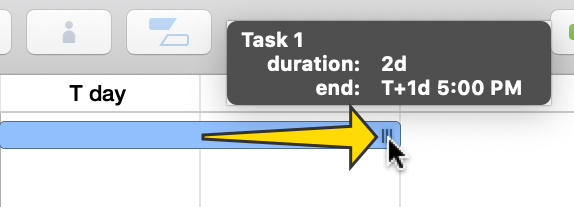
- Click the traction pad at the right end of a task bar.
- Drag the end of the bar left or right to change the task’s duration. You can hold Shift while dragging to snap to round values.
Adjusting Task Completion
To adjust how much of a task has been completed:
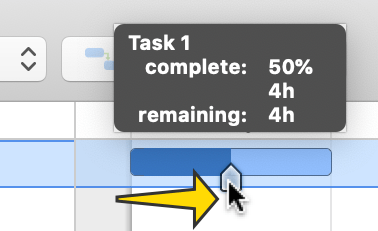
- Click the white, house-shaped handle on a task bar.
- Drag the handle to update the completion.
Updating Task Completion
If everything is going according to plan, click the Catch Up button in the toolbar.

Choose a date and time (today by default), whether to allow tasks to be marked partially complete, and whether to update all tasks or only the selected ones.
When you click OK, the tasks’ completion percentages are updated to the specified date and time.
To mark a task 100% complete, you can use Shift-Option-=. Conversely, Shift-Option-– can be used to mark a task as 0% complete.
Rescheduling Incomplete Tasks
When a task is not as complete as it was scheduled to be, you can use the Reschedule toolbar button to quickly determine the best place for it in the current situation.
Clicking the Reschedule button brings up the following dialog.
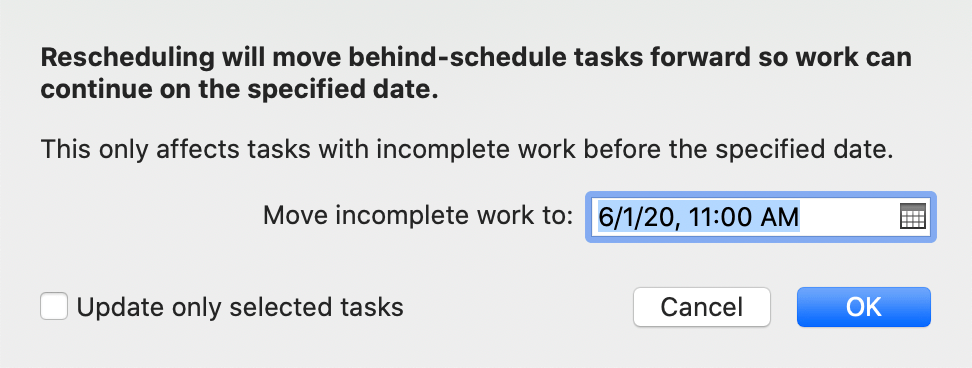
Choose a date and time to reschedule the incomplete tasks, and whether to update all tasks or only the selected ones.
When you click OK the incomplete tasks move—and the whole schedule updates—so that work can continue from here.
Note that this only moves tasks with incomplete work that was scheduled for before the date you specify; tasks in the future aren’t affected.
Visualizing in the Gantt Chart
In order to keep all of the most relevant project data at your fingertips, you can customize the appearance of many elements of the Gantt chart to suit your needs.
Customizing Task Labels
Choose View > Gantt > Customize Task Labels to open the task label editor, with popup menus for label locations relative to tasks, groups, and milestones, as well as interval tracking for rows and the Gantt chart header.
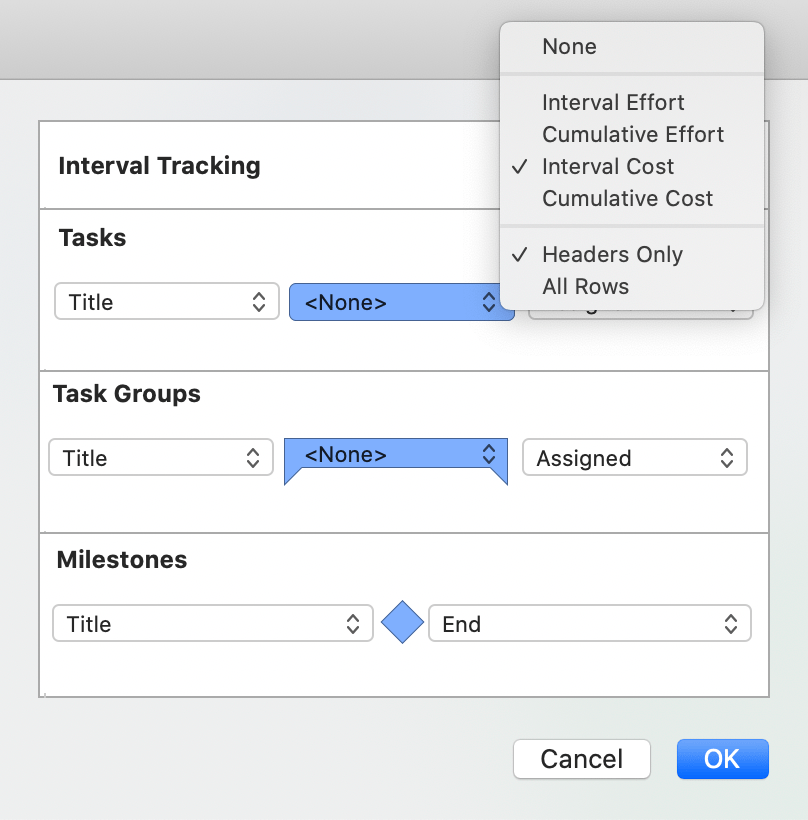
-
Interval Tracking—A representation of either cumulative or intervalic cost or effort. When turned on, the value is displayed either on every row (as a line of text beneath the row’s task bar), or only on the Gantt chart’s date header (as a row beneath the date row).
-
Tasks, Groups, Milestones—Each task type has a set of popup menus that represent areas of the task’s row in the Gantt chart: a prefix area, the task bar itself, and a suffix area after the bar. Use each menu to choose a custom column type to display in that area of the row.
Changing the Chart’s Scale
Change the visible date range in the Gantt chart using the Magnifying Glass menu in the upper-right corner of the chart, or by clicking in the chart’s date header and dragging left or right, as if you were resizing a column.
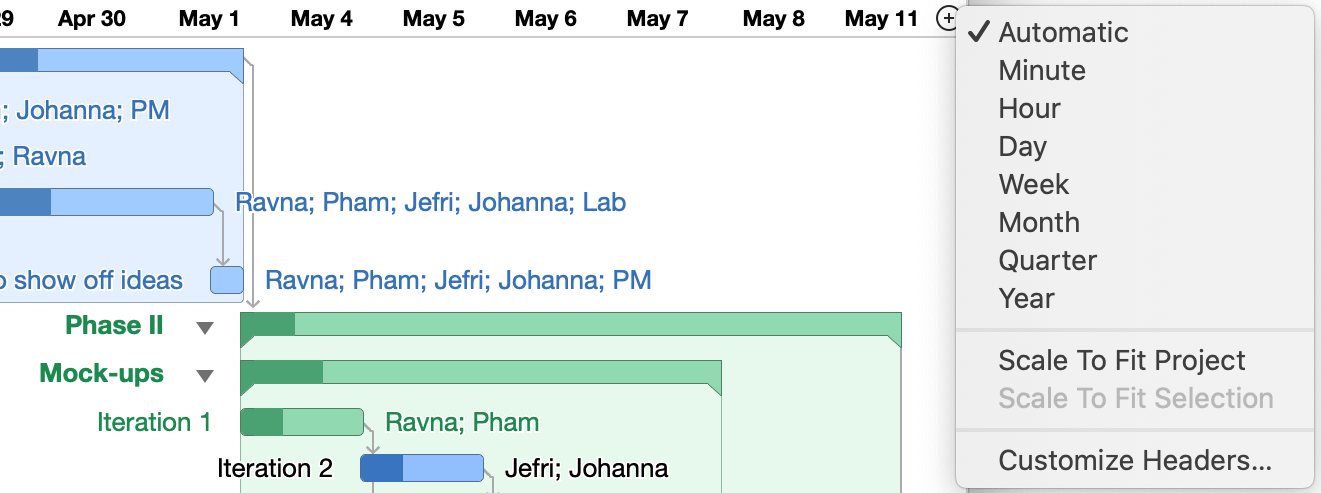
This menu is also available as a contextual menu on the date header, and includes the following commands:
-
Automatic—Scales the viewable area of the project automatically based when the project begins and ends.
-
Specific—Scales the project to increments of minutes, hours, days, weeks, months, quarters, or years.
-
Scale to Fit Project—Scales the project to fit completely inside the Gantt chart’s viewable area.
-
Scale to Fit Selection—Scales the project so the current selection fills the Gantt chart’s viewable area.
-
Customize Headers—Opens OmniPlan’s Display preferences to set up how the date headers appear in the Gantt chart.
Coloring Off Hours
To have the Gantt chart display an alternate background color for days when work is usually not occurring, choose View > Non-Working Time and pick the submenu item applicable to your situation: None, Holidays, Weekends, or All.

Highlighting off hours in this way gives better feel for when work is actually getting done, and helps explain why some bars in the Gantt chart look particularly long when the length of the tasks is not.
You can pick a color for the appearance of off hours in the Styles inspector, and you can customize the hours themselves in Resource View.
Using Critical Paths
Looking at a project or milestone’s critical path is a great way to get a feel for the tasks involved that are most important to on-time completion of the goal. Identifying tasks that are part of the critical path (and vice versa) helps prioritize work to ensure that deadlines are met.

By default, OmniPlan determines the critical path by taking into account the dependency relationships between tasks, and the amount of free time—or slack—there is between them.
-
As the critical path relates to dependencies, for example, an unbroken chain of tasks with Finish > Start dependencies represents a simple critical path to project completion. Tasks that are independent won’t be on the path at all, since they can occur at any time during the project.
-
As the critical path relates to slack, for example, hammock tasks or tasks with a set start date before which other work has been completed can lead to periods in the project where nothing is happening. The length of these periods that determine whether the critical path is affected is set in the Milestones inspector.
One other potential factor affecting critical paths is resource availability. You can choose whether or not to consider it in the display of your critical paths using the Milestones Inspector; that section also contains information on the impact of resource availablility on your critical paths, as does the Schedule section of the Task inspector.
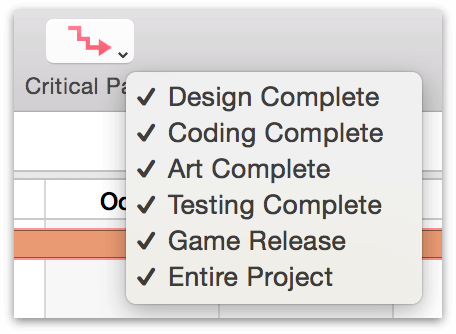
OmniPlan can display critical paths both for the entire project, and for individual milestones. To turn on critical paths, click the Critical Path button in the toolbar; to choose which critical paths to display, click the arrow in the corner of the button and choose the milestones you want, or choose them in Milestones inspector.
Gauging Progress with Baselines
Once you have finished setting up a project and you are ready to start implementing it, you can set a baseline schedule. The baseline represents the original intentions of the project, for comparison with the actual schedule. The actual schedule, by contrast, is the way a project turns out in real life. Before the baseline is set for a project, the baseline and actual schedules are the same. After the baseline is set, further changes affect the actual schedule only.
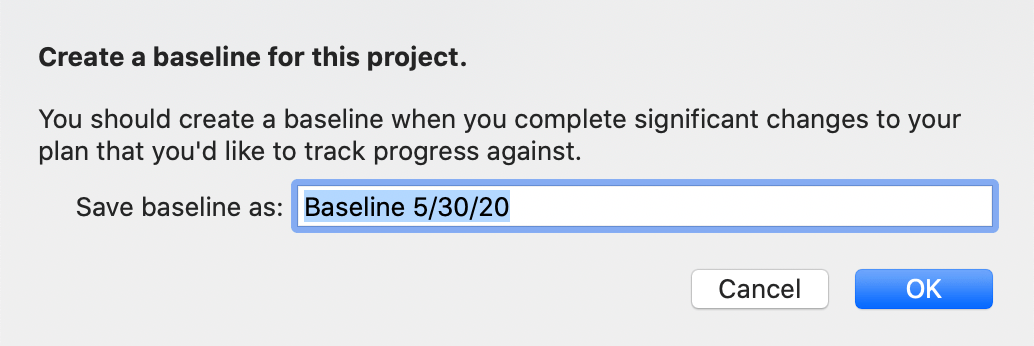
To set a baseline, click the Set Baseline button in the toolbar. You’ll be prompted with a field to name the baseline; the default name is today’s date.
When you click OK, the baseline schedule is set and any further changes are applied to the actual schedule instead.
Choose Split Schedule or Both Schedules to see the baseline and actual schedules together, so you can compare them.
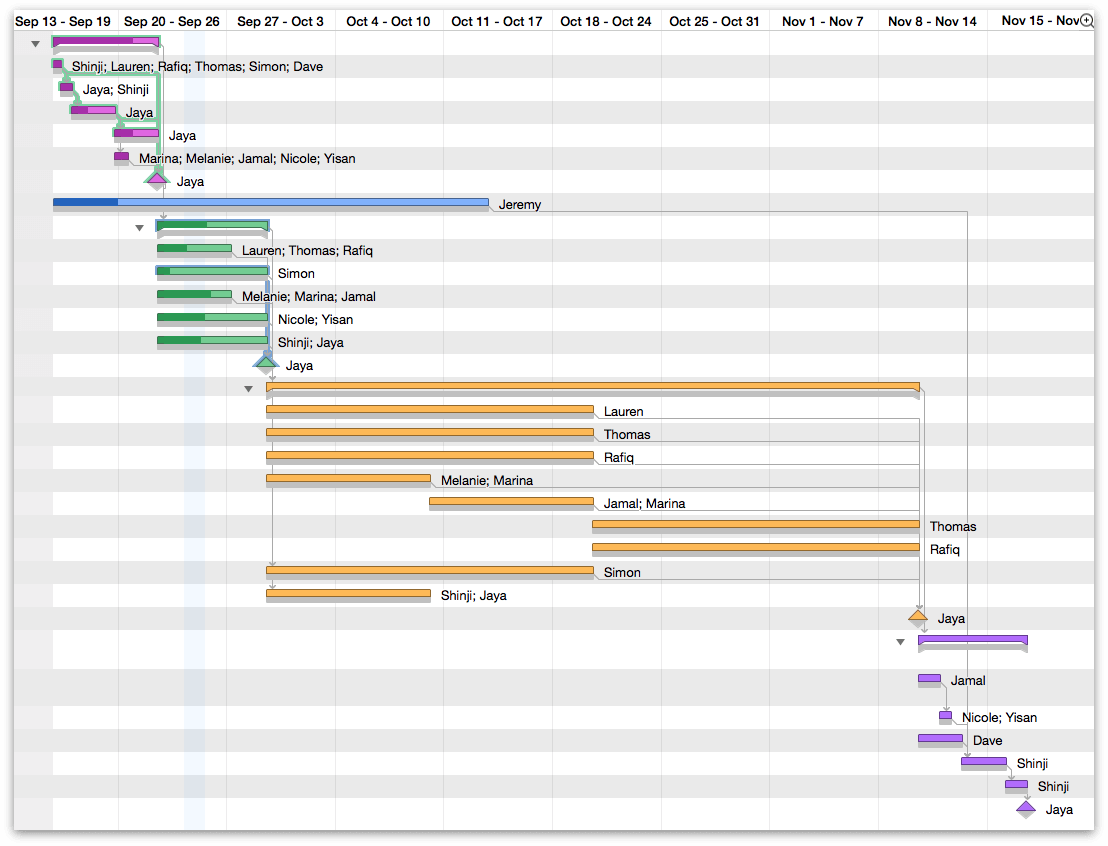
OmniPlan 4 supports as many baselines as you want—so at any given point in the project, you can take a snapshot that sets a new standard from which the actual project can proceed. You can compare a given baseline with the current actual schedule using the Baseline/Actual menu in the toolbar.
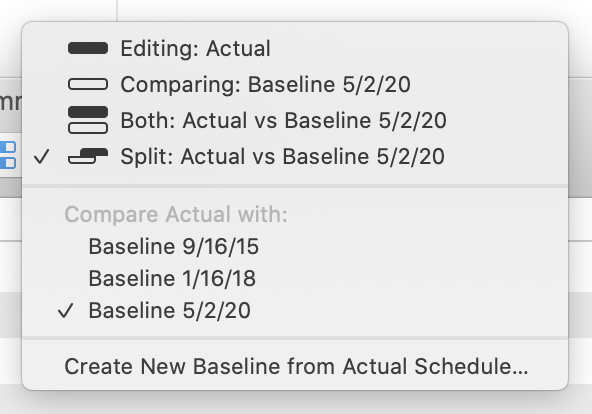
Using Simulations to Estimate Milestone Completion (Pro)
OmniPlan 4 Pro includes tools for calculating the degree of certainty that a milestone will be complete by a given deadline, using Monte Carlo simulations based on estimations of the effort required to reach the goal. The results of these simulations can help identify where things might fall behind (or even be ahead of schedule).
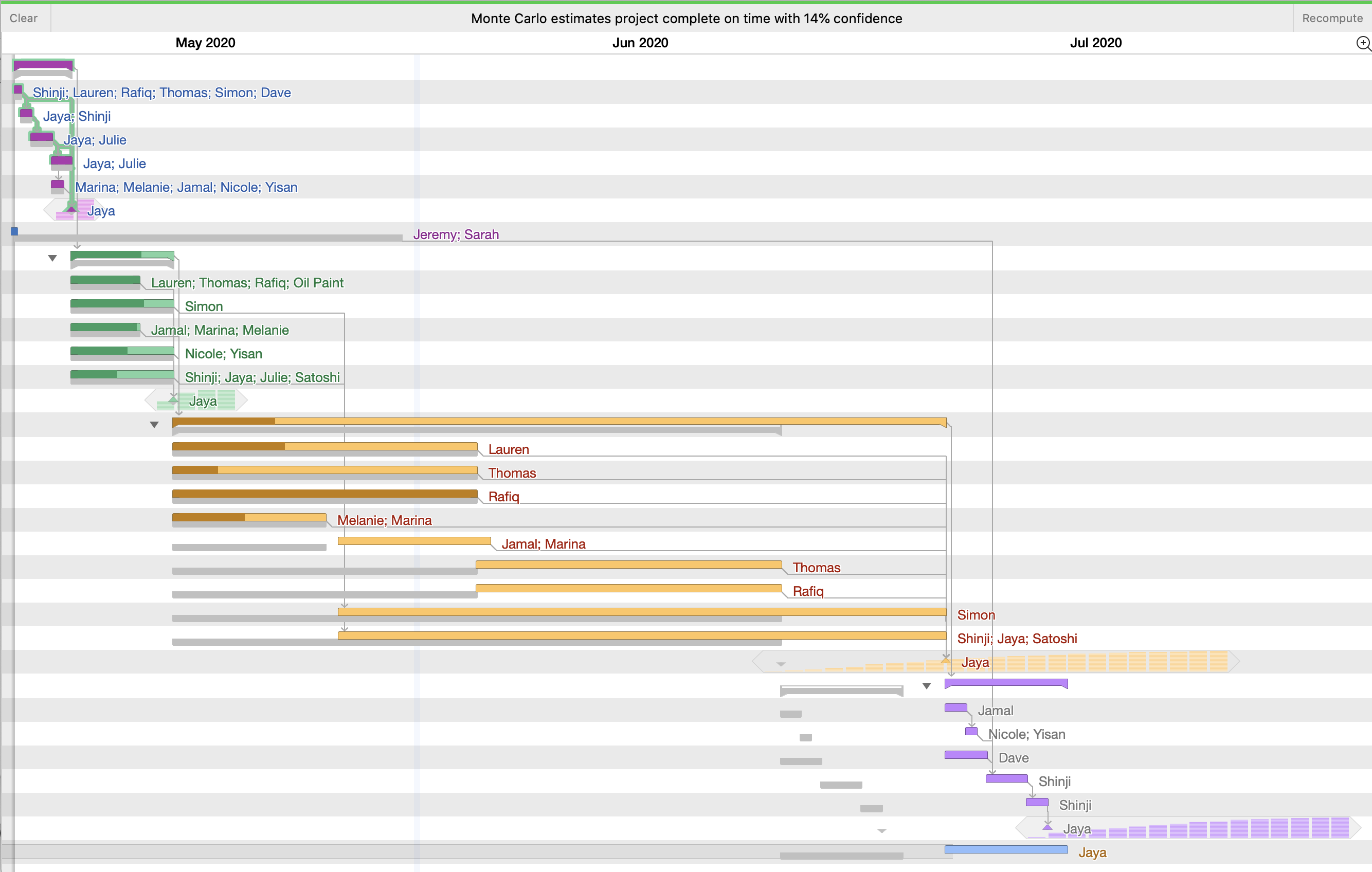
To run a simulation, switch to Gantt View and choose the Simulations button in the toolbar, or choose Project > Run Monte Carlo Simulations. The settings you choose here (and the simulation itself) will affect all tasks and milestones in the project.
The level of certainty the simulation provides is determined by the amount of effort estimated as required for completion of the tasks within each milestone. If you haven’t manually set effort estimates for tasks, you’ll want to either do that, or use the handy Auto-Estimate Effort feature (also found in the Monte Carlo popup menu).
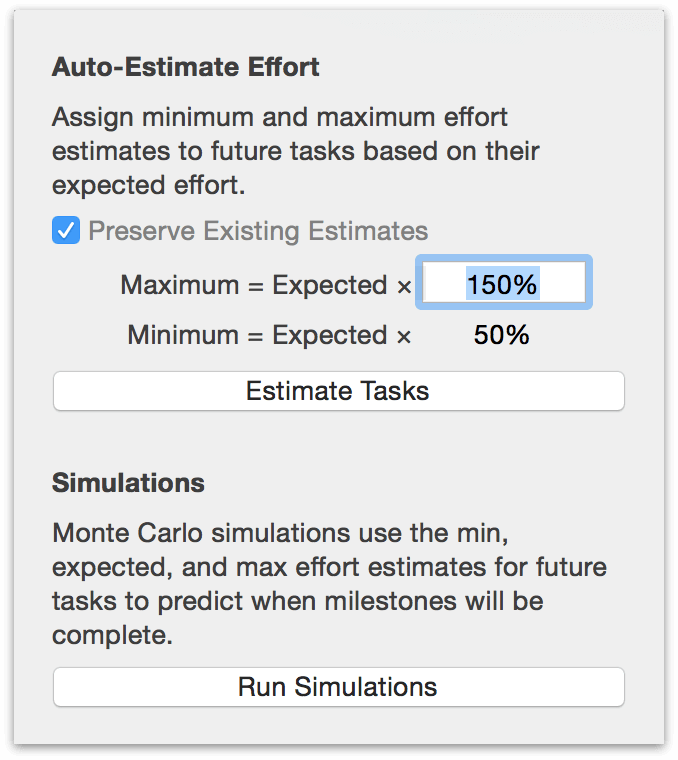
Running a simulation without setting minimum and maximum effort estimates (either manually or automatically) results in a prediction that your milestones will be completed exactly as they’re scheduled, 100% of the time. Not very useful, right? For best results, be sure to have a spread of possible efforts included (auto-estimating effort makes this easy).
Once the simulation is complete, a set of horizontal bars appears on days surrounding each milestone (represented as a small diamond); one bar equals 20 percent confidence that the milestone will be complete on that day (5 bars on a day means that according to the simulation, a milestone is 100% likely to be completed on that day). Hover over the bars on each day for greater detail.

Network View
Enter Network View by clicking the third button in the view switcher in the toolbar, or choosing View > Network View (Option-Command-3).


Network View provides a canvas that displays your project as a diagram of nodes (tasks) with lines (dependencies) connecting them. Evocative of charts generated with the PERT technique, Network View not only offers a new perspective on your current projects but also allows rapid development of new ones.
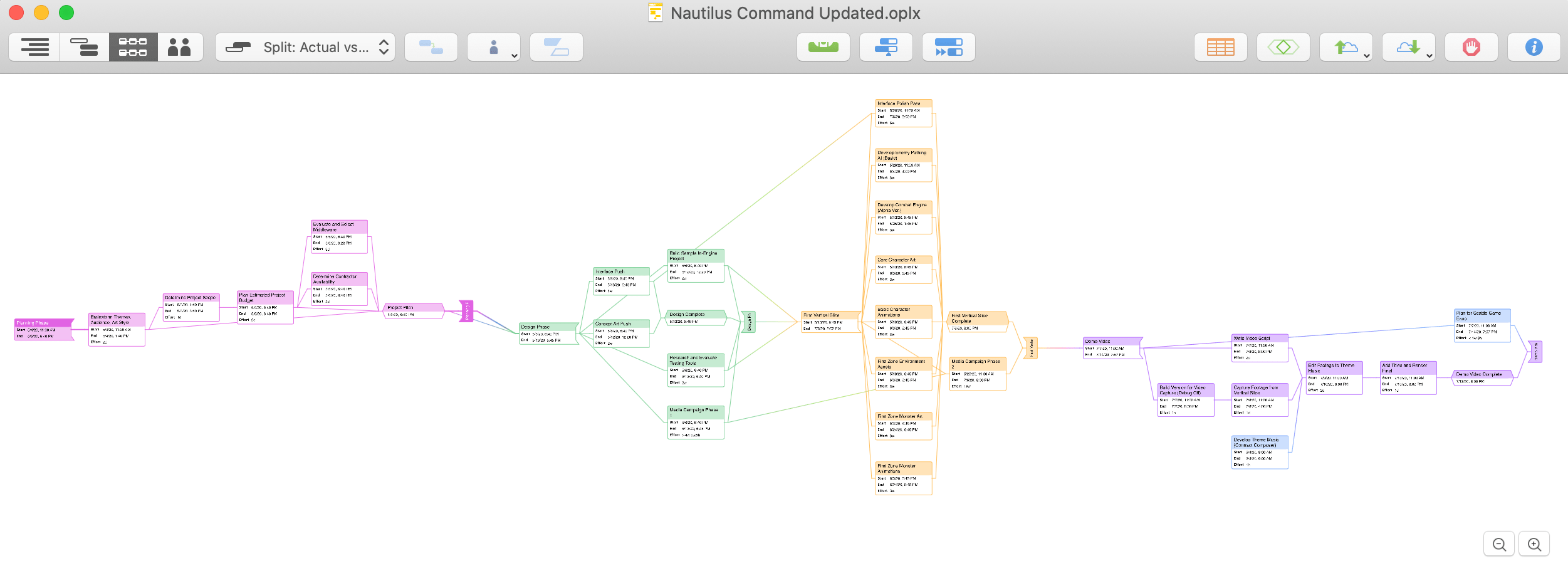

Charting Tasks and Dependencies
When you are ready to start building (or adding to) a project in Network View, press Option-Command-3 to switch to Network View and then press Return. That’s it! A new task is created.
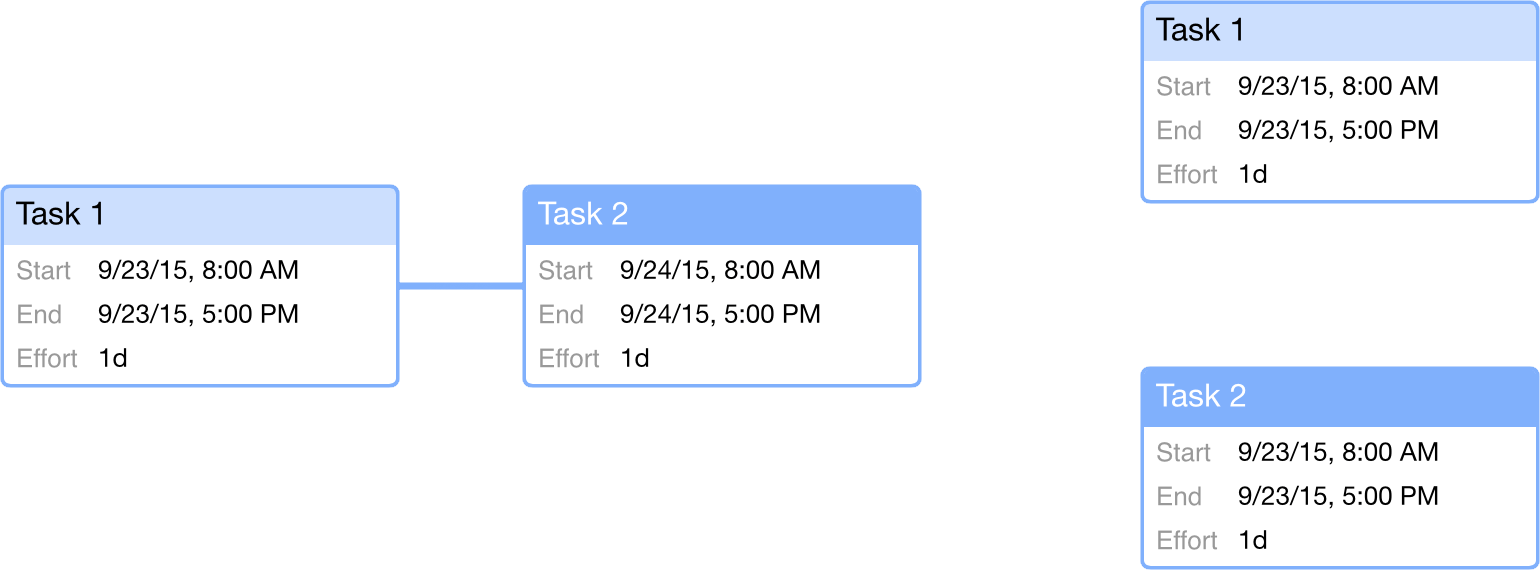
If you had a task selected previously, the new task will be connected to it by a line that represents a Finish→Start dependency. If no tasks were selected, the newly created task is independent of any others. As long as a task is selected, you can quickly create a chain of tasks connected with Finish→Start dependencies by continuing to press Return.

An unbroken chain of tasks with Finish→Start dependencies is arrayed in a straight horizontal line.
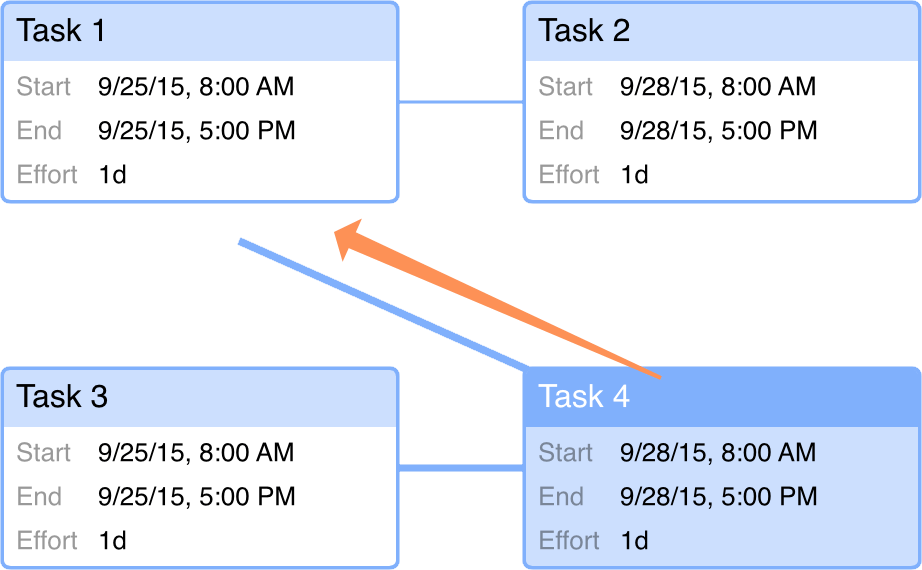
To create other dependency relationships, click a task node to select it and drag the line that appears to another task. This creates a dependency between them, and you’ll see the tasks rearrange in the diagram automatically to reflect this new relationship.
At any time while working in Network View, you can switch to Gantt View to see how your project-building exercise is looking in the Gantt chart and see how its dependencies are described there.
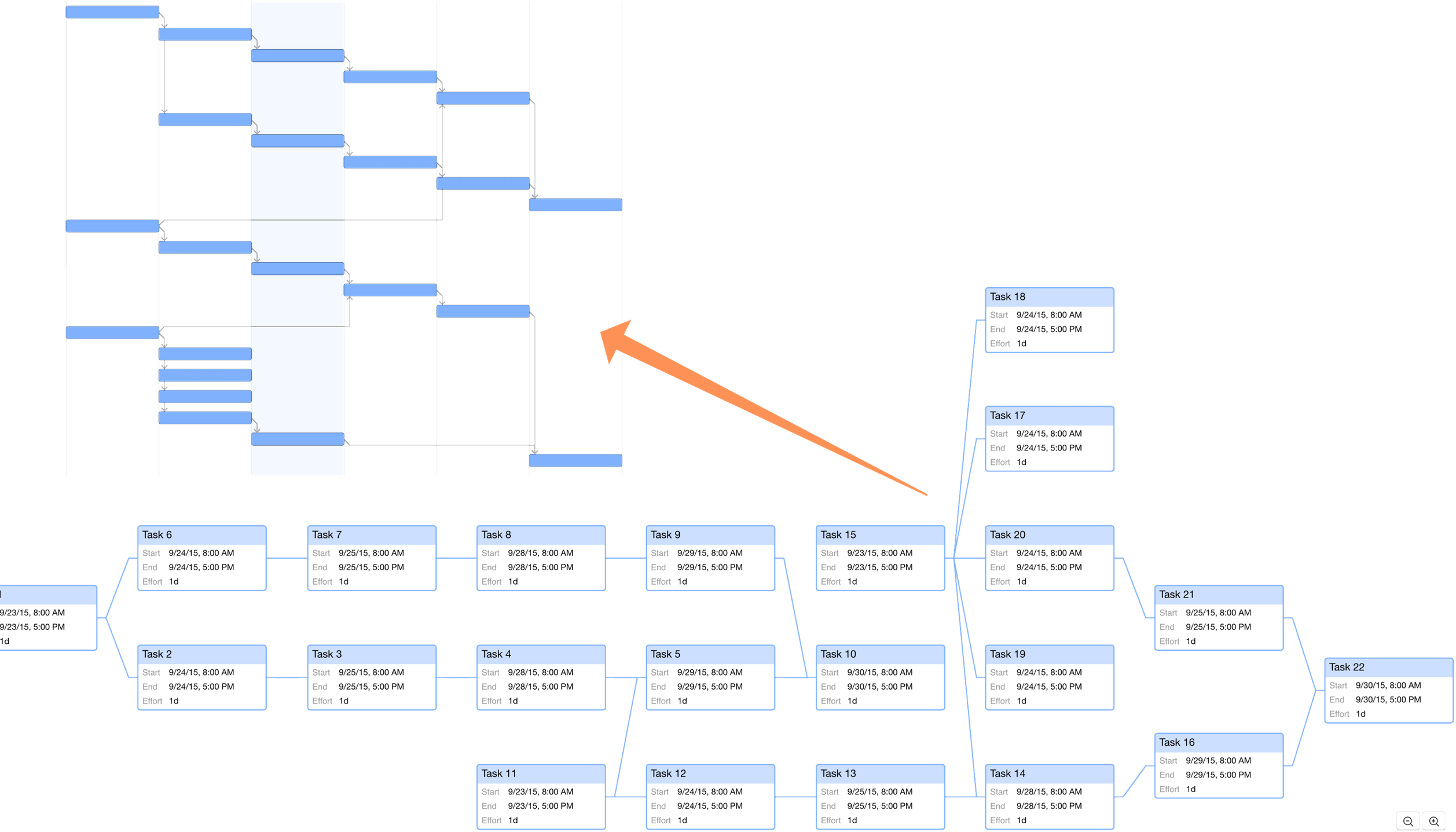
When you are working on a project of considerable size, you can zoom in and out on your network diagram using the buttons in the lower-right corner of the view, or with - and + on the keyboard.
To apply colors to items in Network View, you can set up document and Gantt styles in the Styles inspector that will carry over to tasks in the network diagram, or apply individual styles to tasks or groups in Gantt View that will likewise carry over.
Configuring Network View
Collapsing and Expanding Groups
When you have a complex network diagram with multiple task groups, it can be useful simplify the project appearance by hiding tasks within those groups.
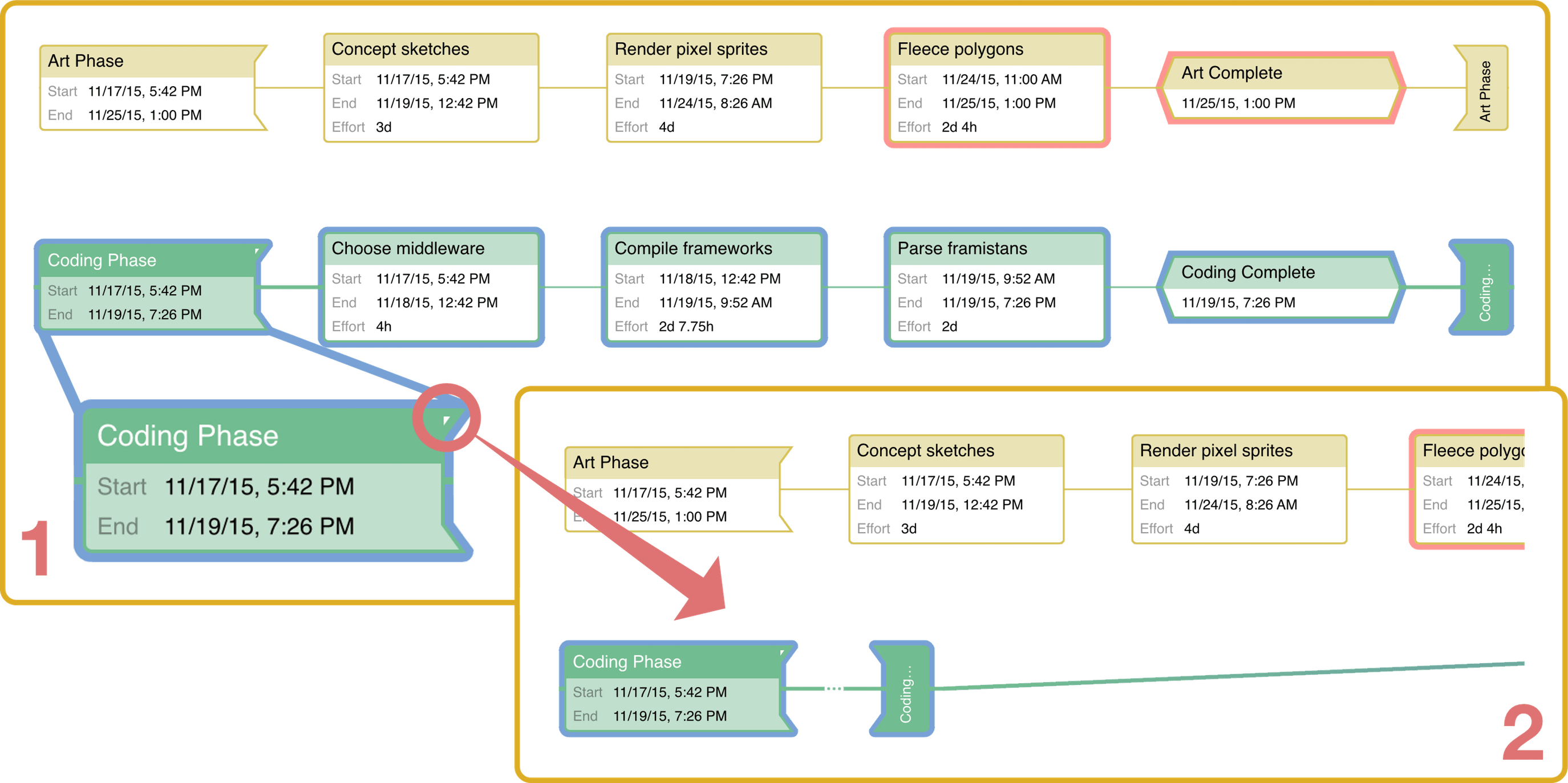
To collapse a group and hide the tasks inside:
-
Move your cursor over the group task (represented in the network diagram by a node shaped like an open bracket). A tab appears on the upper-right corner of the task.
-
Click the tab, and the group collapses. The group task is shown as a set of brackets with an ellipsis between them, indicating that the tasks within the group are hidden.
-
Click the tab at the corner of the group again to expand it, and the tasks return to view within the group brackets.
Zooming
If the size of the project diagram exceeds the viewable area on screen, or text on the nodes is too small to easily read, you can use the zoom buttons in the lower right to increase or decrease the diagram scale.
Customizing Node Metadata
If you would like to show values on task nodes other than the default, you can fully customize them using custom task labels. Choose View > Network Diagram > Customize Task Labels to open the task label editor with three primary tasks types available for editing—Tasks, Milestones, and Groups.
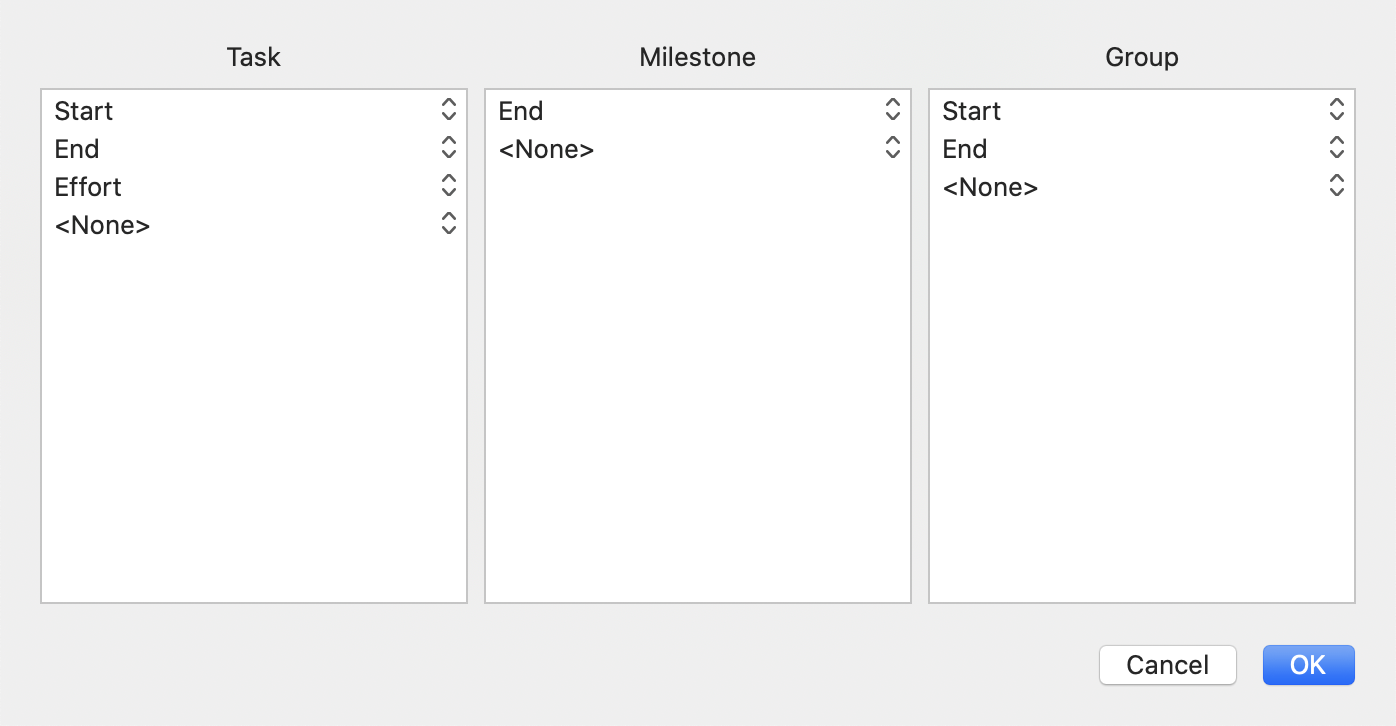
Choose a column type from the popup menu to add it to nodes of the selected task type, or choose None to remove that metadata row from display.
Resource View
Enter Resource View by clicking the fourth button in the view switcher in the toolbar, or choosing View > Resource View (Option-Command-4).

Use this view to add and manage staff, equipment, and materials. As with Gantt View, Resource View is split into two parts: the resource list for adding, grouping, and managing resources, and a timeline that shows the same tasks as Gantt View—divided here by resource assignment instead of chronology or dependency structure, with drag-and-drop control to quickly assign resources to tasks (and vice versa).
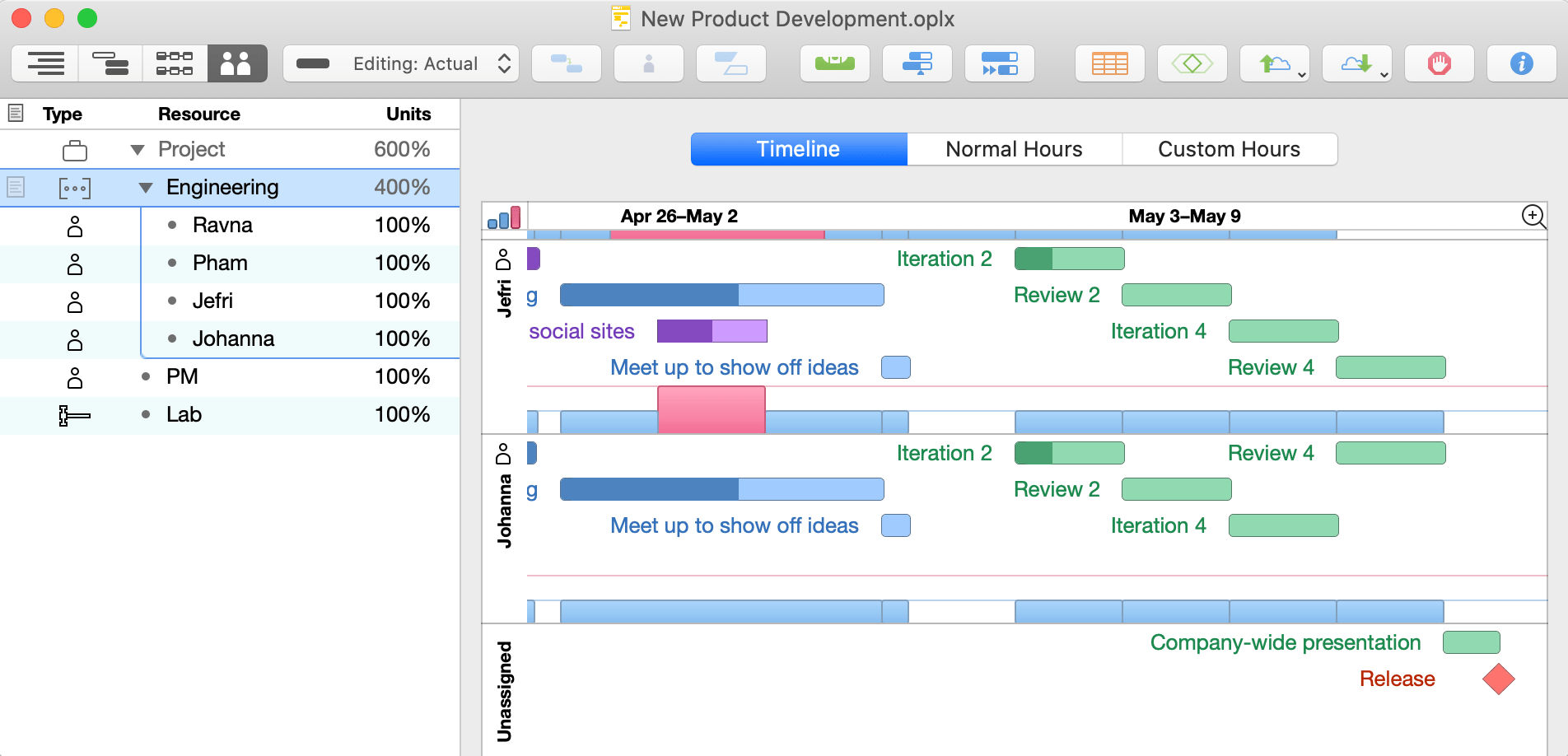

This view also includes a calendar for editing working hours, broken down into two modes: editing for Normal Hours, and Custom Hours. In Normal Hours you’ll edit the regular working hours for both the whole project and individual staff members. Use the Custom Hours to add isolated changes to the schedule such as vacations and planned time off.
The Resource List
The outline in Resource View contains a list of the resources available to the project. As with the task outline in Project Outline View, the list is organized into rows and columns, with each row representing a resource (or group) and each column containing a certain type of information related to that resource.
Creating and Deleting Resources
A key part of building out your project is describing the resources that make up the team you are working with, and the equipment and materials they’ll be using to get the job done. The resource list is a quick and efficient way to do this.
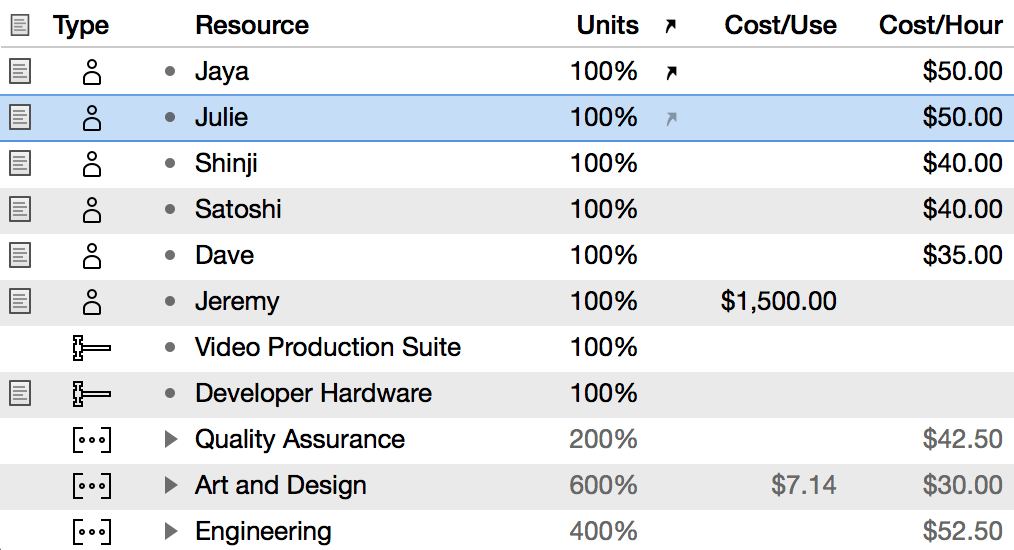
There are several ways to create new items in Resource View:
- Select an item in the resource list and press Return (or Command-Return, depending on the Keyboard Options in OmniPlan’s General Preferences).
- Click the Add button in the toolbar above the outline.
- Drag a macOS Contacts card into the resource list to create a Staff resource with that contact information.
- Control-click and choose Add > Resource from the contextual menu.
There are a few ways to delete a resource or resource group:
- Select a resource or group in the outline, then press the Delete key.
- Select the item, then click the Remove button in the toolbar above the outline.
- Select the item, then Control-click to reveal the contextual menu and choose Delete.
Resource Types
An understanding of the various resource types available in OminPlan is useful when working in Resource View.
Staff 
The most important resources on a project are likely the people responsible for its execution. These are represented by Staff resources in OmniPlan. As unique humans, each staff member is represented by an email address that identifies them across all projects they may be a part of.
Equipment 
Tools, machinery, computers, and other hardware used to complete a project are represented as Equipment resources in OmniPlan. Equipment are similar to staff in many respects, but lack a notion of unique identity.
Material 
Ingredients, building supplies, food, or other components expended in the process of executing the project are represented as Material resources in OmniPlan. Unlike staff and equipment resources, materials dedicated to tasks are consumed upon use and are therefore represented by a number of units required.
Group 
A Group is not a resource itself. Instead, it’s a way to gather other resources under the same umbrella, indicating that (for example) a number of staff are part of the same team.
Grouping resources is accomplished similarly to grouping tasks.
Assigning Groups
If you assign a resource to a group of tasks, the resource is assigned to every task in the group. The group task itself cannot have a resource assigned to it.
If you assign a group of resources to a task, OmniPlan provisionally labels the task as having the whole resource group assigned. Then, when you level resources, one member of the group is chosen to work on that task. If that member becomes unavailable, leveling again assigns a different member.
Characteristics of Resource Groups
A resource group is a container to organize several resources together, so it doesn’t have a lot of the same characteristics as an individual resource, like Efficiency and Cost.
-
Name—Of course, a resource group has its own name.
-
Email—You can assign an e-mail address to a group, in case you have a mailing list or some address which goes to all of the members in the group.
-
Type—A resource group can contain resources of any type (Staff, Equipment, or Material), but its own type is always Group.
-
Cost/Use, Cost/Hour, and Efficiency—These are shown as averages of the values of all members of the group. If you enter a new value, it is applied to all members of the group.
Resource List Columns
As with the task outlines in Project Outline View and Gantt View, you can customize the outline in Resource View to display a set of columns with data specifically relevant to your project. Control-click the outline header or choose View > Resource List > Customize Columns to choose which columns to display.
If you would like to add columns to the resource list that aren’t part of the built-in metadata set (or if you are seeing unexpected entries there), note that key/value pairs you set up for resources using the Custom Data inspector are added to the list as custom column types.
The following columns represent properties of resources that can be included for display in the outline.
Attachments
Click the arrow icon in the selected row to see a menu of the item’s linked files, or to link to a file if there is not one linked yet. Rows with links to files show an icon even when they are deselected.
Notes
Click the note icon in the selected row to show or hide the item’s note, or to create a note if there is not one yet. Rows with notes show a note icon even when they are deselected.
Unique ID
The unique ID is a number assigned to each resource to identify it unambiguously, even if its name or position in the outline changes. A unique ID won’t ever change, and each new task or resource you create gets a new unique ID number. These numbers are useful for matching up items when you are importing and exporting projects between OmniPlan and other applications.
Resource
The resource name, which can be edited here or in the Resource Info inspector.
Units
The Units column has different attributes depending on the type of resource:
-
Staff, Equipment—The amount of a resource’s effort available to the project, expressed as a percentage. This can be edited here or in the Resource Info inspector.
-
Material—The number of times a resource is used throughout the project. This is equal to the sum of the units assigned to tasks in the project, and cannot be edited directly here.
A material resource is assigned to a task with one unit used by default. To edit the number of units used by the task, select the task in the Resource Assignments inspector or the resource in the Task Assigned Resources inspector and double-click on the Units field. Changes made here are reflected in the total units count in the Units column and the Resource Info inspector.
Efficiency
The amount of effort-per-time that a staff or equipment resource can produce, expressed as a percentage. A resource that operates at 50% efficiency (a new employee in training, for example) takes two hours to complete an hour’s worth of effort.
Cost/Use
The flat monetary cost incurred each time a resource is assigned to a task in the project, or (in the case of material resources) for each unit of the resource expended.
Cost/Hour
The monetary cost per hour of effort that the resource spends working on the project.
Total Cost
The sum of the resource’s use costs and hourly costs. This value cannot be edited directly.
Total Hours
The sum of the hours of effort that the resource is assigned throughout the project. This value cannot be edited directly.
Total Uses
The number of times the resource is assigned to a task throughout the project, or (in the case of material resources) the total number of units used by the project.
Type
The resource type. Click the type icon and choose the type from among Staff, Equipment, Material, or Group.
Custom Work Week
An icon appears in this column if a resource has a work week that differs from its default work week; the default work week for a resource is defined by its parent (if it’s a member of a group) or the project (if it’s not). You can click the icon to see the resource’s work week.
Schedule Exception
An icon appears in this column if a resource has a work schedule that differs from its work week, such as when someone goes on vacation. You can click the icon to see the resource’s work schedule, and from there you can check the orange-highlighted dates to see where its exceptions are.
The Resource Timeline
When you want to manage your project from the point of view of the resources available, the timeline in Resource View will help you visualize and control your assets.
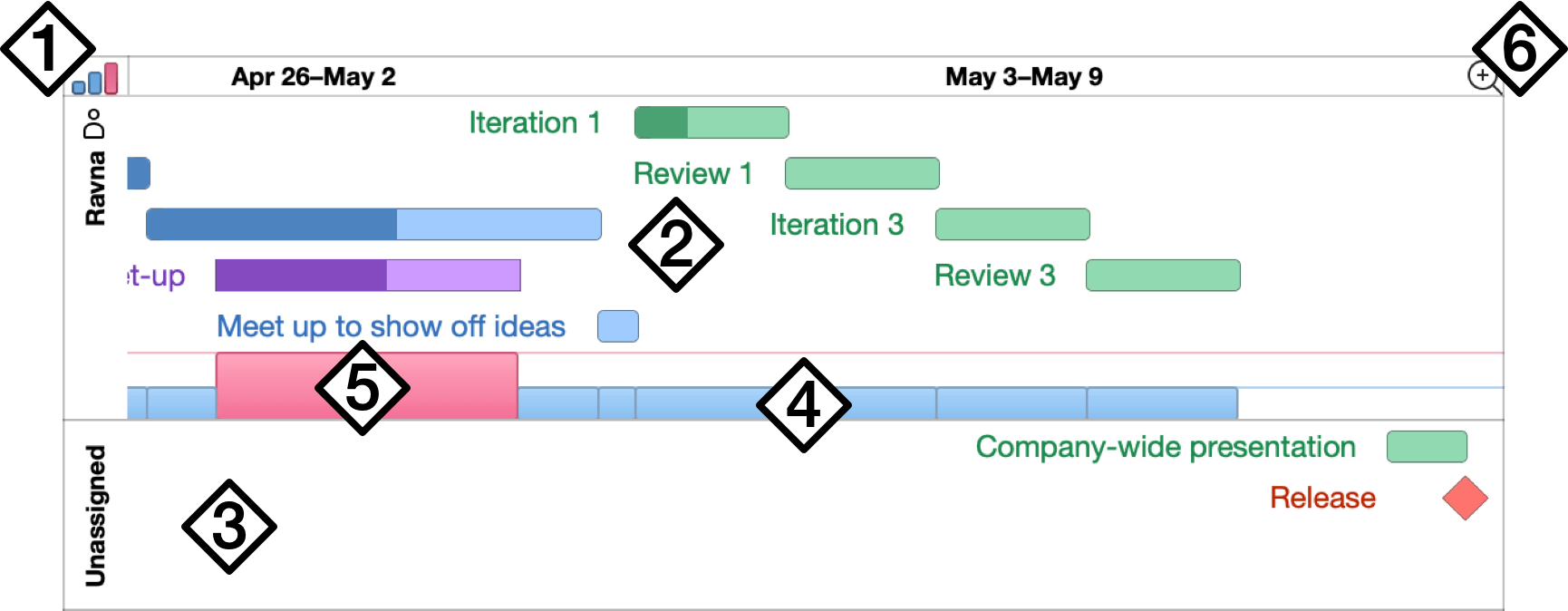
-
Click the bar graph button to show or hide the load graph beneath each resource’s timeline.
-
The chart shows a timeline of tasks for each resource you select in the outline. If you select no resources, the chart shows all resources’ timelines. If the resource is unavailable during normal working hours (because it has customized time off), the unavailable times have a background of the off-hours color as it is set in the Styles inspector.
-
Below the resources’ timelines, an Unassigned timeline shows the tasks which aren’t assigned to any resource. You can drag tasks between timelines to change their assignments.
-
A blue bar in the load graph represents time when the resource is being used at 100% of its available units.
-
A pink bar in the load graph represents time when the resource is being used at over 100% of its available units. You can level the project to alleviate this.
-
You can change the visible date range and date headers in the timeline the same way you do in the Gantt chart. Choose a scale from the magnifying glass menu here, or click and drag in the date header area.
Customizing Timeline Task Labels
As with the Gantt chart, you can track intervalic and cumulative information and and display labels on tasks in the Resource View’s timeline with the column data of your choosing. Choose View > Timeline > Customize Task Labels to open the task label editor specific to the resource timeline.
Scheduling Normal Hours
Setting up the calendar for a project involves two components: the Normal Hours for the project and individual resources, which represent the standard work week, and Custom Hours, which represent exceptions to the normal schedule.
In Normal Hours mode you can edit the working calendar for the whole project (when no resources are selected), as well as the regular working hours for individual staff members (by selecting them in the outline). Normal working hours are represented by green blocks in the calendar.
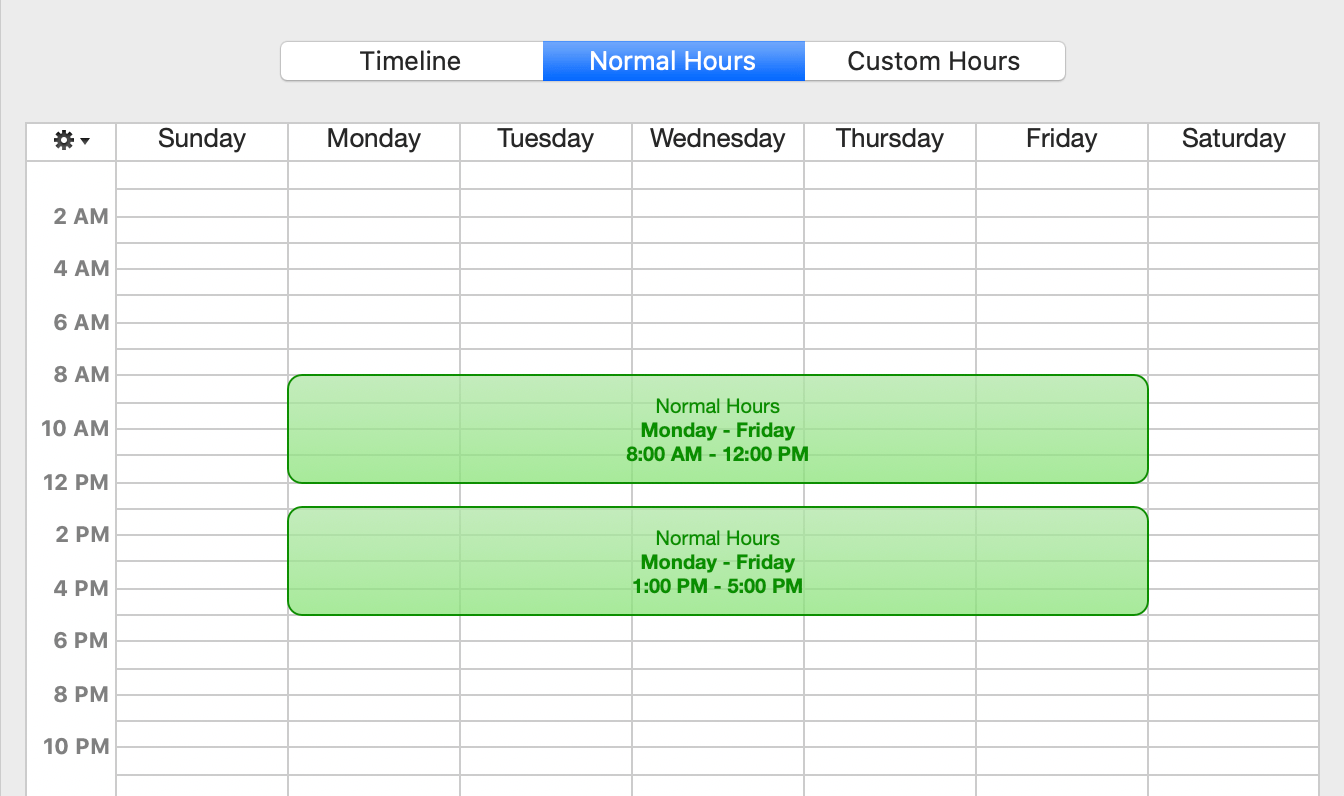
The Normal Hours are a general set of working hours to be followed in a typical week. This set of hours is applied to every week in the project, thus determining how many hours of effort can be completed in each day.
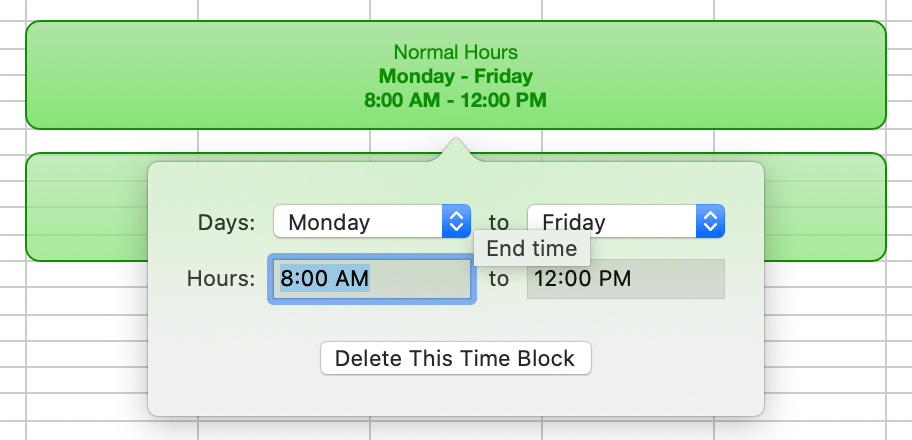
The green blocks represent segments of working time. You can drag the edges of a block to set a day and time range. Click a block to select it; you can then press the arrow keys to move it, or press Delete to remove it.
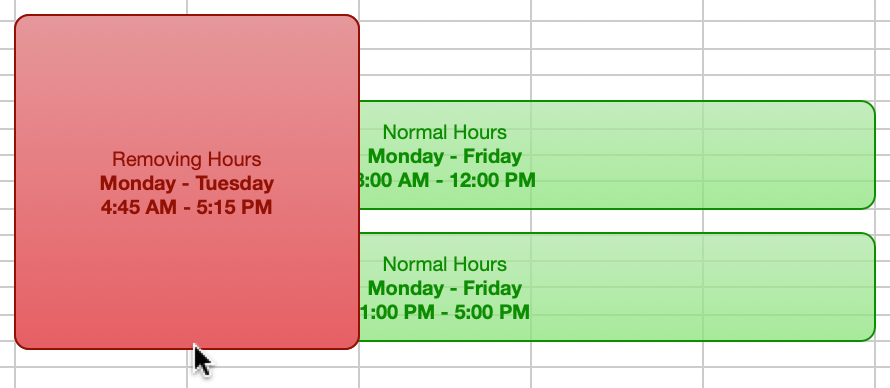
Drag or double-click in an empty area to create a new time block, and Shift-drag anywhere to draw a red block that erases working hours. These techniques are useful for breaking up blocks that span several days, so that you can adjust them individually.
When you create normal working hours for a project, you are describing the calendar of work time that happens in a typical week for purposes of resource assignment.
However, when times are displayed throughout OmniPlan (the amount of effort remaining on a task, for example), they are calculated based on the the week length established in the Effort Unit Conversions section of the Project inspector.
For example, if your work week is six days of seven hours each, tasks displayed in the Gantt chart will appear to register inaccurate times unless you change the value of a work day to 7 hours and a work week to 42 hours.
Setting Up Normal Hours for a Resource
Resources inherit their work week schedules from the project, but you can customize them individually by selecting them in the outline. (If nothing is selected, you will edit the working hours for the whole project instead.)
As with the project as a whole, the working hours for an individual resource are represented by green blocks in the calendar, and can be edited with the same tools used to edit the normal project hours.
If a resource’s work week is customized from the whole project’s normal work week, the Custom Work Week icon ![]() appears in the Custom Work Week column; click it to view the customized work week of the selected resource.
appears in the Custom Work Week column; click it to view the customized work week of the selected resource.
Scheduling Custom Hours
The Custom Hours are a calendar of the working hours for specific days. You can set up holidays, half-days, overtime, and other such exceptions to the normal work week. Like the normal work week, there is a custom schedule for the whole project which resources inherit by default, but you can also customize resource schedules individually.
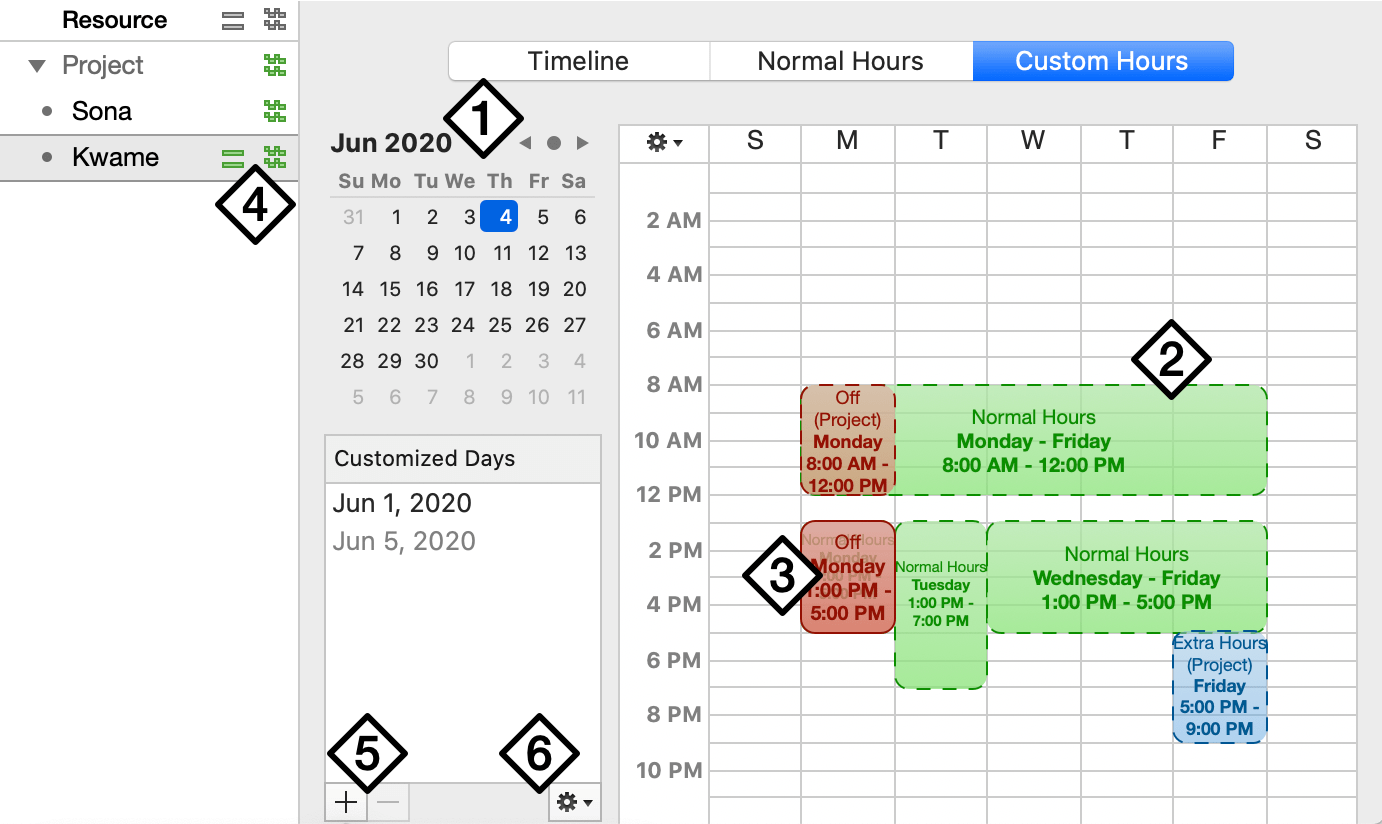
-
Navigate through upcoming weeks and months using the mini calendar. Click the arrows to move between months; Option-click to move a year at a time.
-
The normal work week appears with a green dotted border, so you can see how this week’s schedule differs as you begin to make changes.
-
As when editing the normal hours for the project, drag or double-click in an empty area to create a new block of working time. Shift-drag anywhere to draw a red block that represents time that is unavailable for work.
-
A resource with upcoming custom hours is flagged with
 in the Schedule Exception column; clicking the icon brings you to the schedule change in question.
in the Schedule Exception column; clicking the icon brings you to the schedule change in question. -
You can add custom calendar exceptions to either the project or a selected resource by clicking the Plus button beneath the Customized Days list, which opens a menu for designating extra work hours, off hours, or entire off days.
-
When viewing the custom hours for an individual resource, use the Gear menu beneath the Customized Days list to show or hide inherited custom dates (dates that are a part of the project’s custom hours schedule). Inherited dates appear as grey entries in the list.
With OmniPlan Pro, if the project is subscribing to a calendar, hours imported from the calendar are represented by blocks in the custom hours calendar that are outlined with dotted borders, indicating that they cannot be directly edited here.
The Project Inspector
The Project inspector holds tools related to attributes of the project as a whole, including summary information and details about the project’s structure and chronological flow.

Title
Use the Title field at the top of the inspector to set the name or title of your project. By default the project title is the same as the document name, but it doesn’t have to be; changing the project title doesn’t rename the document, and vice versa.

The project title is used when generating reports with OmniPlan Pro.
Timeline
Use the Timeline inspector to set the project direction and dates for scheduling project tasks.
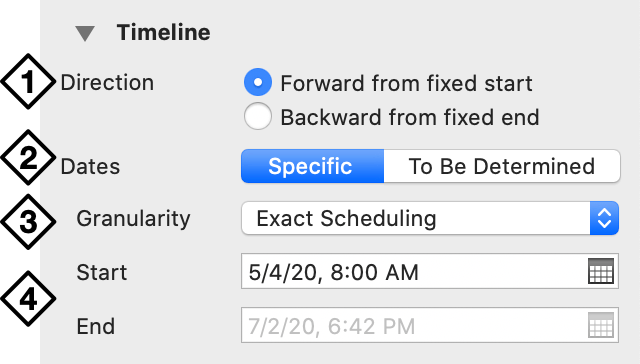
- Direction—Choose whether the project is scheduled forward from a fixed start, with tasks scheduled as soon as possible, or backward from a fixed end, with tasks scheduled as late as possible.
- Dates—Choose whether project dates are specific or to be determined. Until a project uses specific dates, dates in date headers are expressed as T day (the present day), T+1d, T+2d, and so on.
- Granularity—Choose whether tasks are scheduled exactly down to the minute, rounded to the nearest hour, or the nearest day.
- Start Date, End Date—For projects with specific dates, enter the project start date (for projects with fixed start dates) or the project end date (for projects with fixed end dates).
Summary
Use the Summary inspector to view collected information about the project that is gathered as totals from the tasks within the project. Values in this inspector cannot be edited directly.
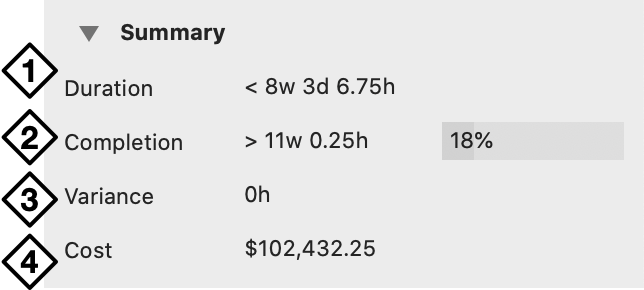
- Duration—The total projected duration for the project.
- Completion—The total completion percentage for the project, calculated as a sum of the total effort completed compared to the total effort required for the project to finish.
- Variance—If a baseline has been set, displays the project’s actual end date’s deviation from the end date in the currently selected baseline.
- Cost: The total cost for the project. This includes hourly resource costs, task costs, equipment or goods required to complete the project, and so on. If, during the course of your project, additional costs are incurred, this value updates automatically so that it always reflects the current total cost of the project.
Depending on how you have chosen to view duration and effort in the Formats inspector, you may see a greater than (>) or less than (<) symbol next to the Duration, Effort, and Variance fields. These symbols are used to denote when a figure has been rounded up or down, respectively. If you need a more precise view of a project’s duration and effort, try turning on the minutes option in the Formats inspector.
The information shown in the Summary inspector is based on the currently selected baseline, or the actual schedule if no baseline is set.
Formats
Use the Formats inspector to define how your project displays units of time and currency.
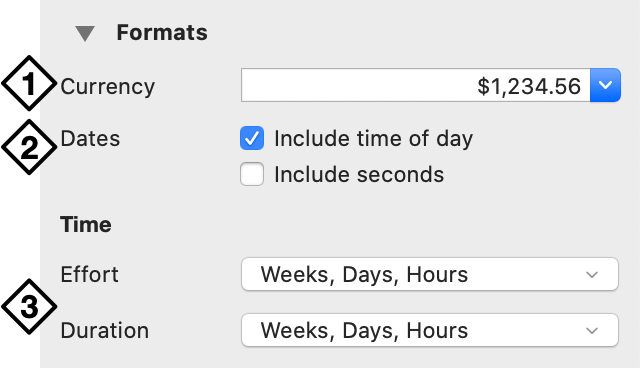
-
Currency—Choose a standard currency format from the dropdown list, or type the currency symbol of your choice and the field will auto-fill with the appropriate format.
-
Dates—Choose whether to include seconds, the time of day, or both in your displayed dates. Note that this doesn’t affect task scheduling or durations; only how dates are displayed in locations they appear across your project.
-
Effort, Duration—Choose the time units used to display durations and amounts of effort.
Note that, in duration fields, if you enter a number without any units, OmniPlan assumes the smallest unit here. Units of time (Duration and effort) are designated throughout OmniPlan with the following abbreviations:
- s = second
- m = minute
- h = hour
- d = day
- w = week
- mo = month
- y = year
If a value contains a unit of time that is too small to be displayed, you may see a rounded value. For example, if you have turned off the display of minutes in the Formats section of the Project inspector, and you have a task that starts at 9:00 and ends at 9:55, the value you see is < 1h. If you want to know the actual value, you can turn on the smaller units in Formats section, or check the start and end times of the task. If you want to edit the value to conform to your units, you can delete the greater-than or less-than sign and the value updates.
Effort Unit Conversions
Use the Effort Unit Conversions inspector to customize your project’s standard units of work-per-time.
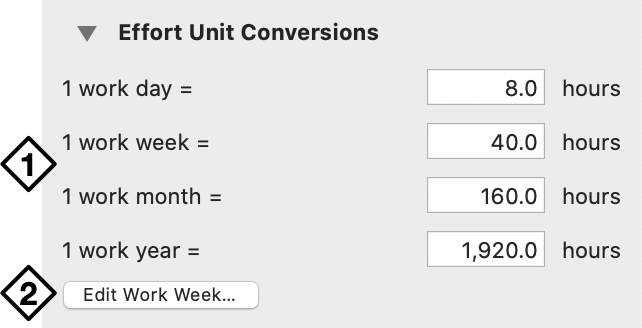
-
Conversion Factors—Your work day may be any number of hours. These conversion factors determine how hours add up into the larger units.
-
Edit Work Week—Click to open the Normal Hours tab in Resource View for editing the project calendar’s work week.
To reiterate: effort conversion factors don’t change the working hours for the project, only the way durations are entered and displayed. To change working hours for the project, visit Resource View to edit the project’s normal hours.
Document
Use the Document inspector to choose a file type for the project file, and decide whether to generate a preview of the document when saving.
In a new document this inspector is collapsed by default; click the disclosure triangle to the left of the inspector name to reveal its contents.
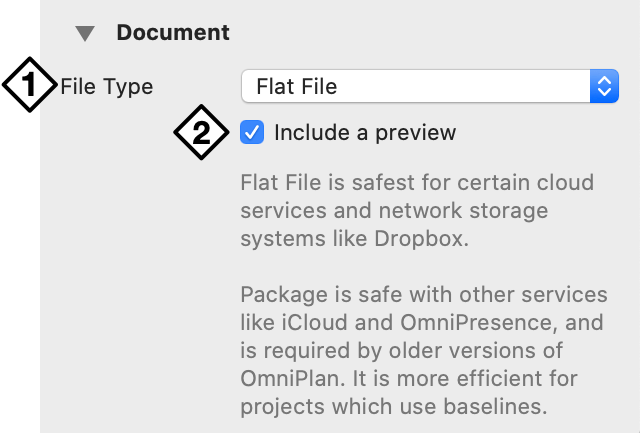
-
File Type—Use the popup menu to choose whether to save the project as a flat file—the default file type, ideal for greatest compatibility with cloud sync and storage—or a package—an older file type compatible with previous versions of OmniPlan.
The package file type can improve performance in some cases, but unless you have a specific need for it, the flat file type is otherwise recommended.
-
Include A Preview—Select to create a Quick Look preview of your document when you save the project.
On most modern Macs this process will not noticeably impact your use of the app, but if you encounter performance issues when saving, turning off Quick Look previews may improve the experience.
The Milestones Inspector
The Milestones inspector holds tools specific to the project’s milestones and critical paths, including a list of the milestones and the ability to edit their attributes and critical path behavior individually.

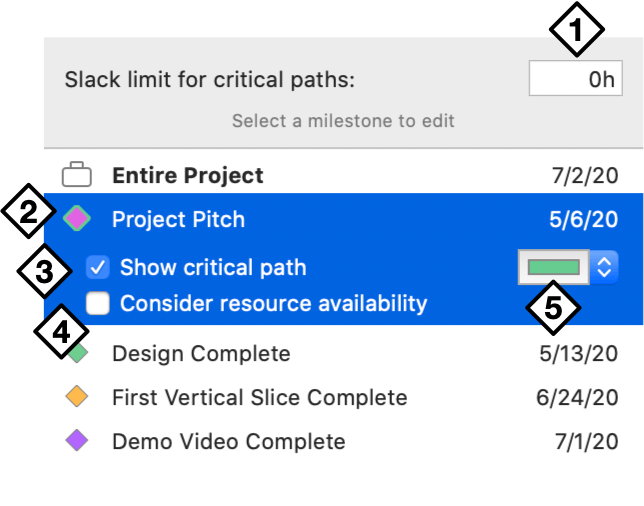
-
Slack limit for critical paths—This project-wide value determines how closely a task can come to pushing a milestone back before it is considered part of the critical path. Increasing the time value here broadens the scope of critical paths to potentially include more tasks. In other words—the higher the value, the less comfortable a time cushion between tasks will feel.
-
Milestone Icon—An icon colored with the milestone’s selection or project style. Click to collapse or expand the milestone’s row in the list. When the milestone’s critical path is displayed, the icon receives a border with its critical path highlighting color.
-
Show critical path—Select to turn on display of the milestone’s critical path. Choosing to show a milestone’s critical path means means it is among those displayed when turned on for individual views; if this is selected and you don’t see the critical path where you expect, check the current view’s View submenu to see whether its Critical Path option is turned on.
-
Consider resource availability—Select to have the milestone’s critical path take into account not only the dependencies between tasks and the slack limit, but also whether the necessary resources are available to complete tasks that are otherwise independent.
The clearest way to see how this works is to create a project with two independent tasks, and assign the same resource to both of them. Level the project, and you’ll see the second task move to follow the first. At this point, showing the critical path will only highlight the second task (1). Choosing to consider resource availability will highlight both (2), illustrating that while the second task doesn’t rely on the first to begin, it’s constrained by the resource required to complete it.
-
Critical Path Highlighting Color—Use this color picker to choose a color for the highlight used when the milestone’s critical path is displayed. Tasks in views with critical path display turned on will be highlighted with this color when they are part of the milestone’s critical path.
The Task Inspector
The Task inspector holds tools for configuring selected tasks, including descriptive details and information about their scheduling, dependencies, and assigned resources.

Task Info
Use the Task Info inspector to set key attributes that define the type and scope of a task.
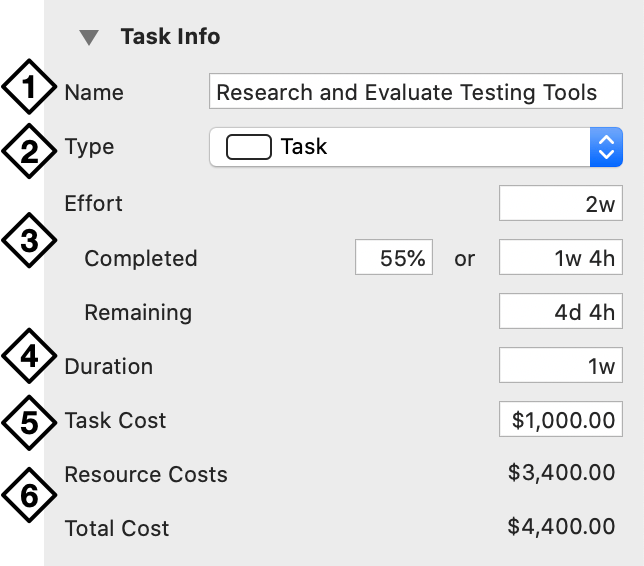
-
Name—The name of the task as it appears in the task outline.
-
Type—Choose from among the available types for the task, including:
- Task—The standard representation of a piece of work to be accomplished as part of the project.
- Milestone—A zero-length event which represents an important moment in the project’s life.
- Group—A parent task used for creating hierarchy with child tasks within it.
- Hammock—A task whose duration varies based on the completion of the preceding task and the start of the task that follows.
Additionally, the following options are available:
- Make This Task Recur—Convert an existing task or milestone to a recurring task.
- Edit Recurrence Rules—Open the recurrence dialog to change the rules for an existing recurring task.
- Stop Recurring—Convert a recurring task back to its original type and cancels any future occurrences.
- When Closed, Show Task Bar—Show a group task as a task bar representing the cumulative attributes of the group when the task is closed.
- When Closed, Roll Up Children—Show a group task as an overlaid collection of the group’s child task bars when the task is closed.
-
Effort—The amount of effort required to complete the task. Completed represents the amount of finished work on the task, while Remaining is the total effort required minus the completed effort.
-
Duration—The amount of time required to complete work on the task. See duration.
-
Task Cost—Any costs associated with the task that are not reflected in the costs of the resources assigned to the task.
-
Resource, Total Costs—The cost of the resources assigned to the task (derived from the resources’ Cost Per Use and Cost Per Hour values), and the total cost of the task (the resource costs plus the task cost). These values cannot be edited directly.
Creating Tasks with an Elapsed Duration
By default, OmniPlan calculates task duration and lead/lag time from the project’s work hours. Entering an “e” before the value for Duration converts it to an elapsed time value instead.
For example, if you need to wait for the paint to dry before you can take the next step in your project, enter 48eh in the “Let paint dry” task’s duration field to tell OmniPlan that the next dependent task can begin Monday morning if the paint has started to dry by the end of the day on Friday.
Tasks with an elapsed time most likely won’t require a resource, since you wouldn’t need to assign someone to stand around and watch the paint dry.
Schedule
Use the Schedule inspector to describe where the task is positioned in time—both actually, and relative to the baseline—along with other time constraints and scheduling priorities.
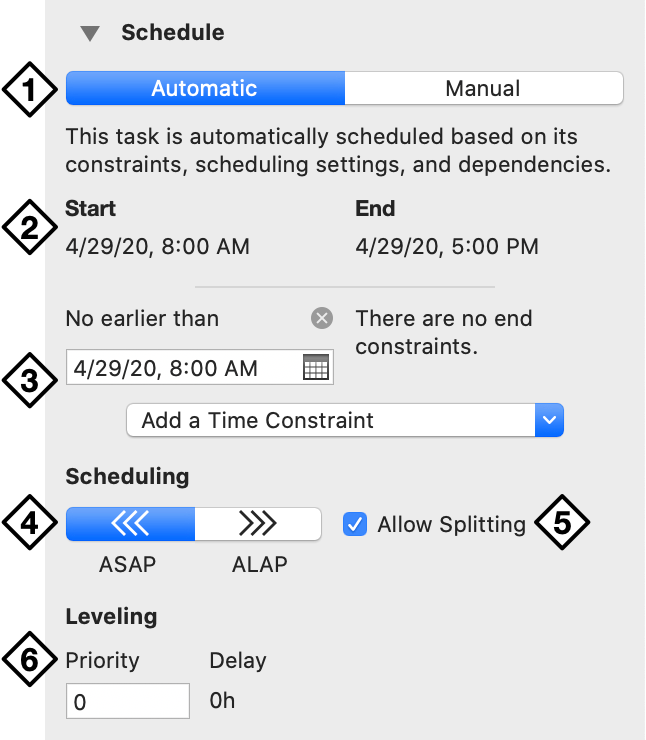
-
Automatic/Manual—Choose whether the task shifts automatically to the most efficient place in the schedule based on leveling, or whether the task’s position in the schedule is set manually.
-
Start/End—If the task uses automatic scheduling these values are determined by other factors and cannot be directly edited. If you are scheduling the task manually, use the calendar pickers or enter the desired start and end dates here.
-
Constraints—Use the drop-down menu to add timing constraints to the task from among: Start No Earlier Than, End No Earlier Than, Start No Later Than, and End No Later Than. Each task can have a single start constraint and a single end constraint; any constraints appear in this section above the drop-down menu. Use the X button next to a constraint to remove it.
-
ASAP/ALAP—Choose whether the task is scheduled As Soon As Possible or As Late As Possible (given other scheduling influences). This setting overrides the project direction for the individual task when they differ.
-
Allow Splitting—Select to allow the task to be split manually or by leveling. Deselect and the task will not be split for any reason.
-
Priority—Sets a numerical priority for the task. This determines the order in which tasks are assigned resources when leveling, with the highest positive integer receiving first priority. Delay is a value set automatically in the leveling process that notes how long a task has been postponed to wait for resource availability.
To schedule a task that has (or should have) already happened, choose Project > Set Current Editing Date and enter the date when work on the task began. This changes the contextual “insertion point” for the project to that date—newly created tasks originate there by default. When finished adding tasks relative to that date, set the editing date back to the present.
Baseline
Use the Baseline inspector to view information about the task’s relationship to the current baseline schedule and how it differs from the actual schedule of the project.
The content of this inspector cannot be edited directly.
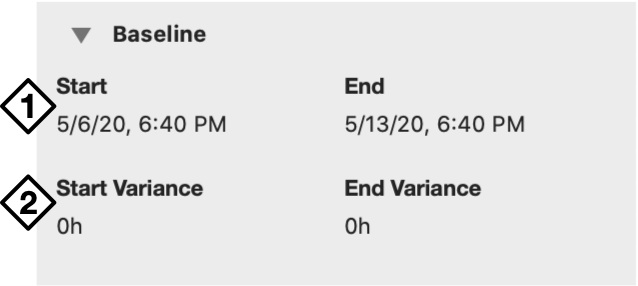
-
Start, End—These dates indicate when the task was expected to start and end according to the baseline plan. They appear once you use the Set Baseline command on a project, and may change depending on which baseline you select for comparison.
-
Variance—The amount of time that the start and end dates diverge from the plan established in the baseline.
Dependencies
Use the Dependencies inspector to get an at-a-glance view of the inspected task’s relationship with other tasks in the project, alter or remove dependencies on the fly, and add lead or lag time to related tasks.
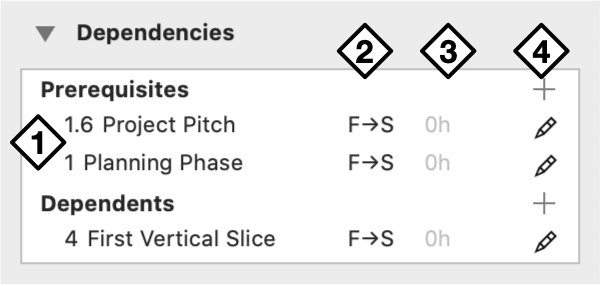
-
Dependencies List— A list of the tasks connected to the inspected task with dependency relationships.
The Prerequisites section lists tasks that the inspected task relies on, while the Dependents section lists tasks that rely on the inspected task. The nature of these relationships is described by their dependency types.
-
Type—The dependency type.
-
Lead Time—The related task’s lead time, if any.
-
Dependency Editor—Use the Plus buttons to add prerequisite or dependent tasks. Use the Pencil button to open the dependency editor for a related task.
The Dependency Editor
Click the Pencil button next to a task in the Dependencies inspector to open its dependency editor, where you can customize its relationship with the inspected task.
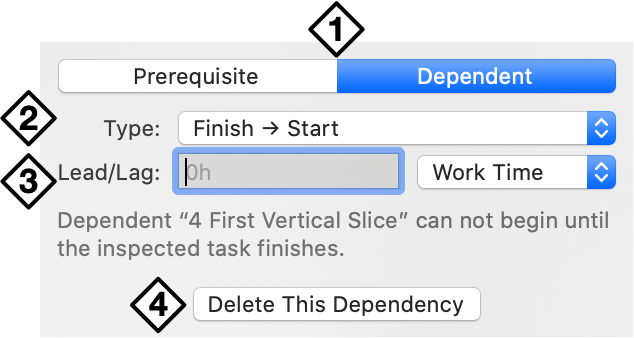
-
Prerequisite, Dependent—Choose whether the task is a prerequisite (the inspected task relies on it for something) or a dependent (it relies on the inspected task for something).
-
Type—Choose the dependency type.
-
Lead/Lag—Enter an amount of lead or lag time, and use the popup menu to designate wether it is Work Time, Elapsed Time, or a Percentage.
-
Delete This Dependency—Click to remove the dependency relationship between this and the inspected task.
Types of Dependencies
OmniPlan supports four types of dependencies that describe the ways in which tasks relate to one another.
- Finish to Start
- The first task must end before the second task can start; the tasks must not overlap except at the instant the first one ends. This is the most common type of dependency, and the kind that you get when you connect two selected tasks by clicking the Connect Tasks button in the toolbar.
- Finish to Finish
- When the first task ends, then the second one can end; the tasks may overlap.
- Start to Start
- Once the first task has started, the second one can start; the tasks may overlap.
- Start to Finish
- Once the first task starts, the second one can finish; the tasks must overlap at least at the instant the first one starts.
Assigned Resources
Use the Assigned Resources section of the Task inspector to see which resources are assigned to the task, change the amount of effort a resource is contributing, remove existing resources from the task, and add new ones.
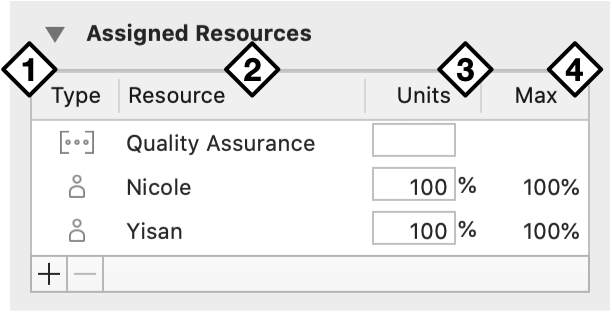
-
Type—The resource type.
-
Resource—The name of the resource.
-
Units—The units of the resource assigned to the task, expressed as a percentage of the resource’s total effort. This value cannot exceed the maximum available.
For material resources, Units instead represents the quantity of the resource devoted to the task.
-
Max—The total amount of the resource’s effort that is devoted to the project, expressed as a percent, and set in the Resource Info inspector.
Use the Plus and Minus buttons below the list to add and remove resources assigned to the task.
If a resource that is part of a resource group is assigned to a task, its group will be as well, but only as an informational marker; groups don’t have effort attributes, and can’t have their assignment directly removed. Resource groups shown in this way will disappear when all members’ assignments are removed from a given task.
Resource Allocation
Use the Resource Allocation inspector to determine how tasks are scheduled when resources are added to—or removed from—work on the task.
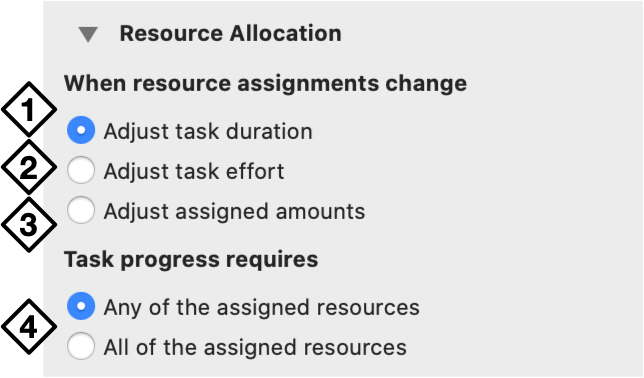
-
Adjust task duration—Adding new resources increases the effort available to complete them, and this option uses that effort to shorten the amount of time the task will take to complete. The opposite is also true, as removing a resource from the task will increase its duration.
-
Adjust task effort—Adding new resources keeps the duration the same, and adds the effort they contribute to the total required to complete the task—this represents pouring work into a fixed timeframe. Removing resources indicates that less effort is needed to complete the task in the same amount of time as originally planned.
-
Adjust assigned amounts—With this option the duration and effort stay the same regardless of resource assignments. Instead, when new resources are added, the amount of effort asked of each resource is reduced evenly across the board (one resource contributes 100 percent, two resources contribute 50 percent each, and so on).
-
Task progress requires—Choose Any of the assigned resources to allow anyone available to be assigned to the task in order to complete it most efficiently. Choose All of the assigned resources to require that every resource assigned to the task be available in order for the task to proceed.
Scheduling Meetings
The Task progress requires control merits special note as the way to model a task in OmniPlan that represents a staff meeting.
When task progress is set to require All of the assigned resources, it will not be scheduled until all of the resources assigned to it are available. (Or conversely, if the task has a fixed start and end time, other tasks will be scheduled around it to allow the required staff to attend.) This is particularly useful for meetings, or any other task that requires the simultaneous attention of the team.
Estimated Effort (Pro)
Use the Estimated Effort inspector in OmniPlan Pro to set predicted values for Monte Carlo simulations and forecast the timeliness of milestone completion.
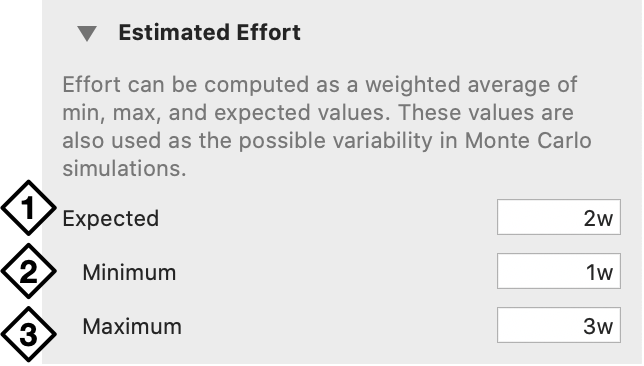
-
Expected—The best guess at the actual amount of effort the task will require to complete.
-
Minimum—The smallest amount of effort that the task could reasonably take to complete.
-
Maximum—The largest amount of effort that the task could reasonably take to complete.
You can use the Simulations button in the toolbar to auto-estimate the effort required to complete any number of selected tasks. However, if you would prefer fine-grained control over the range of effort used in completion scenarios, this section of the Task inspector provides fields for using any values you would like.
The weighted average formula used to calculate effort is:
[(minimum effort) + 4x(expected effort) + (maximum effort)] / 6
Values for effort throughout OmniPlan (including the Effort column in the task outline, the Effort field in the Task Info inspector, and others) are calculated based on the average of the three values in the estimated effort fields above.
As long as the average of the three remains equal to existing values elsewhere, you won’t see them change (the Simulations automatic effort estimation feature is built to ensure this). However, manually changing the values here (or in the associated custom columns) will cause other effort values to change.
Scheduling Influences
Use the Scheduling Influences inspector to view and edit the factors that come into play when automatically scheduling the task.
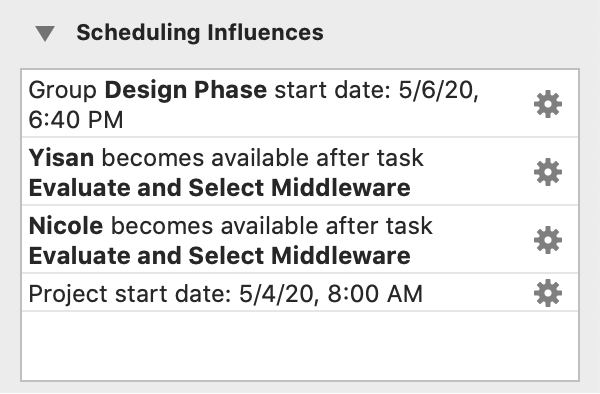
This inspector holds a list of all of the factors that currently influence the task’s scheduling. This includes resource availability, dependencies, and the start and end constraints of tasks and the project as a whole.
-
Double-click an item in the list to navigate directly to the relevant field in the item’s inspector.
-
Click an item’s Gear button to open a menu with commands related to the item—typically, options to either inspect the item or edit it directly.
The Resource Inspector
The Resource inspector holds tools for configuring resources (typically selected in Resource view), including descriptive details, scheduling, cost, and information about their task assignments.

Resource Info
The Resource Info section of the Resource inspector contains all of the vital details about a staff member, piece of equipment, or raw material used in completing your project.
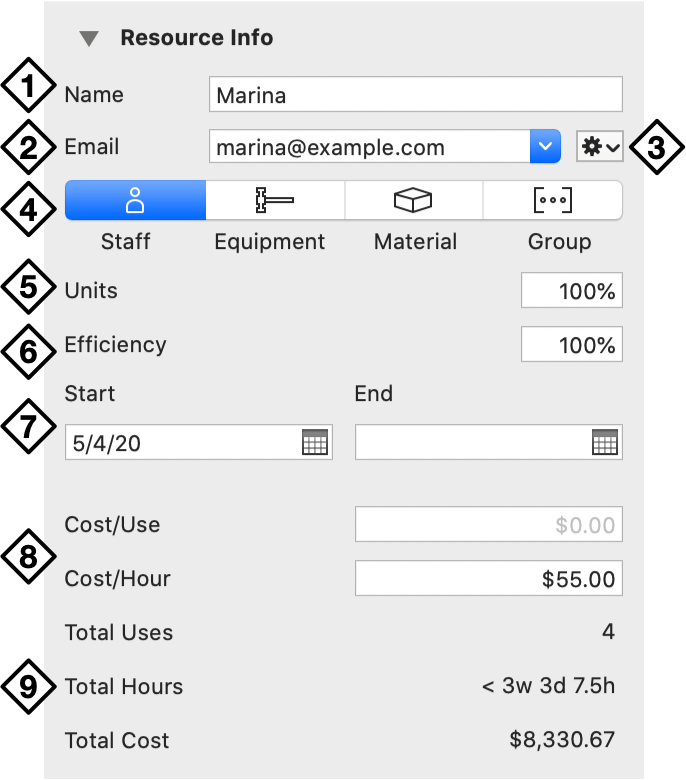
-
Name—The name of the resource as it appears in the resource list.
-
Email—A staff resource can be assigned a unique email address that serves as an identifier across projects. If the resource is associated with a macOS Contacts card, you can use the dropdown menu to pick which address to use.
-
Gear Menu—Use the gear menu to associate this resource with a Contacts card, open the card in Contacts, or send an email.
-
Type—Use this segmented control to indicate the resource type: Staff, Tool, Material, or Group.
-
Units—The amount of a tool or staff member’s time dedicated to the project (relative to their full time schedule) is expressed by the resource’s Units value.
For materials, Units describes the quantity of material used (based on the number of tasks the resource is assigned to) instead.
-
Efficiency—The amount of effort-per-time a resource contributes to tasks to which it is assigned.
-
Start,End—These dates determine when the resource is available. Leaving either date empty means that it lies outside the scope of the project.
-
Cost per Use, Cost per Hour—The monetary cost incurred each time the resource is assigned to a task, and the monetary cost of each hour of effort assigned to the resource, respectively.
-
Total Uses, Total Hours, Total Cost—The number of times this resource is assigned to a task, the sum of the effort of all tasks the resource is assigned to, and the combined cost of all uses and all hours for this resource. These cannot be edited directly.
Assignments
Use the Assignments inspector to get an overview of all the tasks that a particular resource is assigned to (or if multiple resources are selected, the intersection of their task assignments).
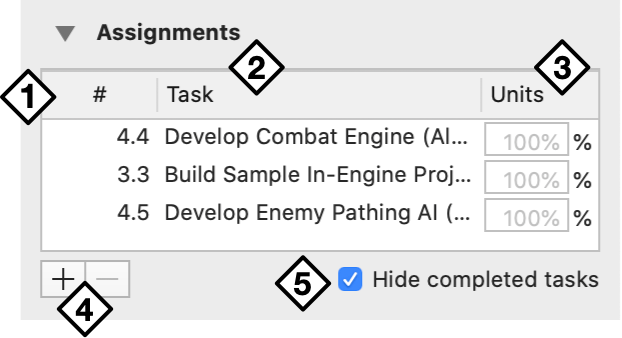
-
Number—The task’s hierarchical number.
-
Task Title—The task’s title. Double-click a task’s title to switch to Gantt view with that task selected in the Task inspector.
-
Units Assigned—The percentage of the resource’s effort that is devoted to the task. By default each task receives 100% of the resource’s effort when it is working on that task; edit this value to indicate that less effort should be spent.
-
Add/Remove Tasks—Use the Plus and Minus buttons to add or remove task assignments for the resource.
-
Hide Completed Tasks—Select this checkbox to hide tasks from the list that have reached 100% completion.
The Styles Inspector
The Styles inspector holds tools for configuring the visual style of individual item selections, item classes (such as groups and milestones), and the project as a whole, and provides a summary of styles applied to any currently selected items.

Selection Styles
Use the Selection tab to set ad hoc styles for the items that you are currently inspecting.
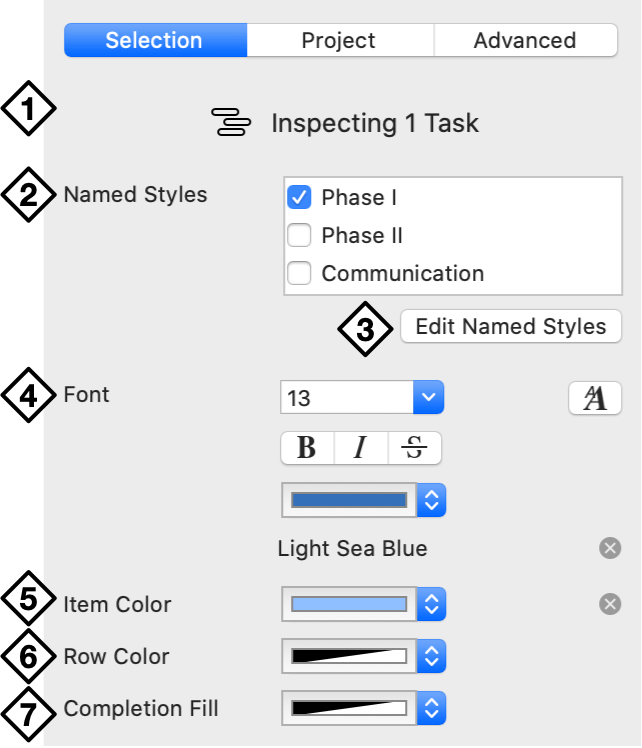
-
Selection Indicator—The space at the top of the inspector describes the items that you currently have selected. You must have one or more tasks or resources selected to apply selection styles; to edit styles for the entire project, use Project Styles instead.
-
Named Styles—Reusable style templates that can be applied to individual items. Any named styles set up for the project are listed here; select a style’s checkbox to apply it to the inspected items.
This area does not appear if no named styles are set up for the document.
-
Edit Named Styles—Click to open the Named Styles editor in the Project Styles pane.
-
Font—Use the controls in this section to change the size, style, color, and typeface of the inspected item’s row text. Click the X next to a property to remove it.
-
Item Color—Choose a color for the bar that represents the item.
-
Row Color—Choose a color for the item’s row in outlines throughout the app.
-
Completion Fill—Choose a color for the completed portion of the item’s bar. Only available if turned on in the Advanced tab.
Selection styles have higher precedence than any other type of style. If an item has a selection style applied to it, that style wins over any Named Styles editor or Project Styles.
Project Styles
Use the Project tab to edit styles that apply to common classes of items across the project, as well as the to document as a whole.
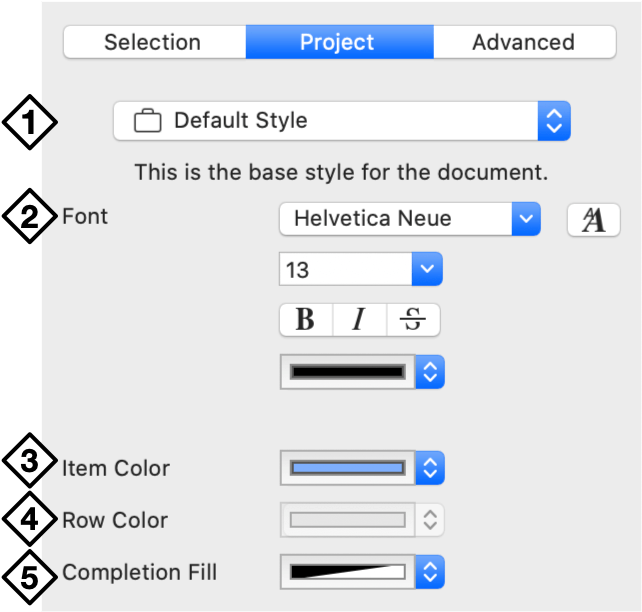
-
Styles Menu—Choose the project style to edit from this popup menu. Options include:
- Default Style—This is the base style for the document as a whole. Where applicable, other project styles and selection styles are layered above it.
- Normal Tasks—The base style for normal tasks throughout the project.
- Milestone Tasks—The base style for milestones throughout the project.
- Group Tasks—The base style for group tasks throughout the project.
- Hammock Tasks—The base style for hammock tasks throughout the project.
- Resources—The base style for resources throughout the project.
- Overdue Tasks—The base style for overdue tasks throughout the project.
- Completed Tasks—The base style for completed tasks throughout the project.
- Named Styles—Reusable style templates that can be applied to individual items via the Selection tab. Choose this to set up and edit named styles.
-
Font—Use the controls in this section to change the size, style, color, and typeface for the selected project style. Click the X next to a property to remove it.
-
Item Color—Choose a color for the bars of all items with the selected project style.
-
Row Color—Choose a background color for the outline rows of all the items with the selected project style.
-
Completion Fill—Choose a color for the completed portion of item bars with the selected project style. Only available if turned on in the Advanced tab.
Editing Named Styles
Named Styles are saved collections of style attributes that you can apply as ad hoc styles to selected items using the Selection tab. These styles are saved with the document, can be included in templates, and are ideal for frequently used styling of individual items.
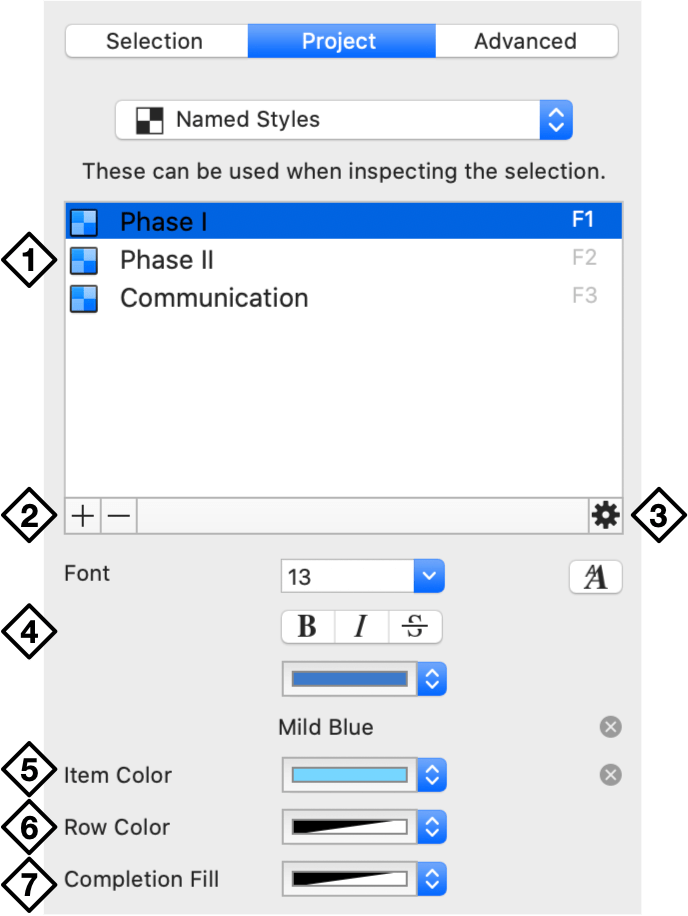
-
Named Styles List—Named styles saved with the document are listed here. The first nine styles are assigned keyboard shortcuts shortcuts F1 through F9 by default. Click and drag to reorder styles in the list.
-
Add/Remove—Click the Plus and Minus buttons to add or remove styles from the list. Deleting a style here removes the style from any items in the project that had it applied.
-
Gear Menu—Opens a menu with commands to Copy a selected style, Rename it, Duplicate it, or Reset any of its custom attributes.
-
Font—Use the controls in this section to change the size, style, color, and typeface for the selected named style. Click the X next to a property to remove it.
-
Item Color—Choose a color for the bars of items with the selected named style.
-
Row Color—Choose a background color for the outline rows of items with the selected named style.
-
Completion Fill—Choose a color for the completed portion of item bars with the selected named style. Only available if turned on in the Advanced tab.
Advanced Styles
Use the Advanced tab to edit styles for miscellaneous structural aspects of the project appearance.
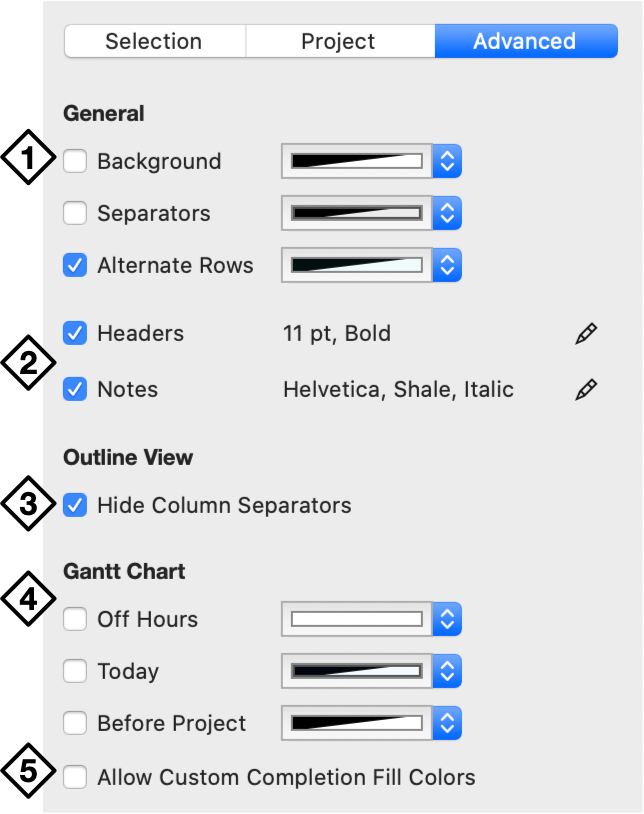
-
General—Select the checkboxes here to turn on colors for the document background, separators, and alternate outline rows.
-
Fonts—Select the checkboxes here to turn on custom fonts for chart headers and item notes. Click the Pencil button for each to open a popup font editor.
Deselecting the checkbox for a custom font clears it permanently from the document. It must be set up from scratch to be used again.
-
Outline View—Select to hide column separators in the outline.
-
Gantt Chart—Select the checkboxes here to turn on custom colors in the Gantt chart for off hours, the present day, and the time before the project’s scheduled beginning.
-
Allow Custom Completion Fill Colors—Select to allow selection and project styles to include custom colors for the portion of bars representing task completion. If deselected, the Completion Fill attribute is removed from the Selection and Project tabs.
Style Attributes
Use the Style Attributes inspector to view information about the style influences on the currently inspected item.
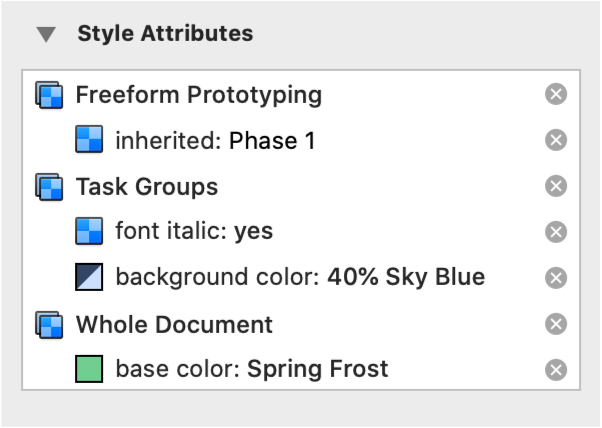
Any ad hoc styles are listed here, along with base project styles and named styles.
-
Copy a style from the inspector by dragging the style swatch (the square icon next to the style name) from the inspector to an item in the current view. This applies it to the item as an ad hoc selection style.
-
Clear a style from the inspected item by clicking the X on its row.
The Custom Data Inspector
The Custom Data inspector provides space to add information about individual tasks, resources, or the project as a whole (depending on the selection), including notes, key/value pairs, and linked file attachments.


The area at the top of the inspector shows what is currently being inspected. Custom data entered in the sections below is attached to the selection listed here.
Notes
Use the Notes inspector to add text and links related to the selected task, resource, or the project as a whole.
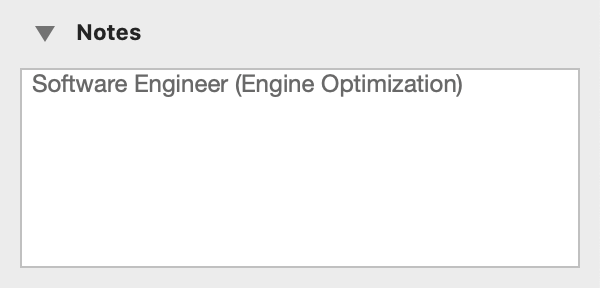
Text in the Notes inspector also appears in notes on item rows in the outline, and can be styled on a document level using the Advanced tab of the Styles inspector or customized individually with the Format menu.
Links In Notes
You can interact with URLs you add to notes as you would expect. Clicking a link resolves it in a web browser or appropriate app destination (OmniOutliner links open in OmniOutliner, for example).
The contextual menu on links offers additional interactions:
-
Open Link—Opens the link in the application designated to handle it.
-
Copy Link—Copies the link to the clipboard.
-
Edit Link—Opens a dialog for editing the link destination (as opposed to the link text).
-
Remove Link—Removes the hyperlink from the link text, leaving the text behind.
Key/Value Data
Use the Key/Value Data inspector to add custom information stored as key/value pairs. The key is like a label for what type of information you are storing, and the value is the information itself.
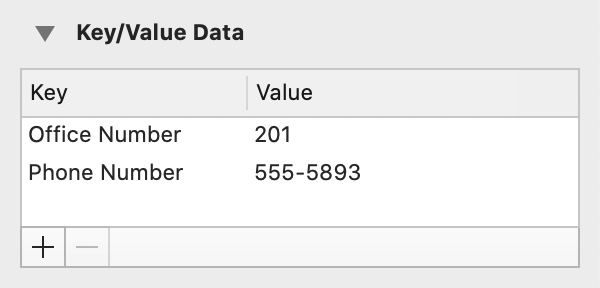
For example, to keep track of staff members’ phone numbers:
- Select a staff resource in the resource list, and open the Custom Data inspector.
- Click the Plus button at the bottom of the inspector to create a new key/value pair.
- Name the key Phone Number.
- Enter a number as the value for the selected resource.
Now that you have created the key for this resource, every other resource has the same key, ready for you to enter a value.
You can show key/value pairs as custom columns in the task outlines or resource list, or as labels in the Gantt chart or resource timeline, by customizing task labels and columns in the appropriate View submenu (or by control-clicking on the outline’s column header and choosing the key name from the contextual menu).
Linked Files
Use the Linked Files inspector to keep references to files that are relevant to your project or to particular items in it. Select a task or resource to add a linked file to it; adding a linked file with nothing selected will add it to the project as a whole.
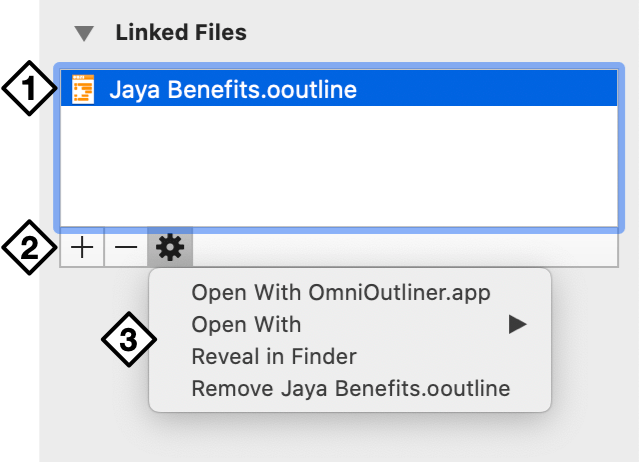
- Linked Files List—Any files linked to the task, resource, or project are displayed here. Double-click a file to open it in its default application.
- Add and Remove Files—Use the Plus and Minus buttons here to add or remove linked files from the list. These links are associations rather than files themselves; adding or removing them will not alter the original files.
- Linked Files Gear Menu—Use the gear menu to choose an alternative application for opening a selected file, to reveal the selection in Finder, or remove the link to the selected file.
To link a file to an item in the task outlines or resource list:
- Click the item to select it.
- In the Linked Files inspector, click the Plus button below the files list, then choose a file in the dialog that appears. If you are showing the Attachments column in the outline, you can also click the arrow icon and choose Attach File from the pop-up menu, then choose a file. Alternatively, drag a file into the list.
- The file appears in the inspector’s linked files list.
To link a file to the project itself:
- Make sure nothing is selected in the main view.
- In the Linked Files inspector, click the Plus button below the files list, then choose a file in the dialog that appears. Alternatively, drag a file into the list.
- The file appears in the inspector’s linked files list.
You can open a linked file by double-clicking it in the Linked Files inspector, choosing Open from its contextual menu, or by choosing it from the pop-up menu in the Attachments column of an item’s row in the outline.
Every linked file is a reference to the file elsewhere on your disk. If you move the files around, the references try to keep track of the new location. But if you are going to send a project to someone else, or otherwise move your project to another computer, the other files won’t automatically come along for the ride. In that case you should gather all of the attached files into one folder along with the OmniPlan file itself, and send the whole folder.
You can show linked files as a column in the task outlines and resource list by customizing task labels and columns in the appropriate View submenu, or by control-clicking on the outline’s column header and choosing Attachments from the contextual menu.
Resolving Violations
Occasionally situations will emerge that break the rules of logic you have set up for your project. When one of these occurs, OmniPlan will let you know by indicating a violation related to the adjacent task. A red icon appears in the Violations column of your task outline, which you can click to open the Violations Window.
If an error has occurred in your project, the Violations Window lets you know what is wrong. You can open it by clicking on the icon in the Violations column of Gantt View, the Violations button in the toolbar, or with Window > Violations (Shift-Command-V).
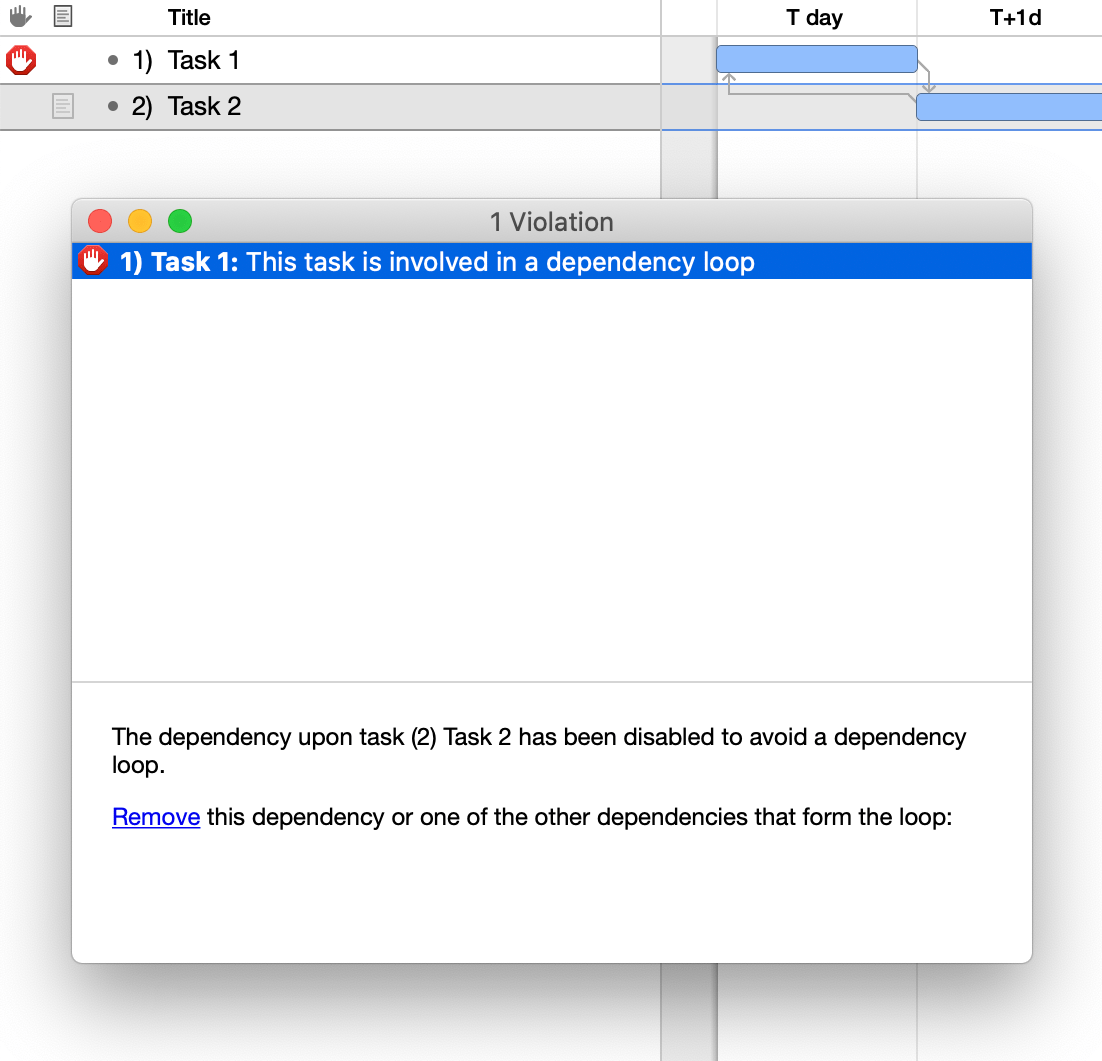
This window lists all of the violations in the project, along with explanations of why they have occurred. Most explanations include links you can click to immediately resolve the problem.
If the automated resolution provided by the Violations Window is not what you want, tips at the bottom of the window will help determine the source of the problem so you can fix it based on your scheduling needs.
Types of Violations
| Violation | Description |
|---|---|
| Errors | |
| More resources assigned than are available | More resources are assigned to this task than are available in the project. X has Y total currently assigned. |
| Constraints too close together | The start and end constraints are too close together to contain the entire duration of this task. |
| X constraint hit due to prerequisites | This task cannot start on or before its start constraint date due to prerequisites. |
| X constraint hit due to dependents | The possible end date of this task, minus its duration, makes it start before its start constraint date. |
| ASAP/ALAP task unable to be scheduled | This as-late-as-possible task can’t be scheduled because there is not enough time for it in between its prerequisite and dependent tasks. |
| Task ends after group’s end constraint date | The scheduled end date of this task occurs after its group’s end constraint date. |
| This task is involved in a dependency loop | The dependency upon task (X) Y has been disabled to avoid a dependency loop. |
| Hammock task doesn’t have start and end prerequisites | This hammock task does not have a dependency connected to both its start and its end, and so its duration is indeterminate. |
| Manual date set before prerequisites complete | This task's dates are set to manual, but it can't begin on its current date because its prerequisites won't yet be completed. |
| Manual date set earlier than no-earlier-than constraint date | This task is set to manual dates, but it can’t begin on its current date because it also has a no-earlier-than constraint that says it must begin later. |
| Scheduled outside of resource work time | There is not enough work time remaining for the resources assigned to this task for it to be completable. |
| Task ends after project’s end date | The scheduled end date of this task occurs after the project end date. |
| Task starts before project’s start date | The scheduled start date of this task occurs before the project start date. |
| Warnings | |
| Couldn’t fit task during resource leveling | This task couldn’t be fully resource leveled and therefore the resources it is assigned to may remain overloaded. The task hasn’t been moved. Resource leveling failed because there wasn’t enough time to perform the task while honoring these constraints. |
| Maximum effort exceeded | OmniPlan supports a maximum of 20 years duration or 100 person-years of effort for a single task. This task was either set directly to a larger value, or the effort in the plan file was corrupted. |
| Reserve time lost from OmniPlan 1.x | This group contained reserve time in OmniPlan 1.x, which is an attribute that no longer exists in current versions of OmniPlan. That reserve time value is now missing. No other scheduling information has been affected. |
Using Dashboards (Pro)
When you are managing multiple projects at the same time, it is essential to ensure that the projects are on track and that any shared resources are correctly assigned. To help facilitate management of and participation in multiple projects, you can use Dashboards in OmniPlan Pro.
An OmniPlan Dashboard file (.opld) is a window that displays summaries of multiple projects simultaneously. When saved, the Dashboard file preserves the projects you have added to it, enabling you to quickly review your projects side by side.
To create a new Dashboard, choose File > New Dashboard (Shift-Command-N) and then drag OmniPlan project files onto it.
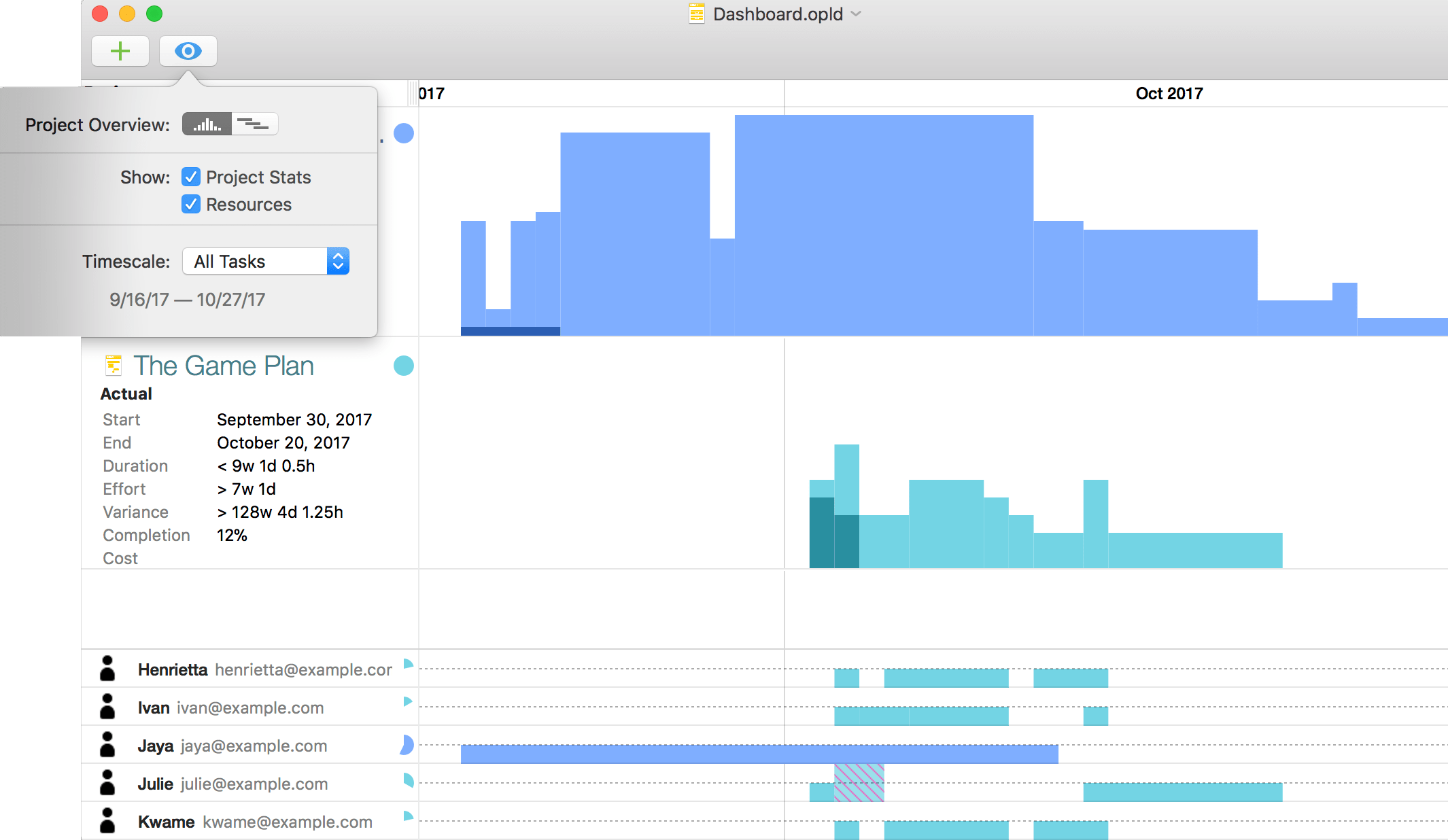
You can save that dashboard for future reference in its own .opld file format, and create as many other unique combinations of projects as you want with additional dashboard files. Any updates you make to a project that is shared in a dashboard are immediately reflected there, but projects themselves can’t be directly edited from the dashboard interface.
Creating a New Dashboard
To create a new Dashboard, follow these steps:
- Choose File > New Dashboard (Shift-Command-N).
- Click
 to add a project to the Dashboard. This opens a sheet from which you can locate and choose OmniPlan projects to add to the Dashboard. Alternately, you can also drag OmniPlan project files into the window from the Finder.
to add a project to the Dashboard. This opens a sheet from which you can locate and choose OmniPlan projects to add to the Dashboard. Alternately, you can also drag OmniPlan project files into the window from the Finder.
Reviewing Projects in the Dashboard
As you add projects to the Dashboard, you’ll see them laid out as rows with summary graphics of the projects’ Gantt charts in two-tone color schemes that reflect the work completed and the work yet to be done (these colors represent their respective projects throughout the Dashboard).
The Project column in the Dashboard provides you with a quick overview of your project’s Summary information (similar to what you see in the Project inspector). This first column can be resized by dragging the header separator left or right:
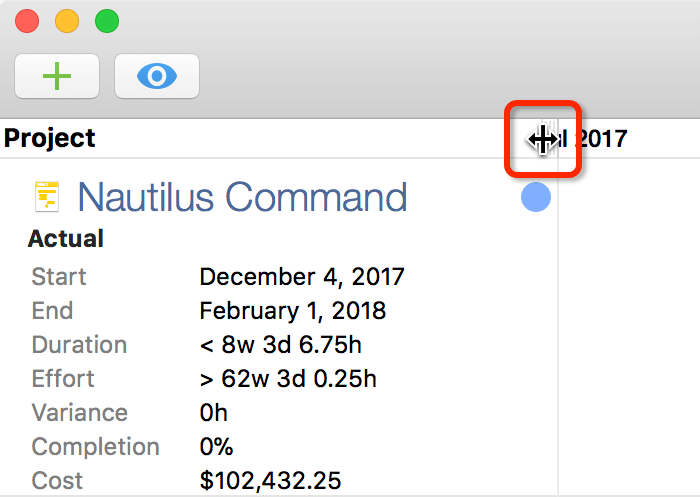
By default, the projects you add to the Dashboard show the Actual timeline for the project. However, if you click Actual, you can view a list of the baselines currently set for the project, and select a baseline schedule to view in the Dashboard instead.
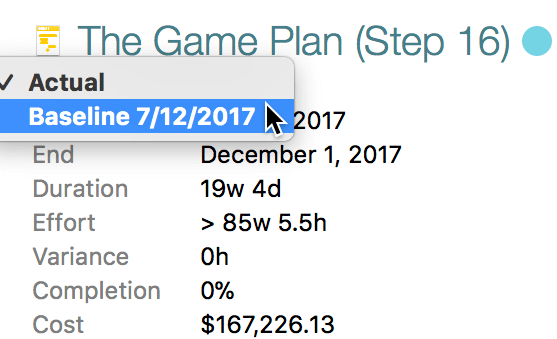
In addition to rows representing your projects, you’ll see an additional, automatically generated row—a graph of Idle Time to indicate when the projects’ resources are available for other tasks. White bars of idle time represent unused time in the past, while dark gray bars represent available time in the future.
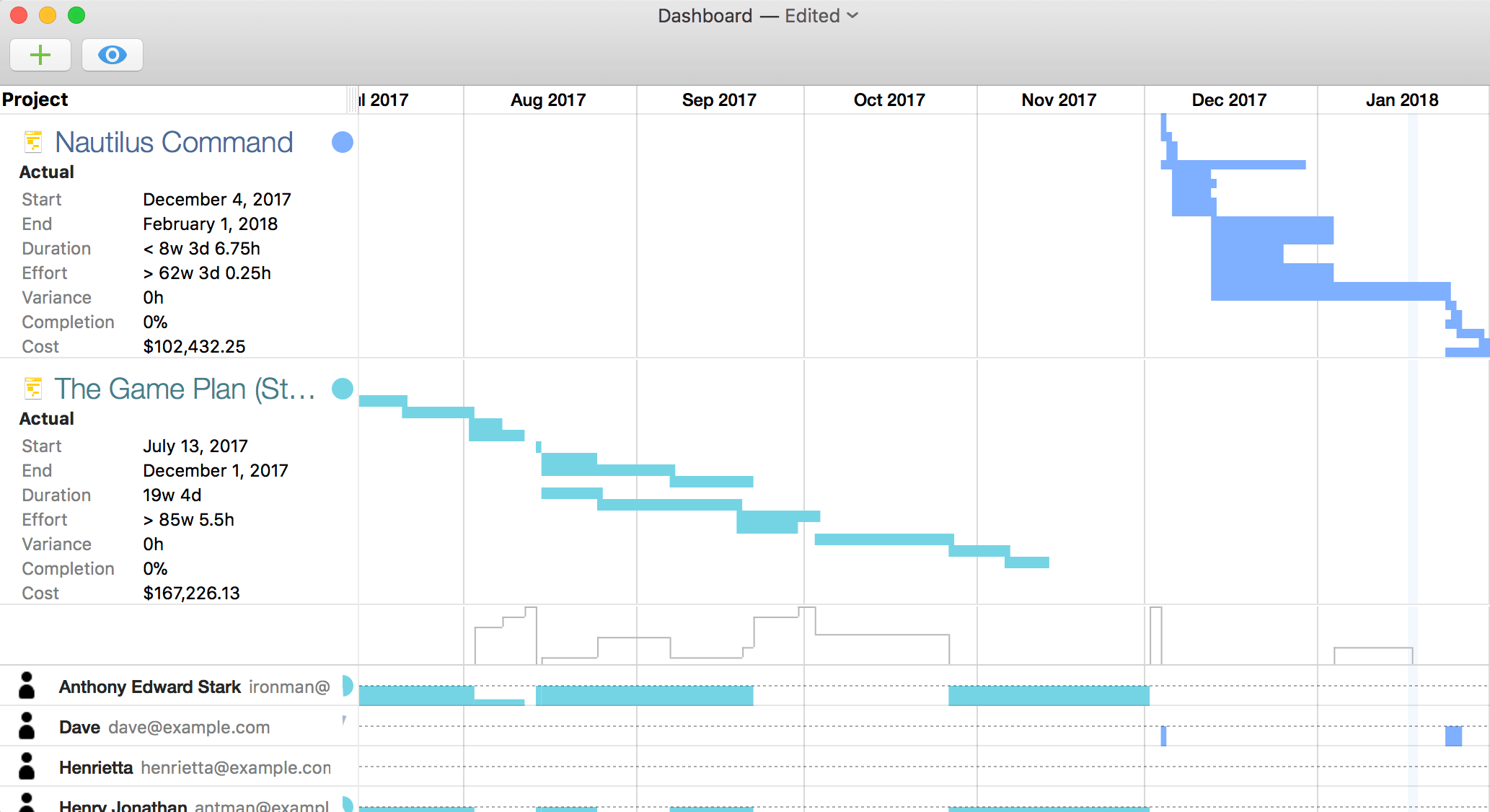
Along the bottom of the Dashboard window, you’ll find a list of any resources to which an email address is assigned. Next to each person, you’ll see diagram-style bars that illustrate when each person is busy or available, along with pie chart reference graphs noting the split of their effort between the projects in the Dashboard and their Idle Time.
Click  to open the Dashboard window’s View menu, which offers the following options:
to open the Dashboard window’s View menu, which offers the following options:
- Project Overview—Choose between the Gantt comparison view or a bar chart view for displaying the chronology of projects with task bar heights based on the amount of effort required for completion.
- Show Project Stats—Shows or hides details about the project(s) on the Dashboard, including start and end dates, duration, variance, completion, and cost.
- Show Resources—Shows or hides the list of project resources along the bottom of the Dashboard window.
- Timescale—Choose a timeframe for the Dashboard to display from among a list of preset time spans. These include All Tasks (the Dashboard automatically scales to fit every task across all of its projects), Today through the End of all projects, This Month, This Quarter, or This Year. Alternatively, choose Custom to pick any date range you like.
You can open a project directly from the Dashboard by clicking its document icon. Edits made to project files included in the Dashboard are reflected there right away, so you can immediately see the effect your changes have on the project in question—and potentially on others, if you are sharing resources between projects.
Sharing Resources Between Projects
The power of dashboards is realized to its fullest when you are also taking advantage of the publication and subscription of resource loads of the projects included in your dashboard.
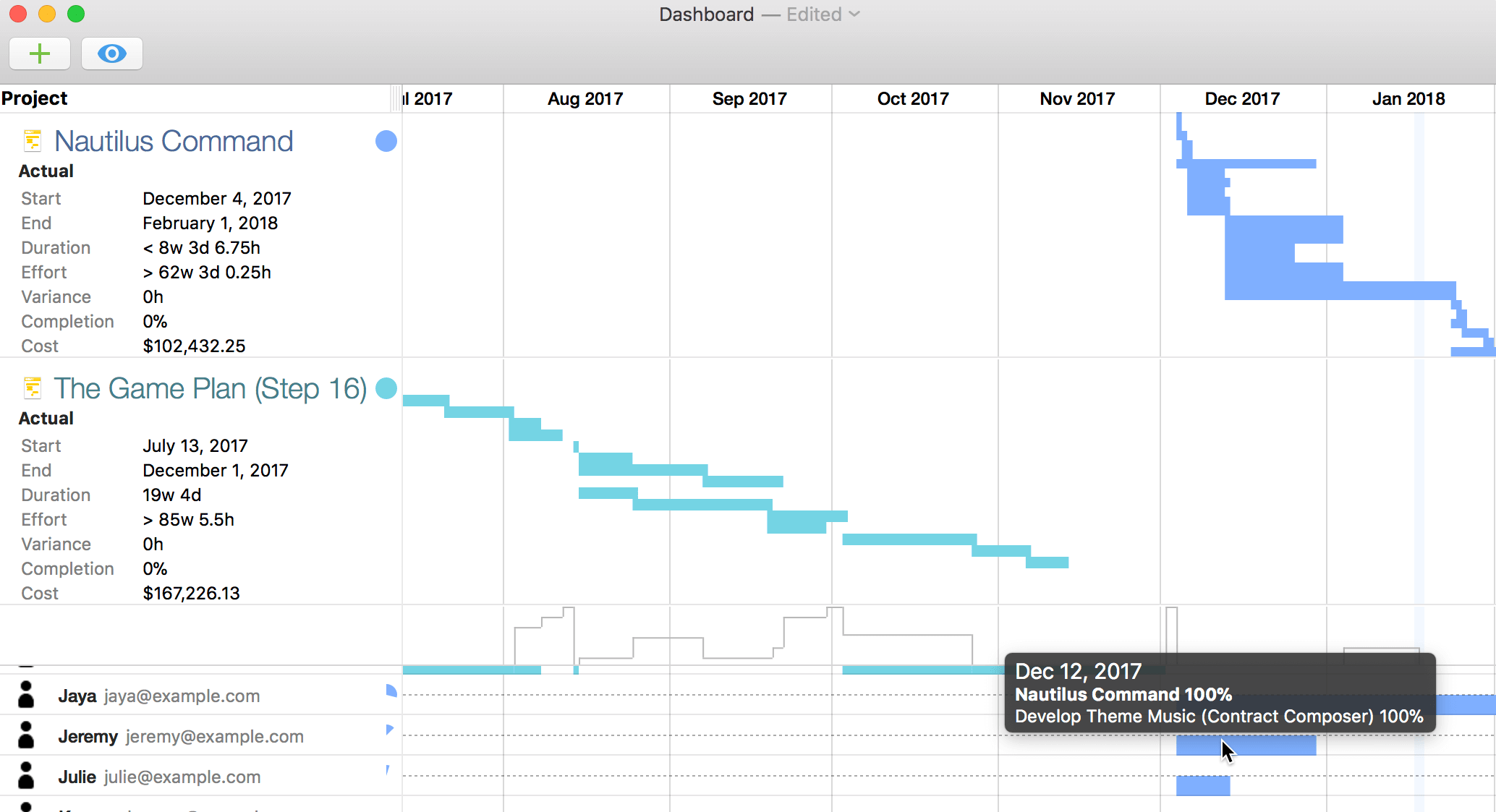
When balancing resource loads across projects in a shared server repository, the dashboard recognizes that resources are being shared and provides a window on the intersection between resources and the projects they’re working on (sometimes simultaneously at 100% effort, as in the example above). You can identify where resources are overloaded (or are standing idle), and make the changes necessary to ensure your projects are running in tandem at peak efficiency.
Printing Dashboards
When you have a dashboard set up the way you like it and you want to share it with others, you can print it straight from the File menu (Command-P).
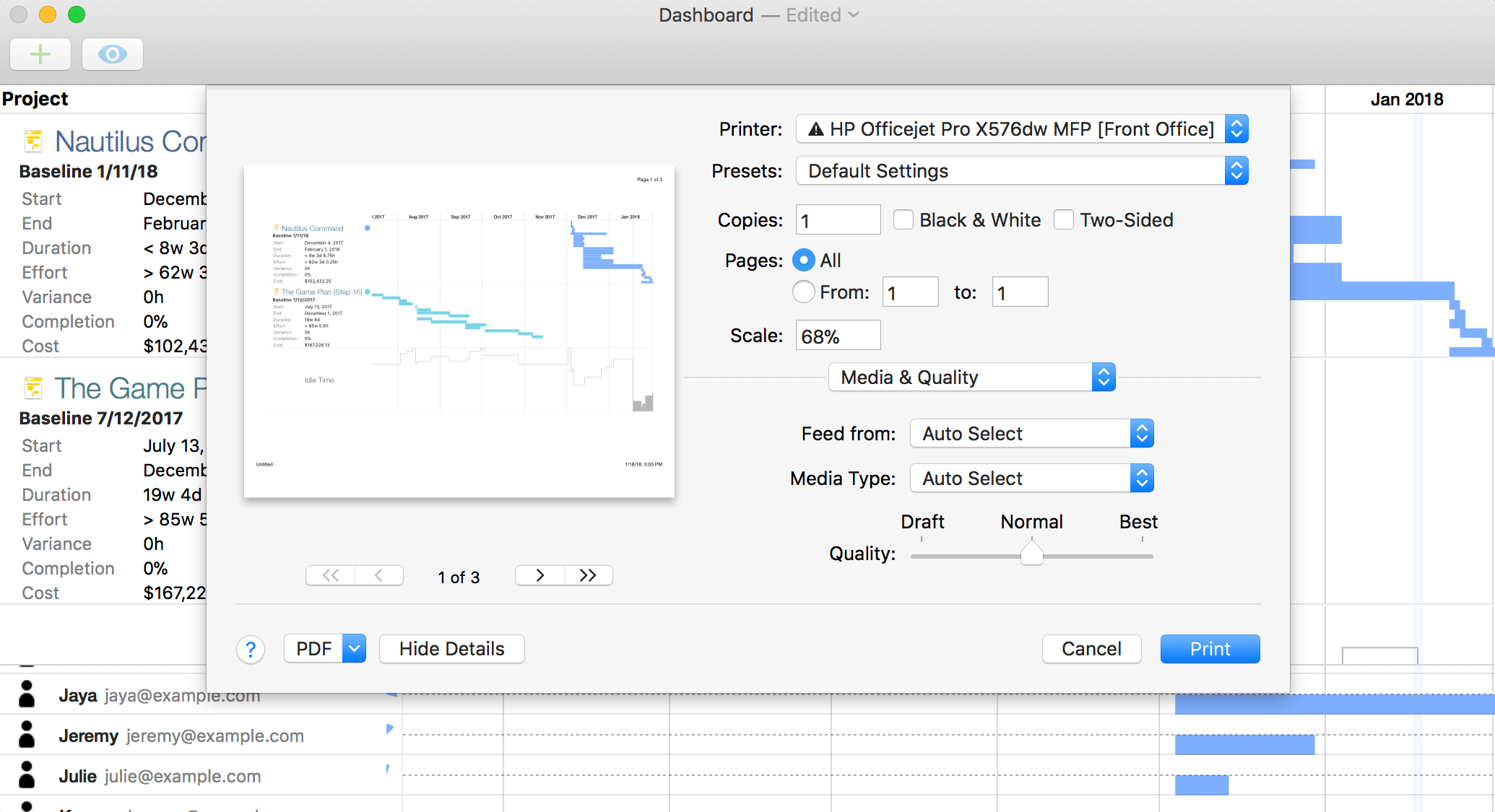
Print-time options for dashboards are pretty straightforward; as with all standard documents in macOS, you can choose to save the dashboard as a PDF rather than send it to a printer. The standard page setup controls are available as well.
The most important thing to note about printing dashboards is that what you see is what you get—the content of the print preview changes based on the dimensions and content of the dashboard’s window at the time of printing.
A dashboard’s printed page width is dictated by the bounds of the window, and will never exceed one page; excess pages are generated vertically only. If you find that the printed version of your dashboard extends vertically more than you would like, consider turning off display of project stats and resources in the dashboard’s view menu.
Importing and Exporting
OmniPlan works great as a standalone app, but its capabilities don’t end there. When you need to reach out to customers or colleagues across platforms, OmniPlan interacts with other apps and services in a wide variety of ways.
Importing from Other Formats
OmniPlan understands several other applications’ file formats. You can open files of these types in OmniPlan the same way you would open an OmniPlan document. The file is imported into a brand new OmniPlan document, which you can then edit, save, or export.
When it’s time to import a file other than an OmniPlan .oplx file (or with Pro, an .opld Dashboard file), choose File > Open (Command-O), and be sure that Allow import of other recognized file types is checked in the Open dialog.

The following file formats are recognized and can be imported by OmniPlan 4:
-
Comma-Separated Values (.csv) and Tab-delimited text files (.tsv)—OmniPlan can read comma-separated or tab-delimited values from a plain-text file. To see how the data in a CSV file should be formatted, export an OmniPlan document as a CSV file and open the result in any text editor. Tab-delimited files are formatted like CSV files, except that tab characters are used instead of commas to separate fields.
-
OmniOutliner (.oo3 and .ooutline)—Task lists can be imported from OmniOutliner files. A column mapping dialog appears, where you can choose which outline column should correspond to which field of task information. If the outline has multiple levels of hierarchy, task groups are created.
Exporting to Other Formats
OmniPlan can write files in several formats for use with other applications. To export an OmniPlan file, choose File > Export (Option-Command-E). When you export, a new file is created, leaving your original document as it is on the screen. Note that not all aspects of an OmniPlan document can be represented in all file formats; see details for each format below.
-
OmniPlan Document (.oplx)—OmniPlan can export to its own format. This is useful when you want to use the filtering feature to make a new OmniPlan file of tasks matching certain criteria: filter the tasks and make sure that Only Filtered Contents is checked when you go to export the project.
-
iCalendar (.ics)—This is the calendar format used by Apple iCal, Apple Calendar, and many other calendar applications. You can choose to export the tasks as calendar events or as items on a to-do list. If you export calendar events, you can also choose whether each task should become to a single event, regardless of how long it may be (One event per task), or whether tasks should be broken into chunks when they span working and non-working hours (One event per work period).
-
Comma Separated Values (.csv)—CSV is a common plain-text format that can be read by many different applications. You can choose to export in a variety of text encoding formats (UTF-8 is the default), choose whether to include task groups in the export, and choose parameters for interval tracking. When exporting with interval tracking, you can choose the date range to track, and whether to include intervalic or cumulative cost and effort.
If you are having trouble persuading other applications to read the non-ASCII characters in your CSV file, such as accented letters or non-Roman characters, try exporting with one of the other encoding options. This makes it easier for some applications to detect the correct encoding and interpret your characters properly.
-
Image Export (.png, .pdf, .tiff, .jpg)—You can export a picture of the Gantt View, Resource View or Network Diagram, selected from the Image Content menu in the Export panel. Depending on the view you choose, you can have the image include the outline, the Gantt chart or resource timeline, or both.
-
OmniOutliner 5 (.ooutline)—The task outline is exported as an OmniOutliner file (supported by OmniOutliner 5), with row hierarchy that corresponds to OmniPlan’s task groupings and columns corresponding to those available in OmniPlan’s Gantt View. As with CSV export, interval tracking can be included with export to the OmniOutliner format. Interval data is displayed in columns added to the outline.
-
Graphviz (.gv)—An OmniGraffle-compatible file format used for network diagramming. There are three types of Graphviz export available, representing an array of diagram types and styles.
-
Work Breakdown Structure—Tasks and groups are represented by a tree of objects. The connection lines in this diagram type represent the hierarchy of the task outline; dependency lines are not represented.
-
Activity-on-Node Network Diagram—Tasks are represented by objects, connected by dependency lines. While a Gantt chart emphasizes durations, this type of chart emphasizes the path of dependencies.
-
Activity-on-Arrow Network Diagram—Tasks are represented as lines between objects, with the title and duration of the task as a label on each line. Like the Activity-on-Node network diagram, this diagram type emphasizes dependencies.
-
Microsoft Project Support (Pro)
If you are ever called upon to use OmniPlan in tandem with Microsoft Project, there is good news—OmniPlan Pro supports both export to and import from the vast majority of MS Project file formats.
Importing from Microsoft Project
Documents in the Microsoft Project .xml or .mpp formats created with Microsoft Project versions 2003 through 2019 can be opened by OmniPlan Pro. To import such a file, choose File > Open (Command-O) or double-click the file in Finder. The file is imported as a new OmniPlan .oplx file, ready to be edited or saved for future work.

An imported Microsoft Project file appears in OmniPlan with a blue-accented notice bar at the top. If errors show up in the document, you can use Report Problems in the notice bar to let us know about them, or click Done to dismiss the bar.
Exporting to Microsoft Project
Along with importing from the most-used MS Project formats, OmniPlan Pro can export to them as well. The following Microsoft Project formats are supported:
Microsoft Project Plan (.mpp)—This is the preferred format for most interactions with modern versions of Microsoft Project.
Extensible Markup Language (.xml)— As an open standard, .xml is useful with both Microsoft Project as well as interactions with other applications.
OmniPlan’s Microsoft Project export is updated to be most highly compatible with the newest .mpp format we support (that used by Microsoft Project 2019). .mpp files generated by OmniPlan will still open in older (and possibly newer) versions of Microsoft Project, but may not be as fully readable to them.
Older versions of Microsoft Project may prompt you to download an update or converter from Microsoft to support the newer file format exported by OmniPlan.
Quirks in Microsoft Project Import and Export
OmniPlan is pretty good at working with Microsoft Project documents up to and including the Microsoft Project 2019 .mpp format, and we’re always working to make it even better. There are a few things to note as you work with Microsoft Project documents in OmniPlan.
-
Scheduling—Support for importing and exporting new scheduling features introduced in OmniPlan 4 has not yet been implemented in OmniPlan’s Microsoft Project Import/Export tool.
-
Assignments to Task Groups—In Microsoft Project, a resource can be assigned to a group of tasks. In OmniPlan, this assigns the resource to all tasks in the group, not to the group itself. When you import a Microsoft Project document with an assignment to a task group, a warning appears in the violations column to let you know that the assignment was not imported.
-
Custom Columns—Many of the optional columns in the Task and Resource View outlines don’t have direct analogs in Microsoft Project, and vice versa. These columns won’t be displayed when importing from or exporting to the affected app, and data in them will be left behind as well.
-
Efficiency—Microsoft Project doesn’t support the OmniPlan efficiency attribute for resources.
-
Styling (Document, Tasks, and Resources)—Styles you apply to items in OmniPlan, as well as those for the project as a whole, aren’t carried along when you export to Microsoft Project formats.
-
Unequal Assignments—In Microsoft Project, if you assign more than one resource to a task you can specify how many hours of effort each assigned resource should contribute. If you don’t specify, it assigns however much work to each that will complete the task earliest (taking schedule and resource assigned units into account). OmniPlan always uses that same automatic method. So, a task with effort hours specified for its resources may take a different amount of time in OmniPlan than it did in Microsoft Project.
-
Overloaded Resources—When importing a Microsoft Project file, OmniPlan will not overload resources as it schedules tasks. If a resource is overloaded in the original Project file, the auto-scheduled dates will change to avoid overloading resources (allowing for a maximum of 100% utilization of any resource). Therefore, the initial scheduling of tasks with previously overloaded resources will differ from the dates in the Project file.
-
Tasks with ALAP Scheduling and Other Constraints—ALAP is a mutually exclusive status with other constraints on a task in Microsoft Project. When exporting an OmniPlan project as an .mpp file, tasks that are marked to start as late as possible (ALAP) and have have another constraint applied will lose ALAP scheduling (and be reverted to the default ASAP) when exported to .mpp. The other constraint will be preserved.
-
Inactive Task Status—OmniPlan lacks an equivalent of Microsoft Project’s “inactive” task status. Any tasks marked Inactive in an .mpp file will have that status removed and be treated as regular active tasks when imported to OmniPlan (potentially affecting task scheduling and resource allocation).
-
Percent Complete—When exporting from OmniPlan, the
Completedvalue is exported as the% Work Completevalue in Microsoft Project. Microsoft Project's% Completevalue receives no equivalent information from OmniPlan.
Reporting and Printing
When it’s time to share your project with colleagues or the outside world, in addition to exporting to a variety of formats, OmniPlan offers a robust and customizable set of printing features—and with OmniPlan Pro, an interface for creating beautiful custom reports.
Printing in OmniPlan
OmniPlan offers a highly flexible set of options for printing your document straight from the standard print dialog of macOS.
Choose File > Print (Command-P), and choose Show Details from the pop-up menu in the print dialog to see OmniPlan’s print options.
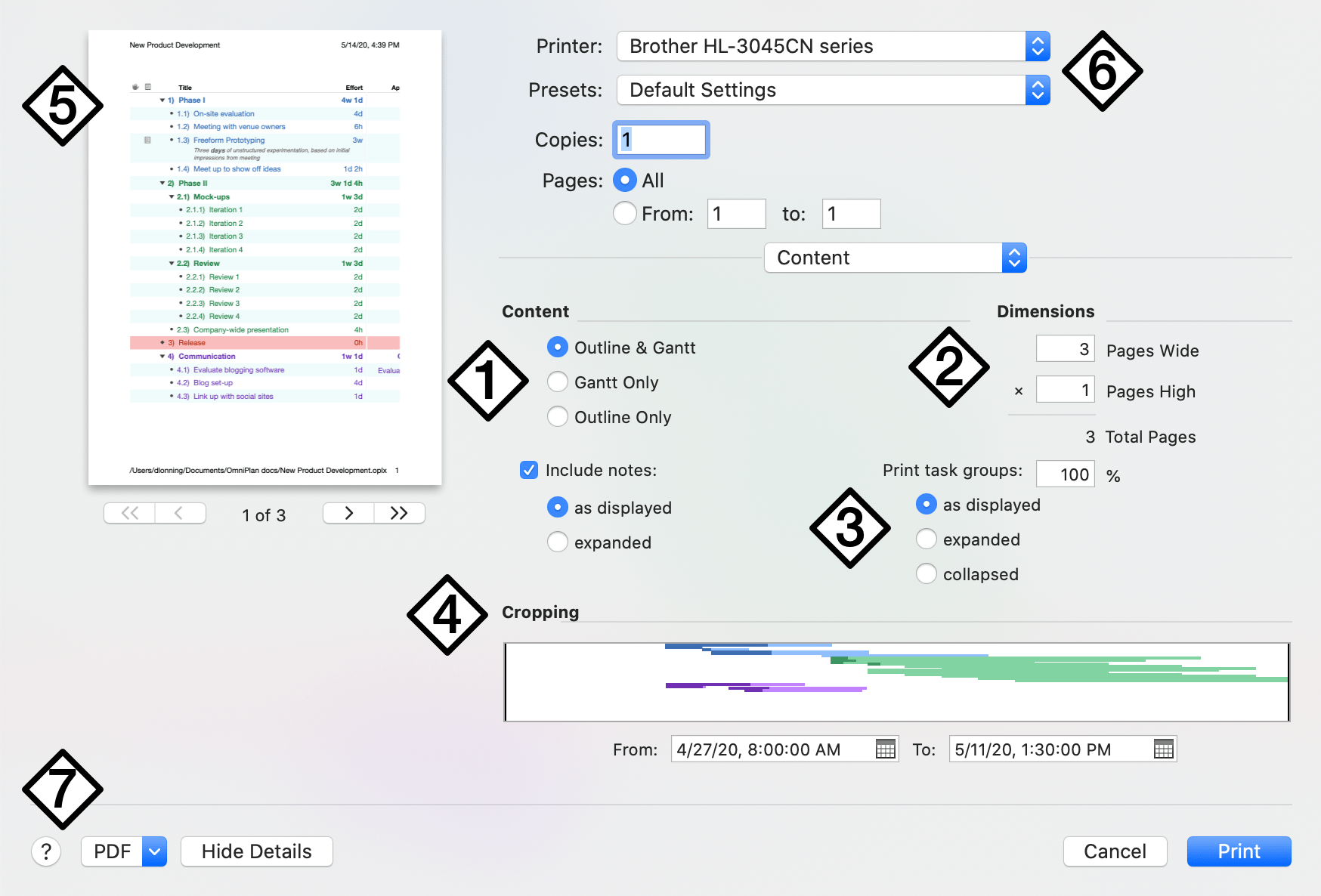
-
You can print the Gantt View, the Resource View, or the Network View—whichever one is open in the main window. In Task and Resource views you can choose whether to print the outline, the Gantt chart or resource diagram, or both; since Network View has no outline, you are taken right to the headers and footers section instead.
-
The dimensions are calculated based on the size of the project and the scale set in the percentile field here. When you change the width or height, the other one changes accordingly. Note that this overrides the Scale setting in the Page Setup dialog. When printing in Network View, a Scale percentage setting is available in the headers and footers section.
-
You can choose whether to include notes when printing from the outline, either as displayed or all expanded. Task and resource groups can be printed as displayed in the project, or all expanded or collapsed.
-
You can use the Cropping settings to chop off any part of the project you don’t need. An overview of your project is here. To define the area to print, resize the cropping box by dragging its left or right edge, or move the box by draging its center. If you enter dates in the From and To fields, the cropping box updates to match.
-
The preview shows what your project will look like on paper. Use the buttons to step through the pages and get an idea of the scale and layout.
-
When you have your print options set up the way you like, you can use the Presets menu to Save Current Settings as Preset. You can choose whether the preset applies to the currently selected printer or all printers, and view and edit your new preset—along with others—from Show Presets in the Presets menu.
-
As with other applications that use the macOS printing system, you can “print” to a PDF file instead of to real paper.
When printing from Network View, the scale of the diagram in the view itself determines the initial scale at which it will be printed via the print dialog. You can edit this with the Scale control in the print dialog, or by changing the scale in Network View (Use (-) and (+) or the zoom controls in the bottom right corner of Network View to zoome out and in).
In addition to the print dialog options described above, OmniPlan supports the standard macOS Page Setup dialog; choose Page Setup from the File menu to access it. You can set the paper size, print orientation, and document scale here; this information is saved with the document.
Customizing Headers and Footers
Headers and footers can be customized extensively for printing by choosing Headers & Footers from the dropdown menu in the Print dialog’s detail view.
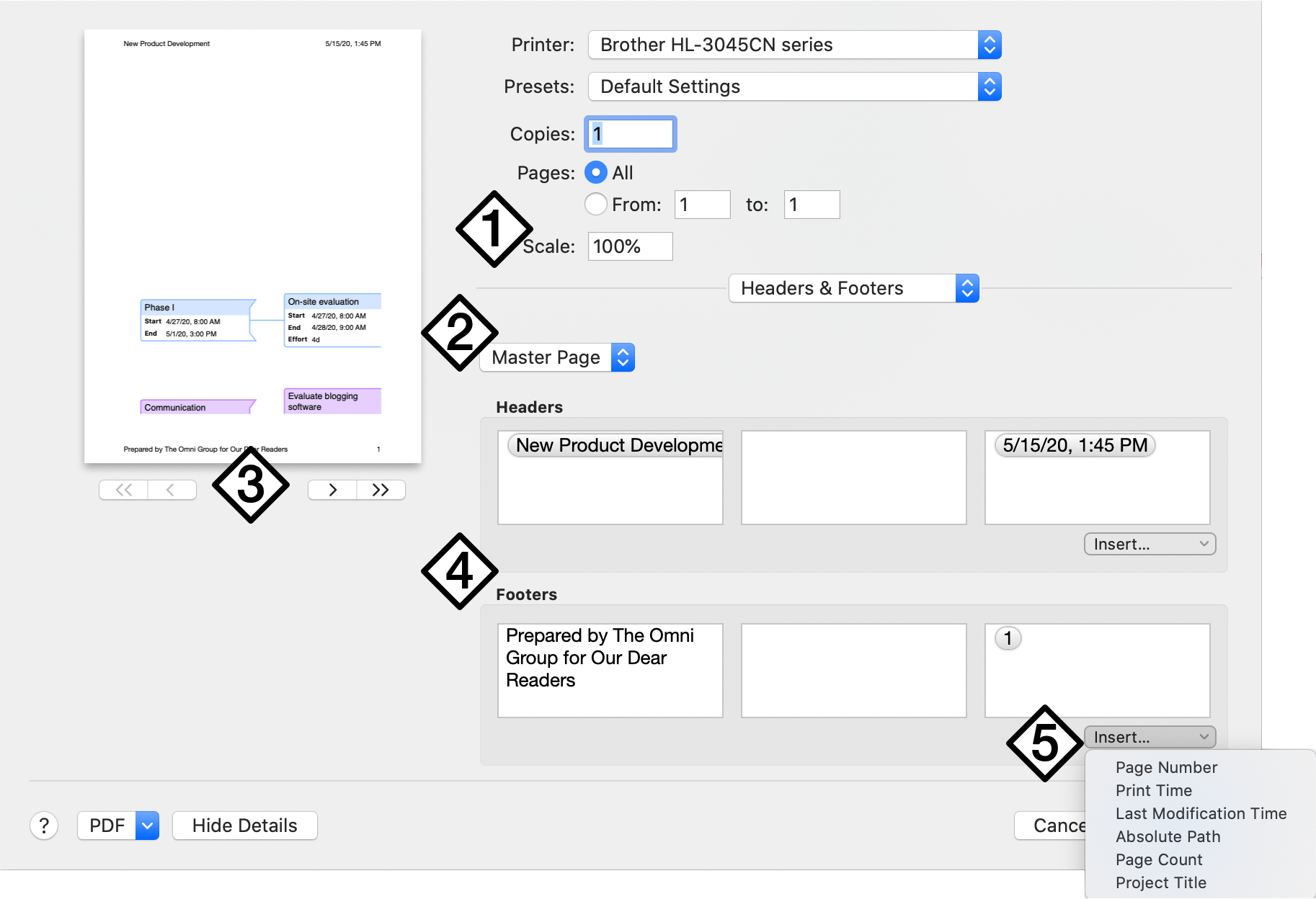
-
This Scale setting appears when printing from Network View, and controls the scale (as a percentile) at which the document is printed relative to its original size.
Scales for printing from Task and Resource Views are defined in the Dimensions section of the print dialog’s Content details.
-
Use this menu to choose where custom headers and footers will appear in your printed document. Options include the Master Page (applied to every page printed, unless overridden by another page style), the First Page, Odd Pages, and Even Pages.
-
As you update your custom headers and footers, changes are reflected in the print preview to give you an idea of how your document will look on paper.
-
The header and footer sections each have three fields that can be customized: left, right, and center-justified. You can enter custom text here, or:
-
Use the Insert menu to add information automatically derived from your document to a header or footer field. These automatically generated attributes include:
- Page Number—The current page as scheduled to be printed based on other configuration choices.
- Print Time—The computer clock-derived time when the document goes to press.
- Last Modified—The date and time when the document was last modified.
- Absolute Path—The location of the document in your computer’s file system.
- Page Count—The total number of pages in the printed document.
- Project Title—The name of the project file.
If you print the project while a filter is on, only the visible tasks are included in the printed copy.
Using the Report Window (Pro)
Choose File > Report (Option-Command-R) to bring up the Reports interface.
The tabs across the top of the window provide an array of options for presenting data on your project’s status, from an overview of the entire project to focused reports on tasks and resources, and with OmniPlan Pro, EVA budget estimations and simulated projections for milestone completion.
You can print the chosen report with a preset or custom-styled HTML template straight from this window.
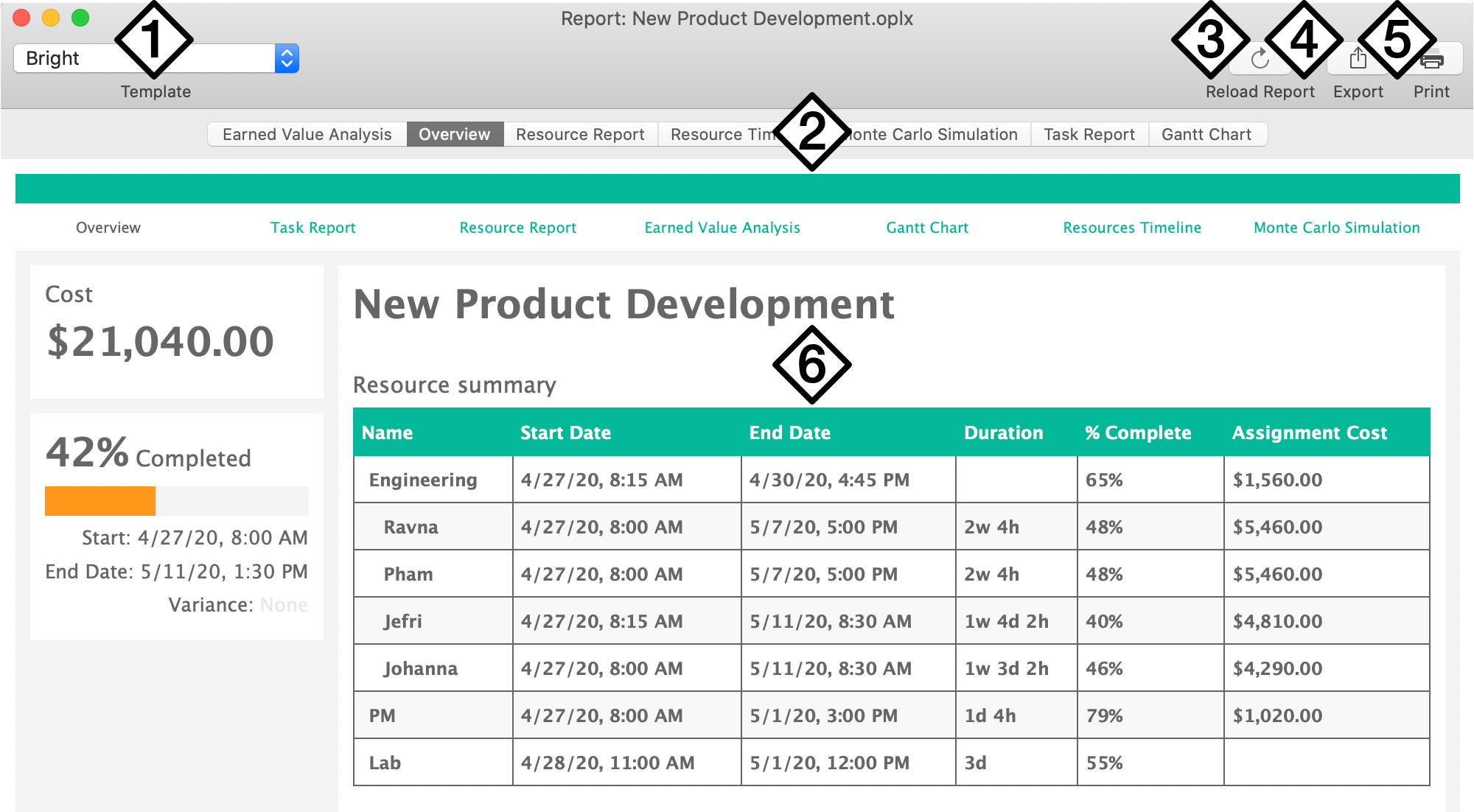
-
Use the dropdown menu to choose the template you would like to use to print or export your project.
-
Use the controls in this bar to browse the available report types in the current template. You’ll see the report types listed in the body of the report as well—this is to provide navigation internal to the report when it’s exported as HTML.
Available report types include:
- Project Overview—An overall project status report, highlighting project variance, completion percentage, and cost.
- Task Report—A report on the status of project tasks, as shown in the outline of Gantt View.
- Resource Report—A report on the status of project resources, as shown in the outline of Resource View.
- Earned Value Analysis—A report on the earned value of tasks in your project, as shown in the outline of Gantt View.
- Gantt Chart—An image-based snapshot of the current status of the Gantt View’s Gantt chart.
- Resource Timeline—An image-based snapshot of the current status of the Resource View’s timeline.
- Monte Carlo Simulation—A report including simulation results estimating the best, worst, and expected cases for cost and completion time of the milestones in your project.
-
Use the Reload Report button to generate an up-to-date version of the report based on any new changes made to your project.
-
Use the Export button to generate a PDF or HTML exported copy of your full project report (including all of the report types available). Details on the contents of an HTML Full Report can be found below.
-
Use the Print button to print the currently selected report type using the standard macOS print dialog options. The option to save the print output as a PDF file is also available here.
-
This is the HTML preview of your report, representing how it will appear when exported.
When you choose Export > HTML Full Report from the Report window, you’ll have the option to pick a location in Finder to save the report.
Upon saving, a folder is created that contains a full report of the project in HTML format. Depending on the template used for export, the following items may be included:
- HTML files corresponding to each type of report previewed in the Report Window (Overview, Task Report, Resource Report, Earned Value Analysis report, Gantt Chart, Resource Timeline, and Monte Carlo Simulation).
- A folder labeled calendars that contains a Reminders checklist of the project’s milestones (in .ics format), and each resource’s tasks as Calendar events (also in .ics format).
- A folder labeled todos that contains Reminders checklists of each resource’s tasks.
- A folder labeled include that contains image assets and a .css file that describes the appearance of your report.
While both Apple Calendar events and Reminders checklists are exported using the same file format (.ics), macOS is smart about figuring out which one goes where, and will prompt you with the correct location to add your scheduled items when you double-click the file.
Once you have exported your full report, you can open and print individual pages in Safari, send Calendar events and Reminders to your team, or edit the CSS and HTML for a pixel-perfect representation of your project status.
Customizing Report Templates (Pro)
With some knowledge of HTML and CSS, you can make your own report templates for printing and exporting. Get started with your custom template in a few quick steps:
-
First, go to the Reports pane of OmniPlan Preferences.
-
To create a new template, select an existing template and choose Edit a Copy from the gear menu below the list.
-
Enter a name for the template and save it in a convenient location.
-
The new template opens in Finder; it is a folder of HTML and CSS files that you can customize to your liking.
When you have the template set up the way you want, you can manage it from the Reports Preferences pane and choose it in the Report Window as a template for printing and exporting.
Custom Template Tokens
HTML reporting templates use a special syntax for inserting data from your project. Open one of the HTML files in the text editor of your choice, and you’ll find standard XHTML interspersed with OmniPlan tokens that look similar this:
{@Token Name@}
These tokens are placeholders for data about the project as a whole. When the template is used to export an OmniPlan file, each token is replaced by the data corresponding to the token name.
A reference for the various available tokens follows:
Project Tokens
{@Date@}—The date of the export.{@Version@}—The version of OmniPlan that exported the report.{@Project Title@}—The title of the project, as set in the Project inspector’s Project Info section.{@StartDate@},{@EndDate@}—The start or end date of the project.{@StartTime@},{@EndTime@}—The start or end time of the project.{@Duration@}—The duration of the whole project.{@Completion@}—The completion percentage of the whole project, as calculated from all tasks.{@Cost@}—The cost of the whole project.{@ResourceData@}—Place this at the tr level of a table; for each resource it creates a row of three cells, containing the resource name, a link to an iCalendar file of the resource’s assignments as events, and a link to an iCalendar file of the resource’s assignments as to-do items.{@ProjectCalendarLink@}—A link to the Project Milestones calendar, if there are any milestones.
Stylesheet Token
{@ApplyStyleSheet include/style.css@}—This token applies a CSS stylesheet to the page, by specifying the path to the stylesheet. When the export happens, this token is replaced by one of two things:
If exporting a full HTML report, a link to the stylesheet as an external file. This lets all of the exported HTML files link to the same stylesheet:
<link rel="stylesheet" href="include/style.css" type="text/css" />
If exporting a single HTML page (a task list or resource list), an embedded copy of the stylesheet. This keeps everything in one HTML file:
<style type="text/css"> [...] </style>
Loop Tokens
These work like open/close HTML or XML tags. When the export happens, OmniPlan cycles through everything between the opening and closing tokens, inserting data about each task or resource. The Assignments loop has to happen inside the Resources loop, as it lists tasks that are assigned to a particular resource. Make sure that you include the closing token, and that your task-specific or resource-specific tokens are between the appropriate loop tokens.
{@Tasks@}and{@/Tasks@}—Lists all tasks in the export; inside this loop you can use task-specific tokens.{@Resources@}and{@/Resources@}—Lists all resources in the project; inside this loop you can use resource-specific tokens and Assignments loops.{@Assignments@}and{@/Assignments@}—Lists all assigned tasks for a resource; this can only be used inside the Resources loop. Inside this loop you can use task-specific tokens.
A handy option for a svelte template is to remove the {@Assignments@}{@/Assignments@} section from the Resources loop. {@Resources@} gives you each resource, while {@Assignments@} gives you each assignment for the current resource; if you omit the {@Assignments@} that leaves just the resource summary info. This is demonstrated in the index page of the built-in Printer Friendly template.
Tokens for Tasks
These tokens can be used inside the Tasks loop or the Assignments loop of a resource.
{@ID@}—The task’s number in the outline.{@Title@}—The task name.{@Full Title@}—The task’s full hierarchical title.{@Start@},{@End@}—The actual start or end time of the task.{@Time@}—The duration of the task.{@Effort@}—The effort value for the task.{@Effort Done@}—The amount of effort completed for the task.{@Remaining Effort@}—The amount of effort remaining for the task.{@Expected Effort Estimate@}—The estimated amount of effort expected to be required for task completion. Useful when using simulations to estimate milestone completion. See also the Monte Carlo Simulation Tokens section, below.{@Min Effort Estimate@}—The estimated minimum amount of effort required for task completion.{@Max Effort Estimate@}—The estimated maximum amount of effort required for task completion.{@%Done@}—The completion percentage for the task.{@Dependencies@}—A list of the task’s dependencies, in the same format as the Dependencies column in the task outline.{@Cost@}—The Cost of the task itself.{@Resources Cost@}—The cost of the assigned resources.{@Total Cost@}—The cost of the task and the assigned resources.{@Assigned@}—A list of assigned resources.{@Planned Start@},{@Planned End@}—The baseline start or end time of the task.{@Start Variance@},{@End Variance@}—The difference between the baseline and actual times for the start or end of the task.{@Constraint Start@},{@Constraint End@}—The constraint on the task’s start or end time, if any.{@Notes@}—Text of the task’s note, if any.{@Priority@}—The task priority, just like the column in the task outline.{@Status@}—Some words to describe the task’s due or overdue state, like the Status icons in the task outline.{@Violations@}—The number of violations that involve this task.
Custom data keys that you have created for your project can be included in templates. If you add a token that exactly matches the name of one of your custom data keys, it is converted to the value of that key for the given task. For example, if you have a “Location” key for your tasks, you can use a {@Location@} token in your template.
Any column names not listed above can be converted to tokens in this manner as well.
Tokens for Resources
These tokens can be used inside the Resources loop.
{@Resource@}—The resource name.{@Start@},{@End@}—The actual start time of the resource’s earliest assignment, or end time of the resource’s latest assignment.{@Time@}—The total duration of all tasks assigned to the resource.{@%Done@}—The completion percentage of all tasks assigned to the resource.{@Resources Cost@}—The total cost of assigning this resource to its assigned tasks.{@Resource Type@}—The type of resource (Staff, Equipment, Material, or Group).{@#@}—The “total units” value of the resource.{@Notes@}—Text of the resource’s note, if any.{@Efficiency@}—The resource’s efficiency value.{@Cost/Use@},{@Cost/Hour@}—Cost per use and cost per hour values as defined in the Resource Info section of the Resource inspector.{@Total Uses@},{@Total Hours@}—The total number of assignments, or total amount of effort assigned, for the resource.{@ResourceCalendarLink@}—A link to the resource’s assigned tasks as an iCalendar file of events, if it has any tasks assigned.{@ResourceToDoLink@}—A link to the resource’s assigned tasks as an iCalendar file of to-do items, if it has any tasks assigned.- Custom data keys—If you include a token that exactly matches the name of one of your custom data keys, it is converted to the value of that key for the given resource. For example, if you have a “Phone Number” key for your resources, you can use a
{@Phone Number@}token in your template.
Path Tokens
These provide the path to a particular page in the HTML export. You can use these to create links between pages; for example:
<a href="file:{@TaskReportPath@}">
{@TaskReportPath@}—The file path to this HTML export’s Task Report page.{@ResourceReportPath@}—The file path to this HTML export’s Resource Report page.{@ResourceTimelinePath@}—The file path to this HTML export’s Resource Timeline image.{@GanttChartPath@}—The file path to this HTML export’s Gantt Chart image.{@ProjectCalendarPath@}—The file path to this HTML export’s Project Milestones calendar.
Earned Value Analysis Tokens
These tokens correspond to the columns employed in the outline of Gantt View by the Earned Value Analysis feature.
{@ev_budgetedCostOfWorkScheduled@}—The budgeted cost of work scheduled; represents the Planned Value column in the Task outline.{@ev_budgetedCostOfWorkPerformed@}—The budgeted cost of work performed; represents the Earned Value column of the Task outline.{@ev_actualCostOfWorkPerformed@}—Actual cost of work performed; represents the Actual Cost column of the Task outline.{@ev_costVariance@}—The cost variance between earned value and actual cost; represents the column by the same name in the Task outline.{@ev_scheduleVariance@}—The distance (in currency) from the planned value; represents the column by the same name in the Task outline.{@ev_estimateAtCompletion@}—Estimate at completion; represents the column of the same name in the Task outline.{@ev_budgetedAtCompletion@}—Budgeted at completion; represents the column of the same name in the Task outline.{@ev_varianceAtCompletion@}—Variance at completion; represents the column of the same name in the Task outline.{@ev_costPerformanceIndex@}—The cost performance index; represents the column by the same name in the Task outline.{@ev_schedulePerformanceIndex@}—The schedule performance index; represents the column of the same name in the Task outline.{@ev_costVariancePercent@}—The cost variance percent; represents the Cost Variance % column in the Task outline.{@ev_scheduleVariancePercent@}—The schedule variance percent; represents the Schedule Variance % column in the Task outline.{@ev_toCompletePerformanceIndex@}—The “to complete performance” index; represents the column of the same name in the Task outline.
Monte Carlo Simulation Tokens
These tokens correspond to values used in computing Monte Carlo simulations to estimate milestone completion. They don’t run simulations themselves; rather, they use the most recently computed results for your project.
{@Milestones@}and{@/Milestones@}—Repeats a template for each milestone in the project.{@chainCost@}—The cost of the entire prerequisite chain up to this task or milestone.{@mc_minimumCost@}—The lowest chainCost for any Monte Carlo simulation run.{@mc_averageCost@}—The average chainCost for every Monte Carlo simulation run.{@mc_maximumCost@}—The highest chainCost for any Monte Carlo simulation run.{@mc_earliestCompletion@}—The earliest date completed for any Monte Carlo simulation run.{@mc_fiftyPercentCompletion@}—The date on which 50% or more of simulations completed.{@mc_latestCompletion@}—The latest date completed for any Monte Carlo simulation run.
Working in the Cloud
If you are solely responsible for changes to your project files and you use OmniPlan on multiple devices, you can take advantage of cloud-based storage services to keep your OmniPlan files in sync across both Mac and iOS.
Files created with OmniPlan 4 can safely be stored with most popular cloud services. For the best compatibility with files from all versions of OmniPlan, we recommend syncing with the Omni Group’s OmniPresence service or Apple’s iCloud Drive.
This chapter describes the features of OmniPresence along with other cloud storage options available.
Using Third Party Cloud Storage
OmniPlan supports cloud syncing with most popular storage providers.
Not all sync services are created equal, and syncing with any remote server carries some risk. If you plan to sync your OmniPlan files with a third party service, it can help to choose the file type that works best for your service of choice.
-
OmniPlan documents created with OmniPlan 4 use the flat file document type by default, and can be safely stored with most cloud services.
-
OmniPlan’s older package file type is not supported by services such as Dropbox, Google Drive, OneDrive, and Box. Attempting to sync with these services will result in version conflicts. If you are syncing package files, we strongly recommend using either Apple’s iCloud storage or our own OmniPresence, which both support a wider array of file features.
If you experience issues syncing a particular project file, you can change its document type in the Project Document inspector to better suit the needs of your cloud service.
Using OmniPresence Cloud Storage
OmniPresence is a free cloud utility developed by the Omni Group for keeping your files in sync across devices.
-
On your Mac, OmniPresence is an application that runs in the background, watching a connected folder. It makes sure the files inside are in sync with files in the cloud (a WebDAV server of your choice), and with your OmniPresence-enabled iOS apps.
-
On iOS, OmniPresence is built in to all of the Omni Group’s document-based apps, including OmniPlan. You can access OmniPresence folders and files from within each application’s document browser.
When connected to the same folder, all of your OmniPresence-enabled devices detect changes when you make them, and constantly sync up to keep your files up to date.
To get started with OmniPresence on your Mac, download OmniPresence for Mac from the Omni Group website.
OmniPresence sync (and cloud storage in general) is not a replacement for the multi-user collaboration features of in OmniPlan Pro. OmniPresence exists as a cloud storage space to keep files up to date between devices; it doesn’t track changes to those files, doesn’t support publishing actions, and is not intended for multiple users to access simultaneously.
If your project requires editing by multiple contributors, consider the collaborative features offered in the Pro upgrade.
Using OmniPresence With Omni Sync Server
Omni Sync Server is our own custom cloud server that functions as a central hub for all your syncing needs, and it is one option for OmniPresence to connect to when shuttling files between your Mac and iOS devices.
Unlike other compatible cloud servers, since we control the server hardware and software we are able to provide better advice should you run into trouble when syncing.
With Omni Sync Server, we never ever look at your data without your permission. Beyond that, you can rest assured that your data is private and secure on Omni Sync Server. Read more about our privacy policy here.
To use Omni Sync Server, you’ll first need to sign up for a free Omni Account. If you don’t have one, head over to our website and sign up, then follow the instructions in the email that you receive from there.
Using OmniPresence With a Private Server
We understand that sometimes you want to keep your data on your own server. This could be due to company policy, for legal reasons, or your desire to be in charge of backing up everything that is important to you.
If you don’t want to use Omni Sync Server, OmniPresence is capable of connecting to any WebDAV server you choose. This could be one that you run on your own hardware, or a third-party service that you rely on.
Omni is not able to provide direct support for servers run by third parties, so we recommend a good understanding of system administration if you plan on running one yourself.
If you do choose to run your own WebDAV server, this support article on our website provides some pointers for getting things set up.
How OmniPresence Works
With OmniPresence turned on, the WebDAV server you designate (either Omni Sync Server or your own or a third-party WebDAV server) manages synchronization so that your files are always up to date. With each subsequent sync, OmniPresence compares your local files and applies any differences to your files on the server. This ensures that your files are not just up to date, they’re available wherever—and whenever—you need them.
We’ve also built in an automatic sync mechanism. When you save an OmniPlan file to an OmniPresence-enabled folder (or when an Auto Save occurs), OmniPresence updates the file on the sync server. At a bare minimum, OmniPresence checks in with Omni Sync Server every hour and compares files in your sync folder. If nothing has changed, OmniPresence quietly goes back to watching over your files. This helps ensure that your OmniPlan files are always safe, secure, and most importantly—up to date.
Multi-User Collaboration (Pro)
On a large project, or one where resources are spread across different teams and projects, you may want to provide access to the project document so team members can check their status and update the project remotely. Alternatively, you may want to connect the project to a calendar account—either to publish work hours to it, or subscribe to calendar events representing a resource’s schedule. With the sync and sharing options in OmniPlan Pro, you have the flexibility to administrate your project in the way that best fits the needs of your team.
Choosing a Host Server
Before you begin sharing your OmniPlan projects you’ll want to make sure you have a server ready to act as a centralized repository for your files. Syncing a local copy of your project with the copy on the server—or to a calendar on a calendar server—is what makes sure everyone sharing the file is up to date with all of the latest changes.
If you don’t have a server set up and would like a free, secure option, you can create an Omni Sync Server account to host your shared OmniPlan projects.
Omni Sync Server is a hosting solution that meets the needs of most users. If your project has more stringent data security requirements, you can set up a private WebDAV server that you wholly administrate to act as the host for your shared projects instead.
Once you have a server in place, use the walkthrough in the following section to connect to your first sync account. From there you can either begin collaborating on projects already hosted by the server, or start hosting new projects by configuring their Sync & Sharing Options.
Setting Up A Server Account
There are two things you need to establish in order to collaborate with others on an OmniPlan project: your app-wide server account settings, and the sharing settings for the individual project file. These features are grouped around their respective themes in the OmniPlan-wide Server Accounts window (described here) and in a project’s individual Sync & Sharing Options.
The Server Accounts window (OmniPlan > Server Accounts) is where you’ll associate new server accounts with OmniPlan, manage your existing accounts, and view and retrieve project files from your servers.
When you connect to a server account for the first time, the window presents a guided setup mode for choosing the account type and entering the relevant login information. To add additional accounts after the first, click the Add Account (+) button in the lower left of the window.
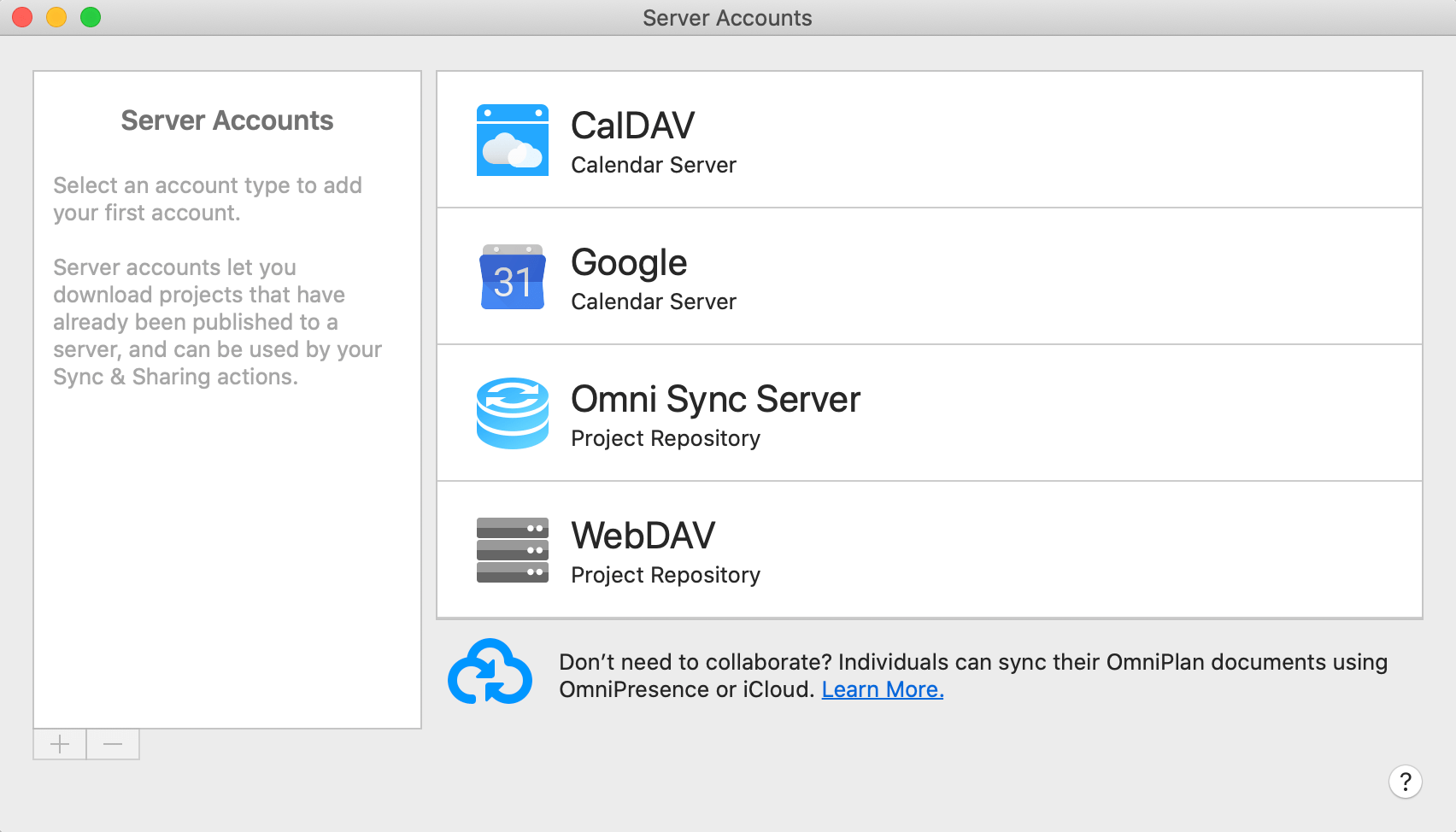
If you are setting up a server account for collaboration, choose either Omni Sync Server or WebDAV. If you are adding or retrieving work hours from a synced calendar account, choose CalDAV or Google Calendar (depending on the account type).
Once you have an account connected, it appears in the list on the left side of the window.

If you are connecting to a server account that already hosts existing projects, the project files it contains appear in the list on the right. Select a project in the list and click Download Project to make a local copy. The file opens, ready for collaboration—you can now publish changes to the server, and refresh your local copy with any changes made by other contributors.
Once you have downloaded a project file from a shared server repository, that copy of the file is the only one you should use for making updates and tracking changes. Downloading additional copies to the same Mac risks creating conflicts when merging changes back to the server.
If you are setting up sharing for the first time and don’t have any projects synced remotely, the project list will be empty. The Setting Up Sync and Sharing walkthrough below will guide you through publishing your first project to the server.
With a Google Calendar or CalDAV account selected, the list displays the calendars available on the server instead. Publish and refresh actions can be set up to pull scheduling information from these calendars rather than updates to the project’s status.
Managing Server Accounts
Once you have a server account set up and have begun publishing and subscribing to projects or calendars, you can use the Server Accounts window to manage your repository accounts and shared projects. Choose OmniPlan > Server Accounts to see and manage your shared OmniPlan projects.
The Accounts list shows your Omni Sync Server, WebDAV, CalDAV, and Google Calendar accounts by name. Choose an account in the list to see the projects or calendars it contains. To add an account, click the Add Account (+) button below the list. To edit an account, select it and click Edit Account.
With an Omni Sync Server or WebDAV account selected, the list shows all projects that have been published to the repository, and the following information about them:
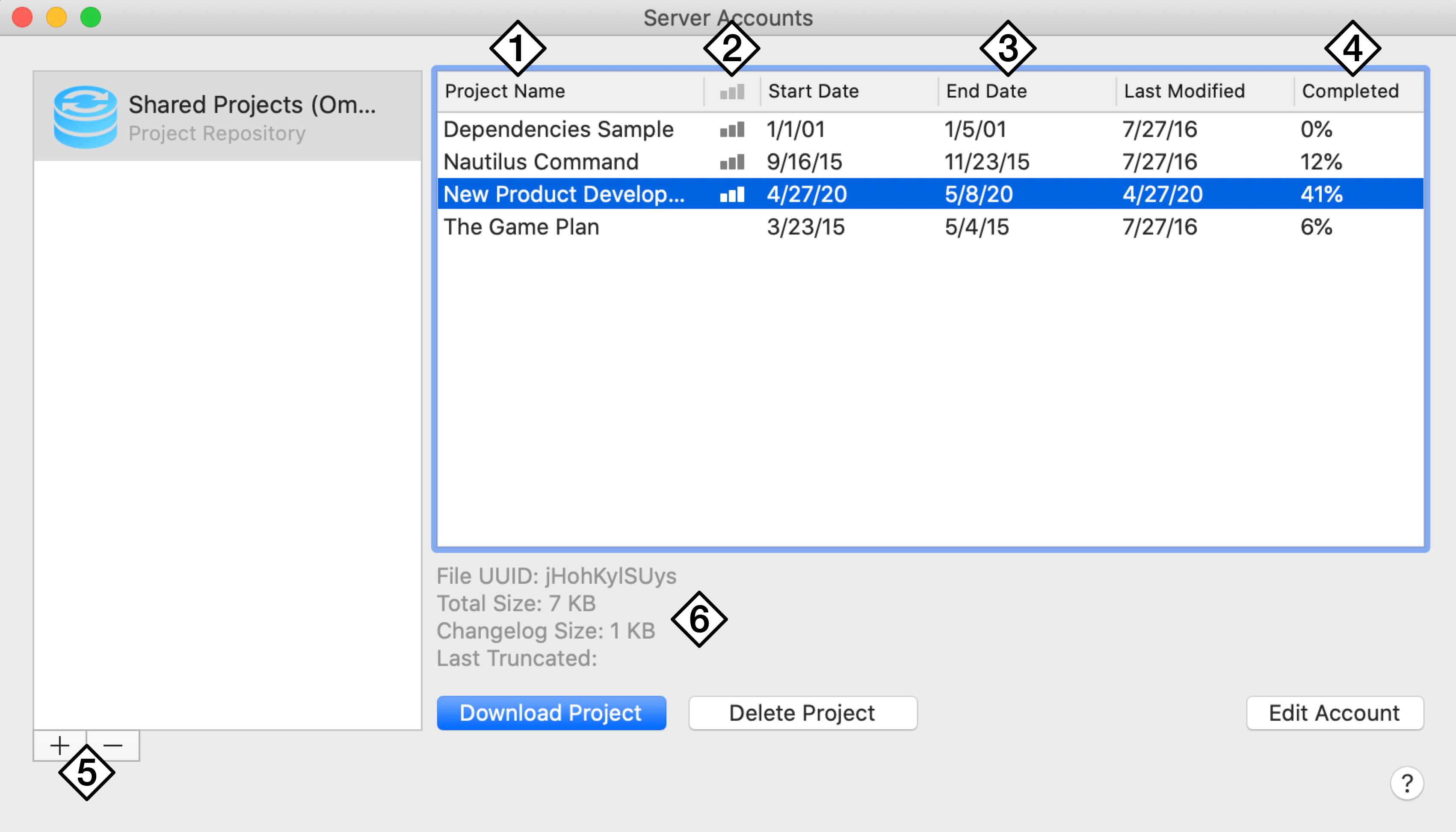
-
Project Name—The name of the project file.
-
Load—This column indicates, by the presence of a vertical bar graph icon, whether the project shares its resource load information with other projects in the repository for the purposes of leveling resources across projects.
-
Start Date, End Date, Last Modified—The dates when the project is scheduled to start and end, and the date it was last modified by any user with shared access to it.
-
Completed—The percentage of overall work on the project that has been completed.
-
Add Account, Remove Account—Click the Plus button here to add a repository account, and the Minus button to remove an existing account. Removing an account doesn’t delete its contents on the server; it only deletes it from the list of servers you have connected to OmniPlan.
-
File Metadata—This section displays information about the project file: its unique ID, its size, the size of the associated changelog file (for change tracking), and when the file was last truncated.
With a Google Calendar or CalDAV account selected, the list displays the calendars available on the server instead.
Setting Up Sync and Sharing
Once you have a server account set up, you can begin syncing your project files to collaborate with other project contributors. You are able to choose sync actions for each project individually using its Sync & Sharing Options sheet (Project > Sync & Sharing Options).
For this walkthrough we will assume you are starting with a brand new server account (set up in the Server Accounts window above) and a fresh project that you want to work on collaboratively with others. You’ll be publishing changes you make to your shared server, which other editors will subscribe to (and vice versa).
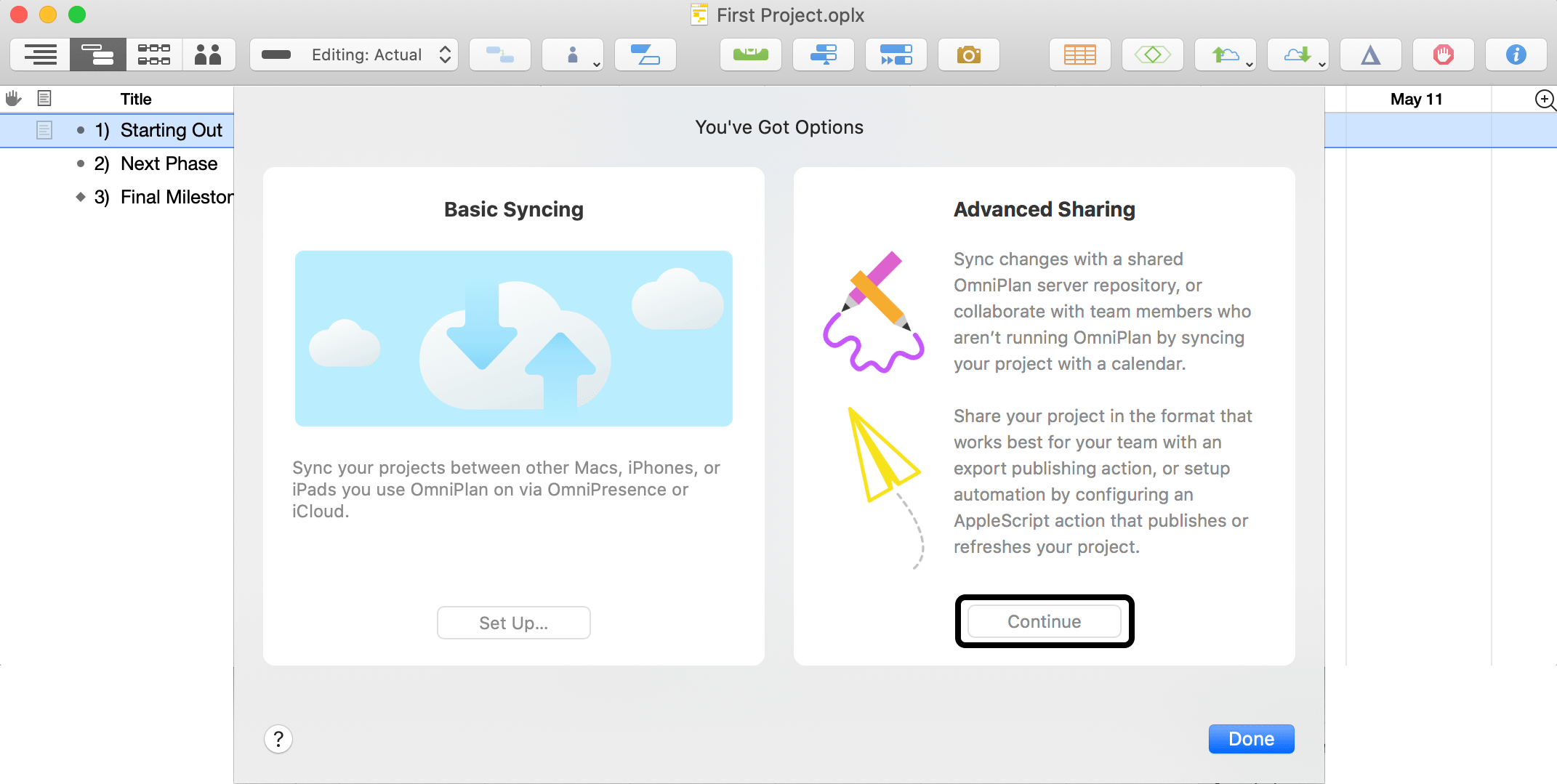
When you first set up sync and sharing for a project, you’ll see two options: Basic Syncing and Advanced Sharing. If you choose Basic Syncing you’ll be directed to the setup process for OmniPresence or iCloud storage—two great options if all you need is a remote place to keep your files.
Since this example has multiple contributors, we’ll choose Advanced Sharing instead. Click Continue to set up sharing for the project.
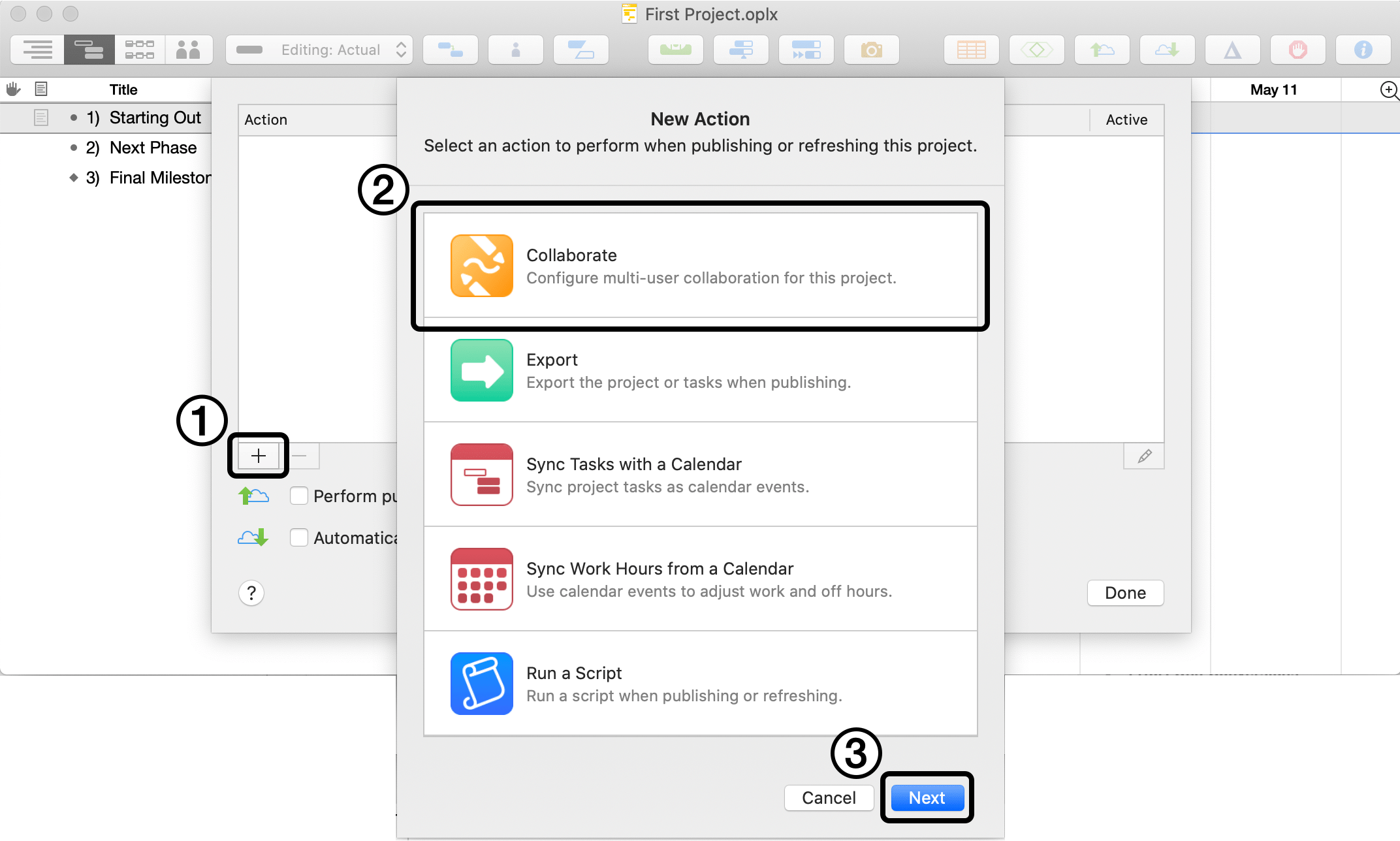
The list of share actions for your project starts out blank. Click the Plus button ① to add a new one and choose from among the available action types. You’ll see that you can perform a variety of automated tasks when sharing (publishing) your project; we’ll focus on collaboration for now. Choose Collaborate ② as the action type, then click Next ③.
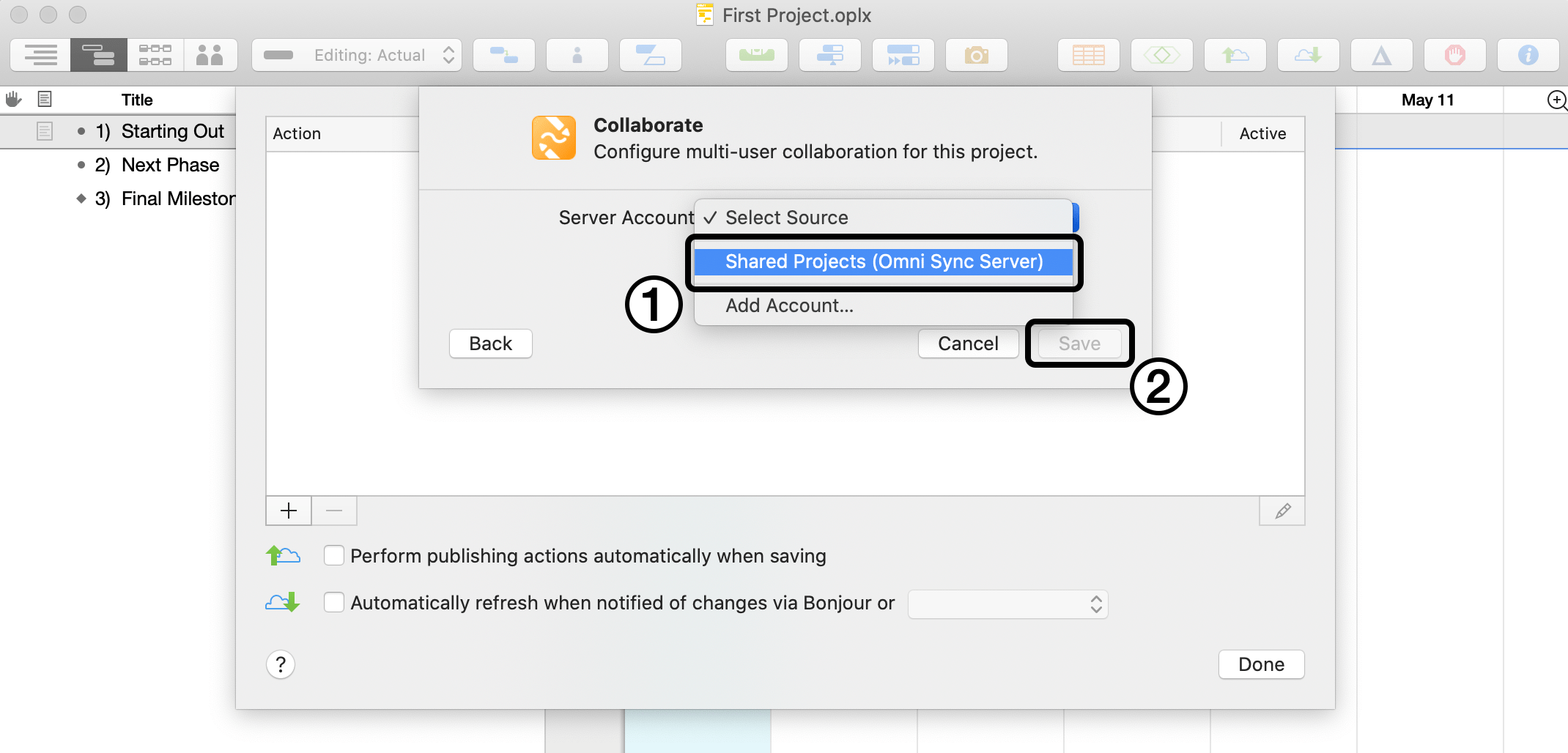
To collaborate on this project it will have to be stored on a server so others can access it. If you set up an account with the Server Accounts window, click Select Source ① and choose it from the list (if not, you’ll want to set one up now and come back to this step). After choosing your account, click Save ②.
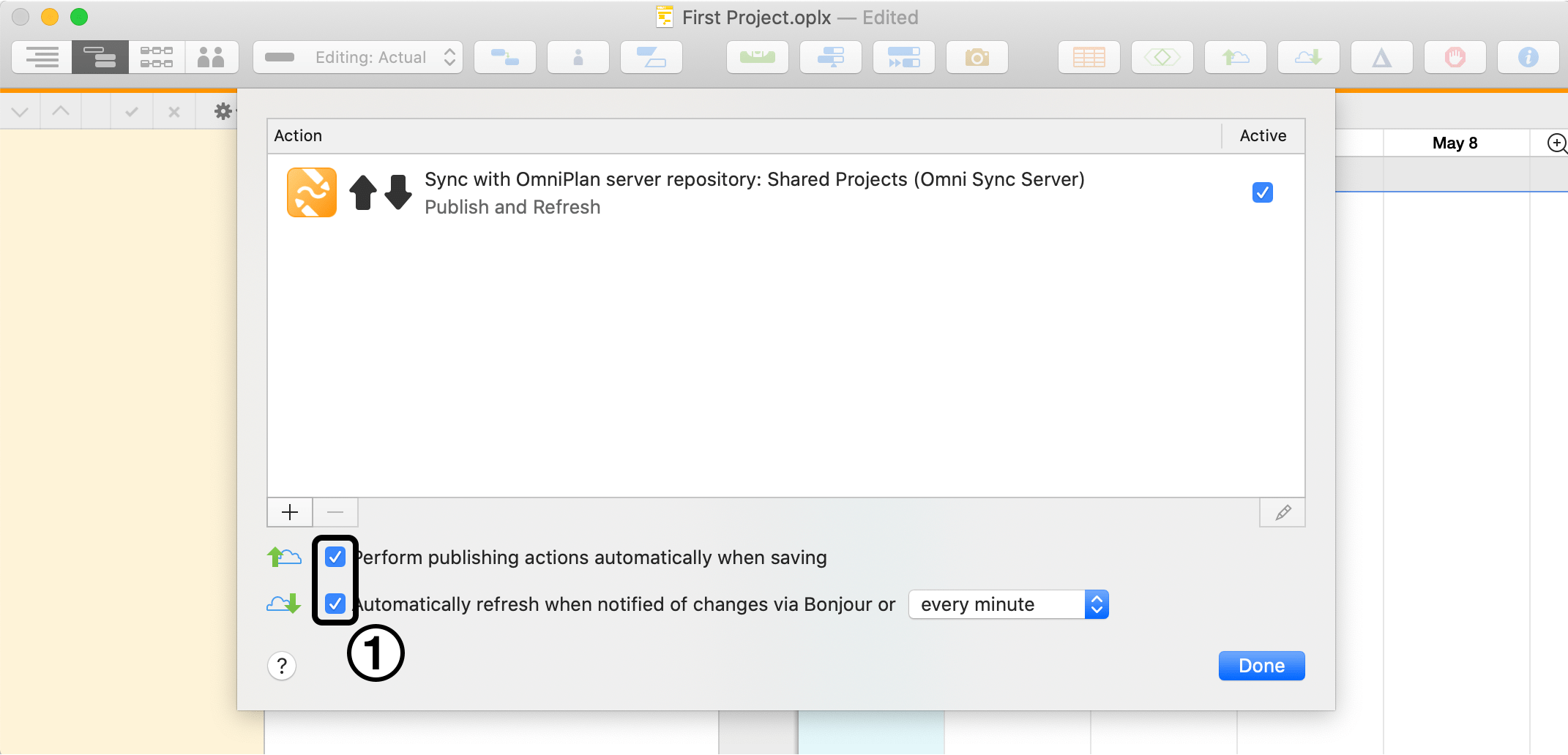
Your Sync & Sharing Options sheet now contains an active action for publishing to, and refreshing from, your shared server repository. To edit details of the action, select it and click the Pencil edit button at the bottom of the actions list. Use the checkboxes below the list ① to choose what prompts the project to publish or refresh its status.
Click Done, then save the project. If you selected Perform publishing actions automatically when saving, the project is published to the server for the first time. Otherwise, choose Project > Publish (Control-Command-P) to publish it manually.

The next time you check the Server Accounts window you’ll see the project listed in your account. Subsequent changes you make are published to the server based on the settings you chose in Sync & Sharing Options, and you can monitor those changes—any incoming from other editors who have similarly connected to your project—using change tracking (Project > Show Changes).
You can publish your local version of the project to the server by choosing Project > Publish (Control-Command-P), or by clicking the Publish button in the toolbar.
You can refresh manually from the server at any time by choosing Project > Refresh (Control-Command-R) or the Refresh toolbar button.
Sync and Sharing Configuration Options
Use the Sync and Sharing Options sheet (Project > Sync & Sharing Options...) for each project you want to share to configure publication and subscription actions to suit the needs of that project. The Setting Up Sync and Sharing section above provides a walkthrough for setting up your first Collaborate action; this section and those following it offer more information on the other Share actions available.
The Sync & Sharing Options sheet provides an overview of the sharing actions you have set up for the current project, and includes tools for adding, removing, and editing those actions.
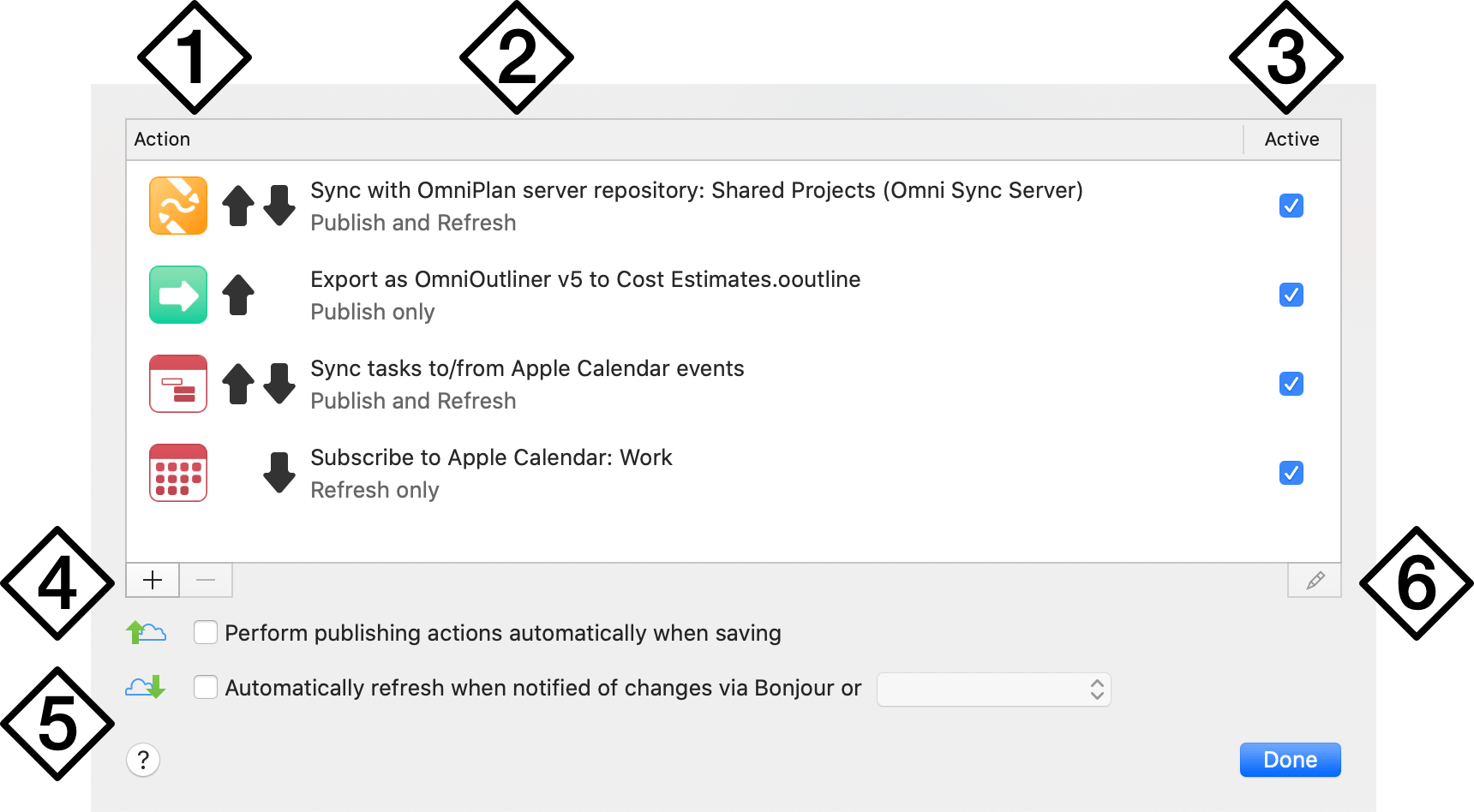
-
Action Type and Direction—The icon shows the type of action for the row, and the arrows next to it indicate whether the action occurs on Publish (the up arrow), Refresh (the down arrow), or both.
-
Action Description—The text in the center of each action row describes the action, and notes whether the action occurs on Publish, Refresh, or both.
-
Action Active Status—The rightmost column contains a checkbox that indicates whether the action is currently in use. Deselect it to exclude the action from occurring when it normally would.
-
Add and Remove Action—Click the buttons here to add a new action (plus) or delete a selected action (minus). Deleting an action removes it from the project entirely. To temporarily disable it instead, deselect its active status checkbox.
-
Publish and Refresh Options—Choose whether to perform publishing actions automatically when saving the project file, and choose whether to automatically update when notified of changes via Bonjour or a specified timeframe from the pop-up menu to the right. These options apply to all actions set up for the project.
-
Edit Action—Further options for each action are available; choose the action in the list and click this button to open and edit the action details.
Collaborate Action Options
When creating or editing a Collaborate action, the following options are available:
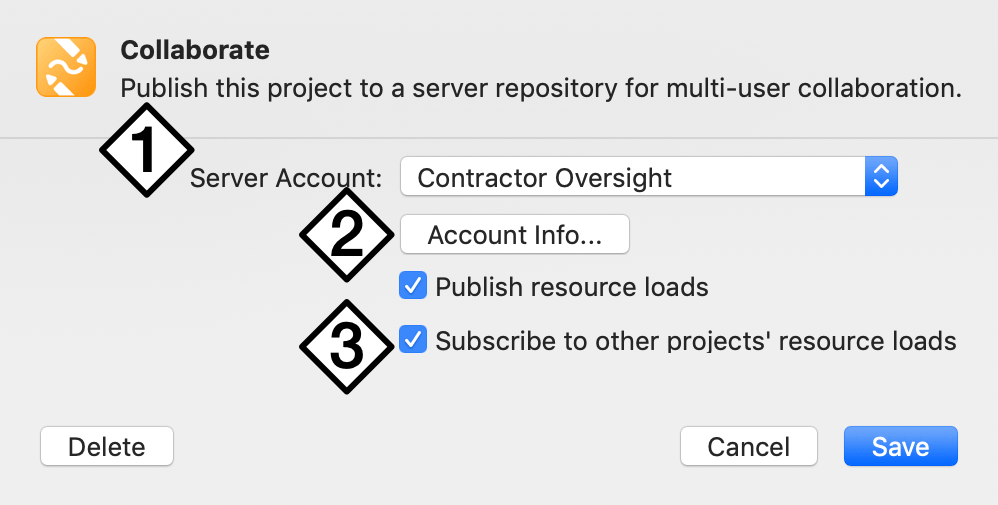
-
Server Account—Choose the server account to publish and subscribe to from this dropdown menu. The menu lists all of the accounts you have set up in the Server Accounts window.
-
Account Info—Open a sheet with login details for the sync account associated with the action.
-
Resource Load Sharing—Choose whether to share the project’s resource loads with other projects on the server, and choose whether to respect the resource loads of other projects on the server when leveling.
A project file can sync with a single server repository at a time, and therefore can only have one collaborate action assigned to it.
Export Action Options
When creating or editing an Export action, the following options are available:
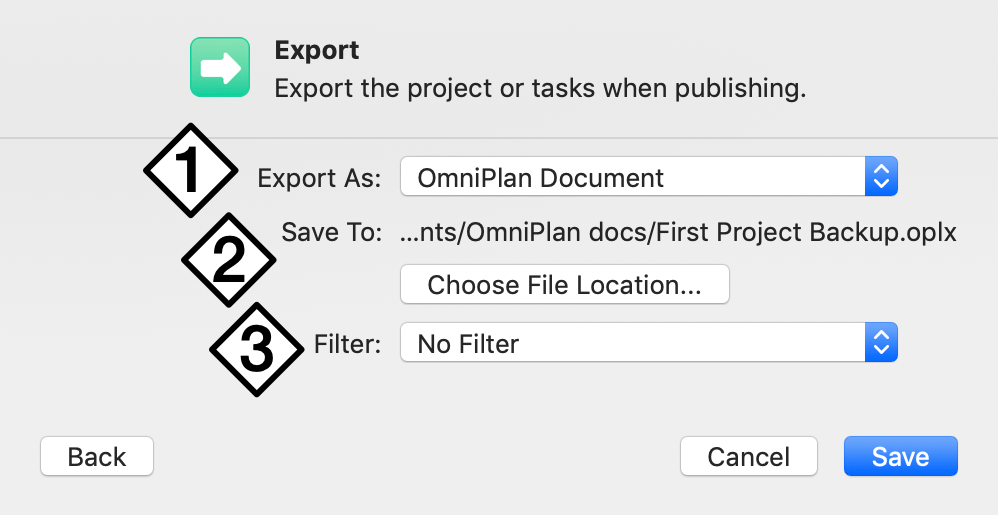
-
Export As—Choose a file format to export from this dropdown menu. The list of formats includes all of those available from File > Export, as well as the default native OmniPlan file format.
-
Save To—Choose a name and location for the exported file.
-
Filter—Set up or choose a custom filter to apply when exporting the project file. Any items excluded by the terms of the filter will not appear in the exported version of the project.
Export actions occur solely on publish.
Sync Tasks With A Calendar Options
When creating or editing a Sync Tasks with a Calendar action, the following options are available:
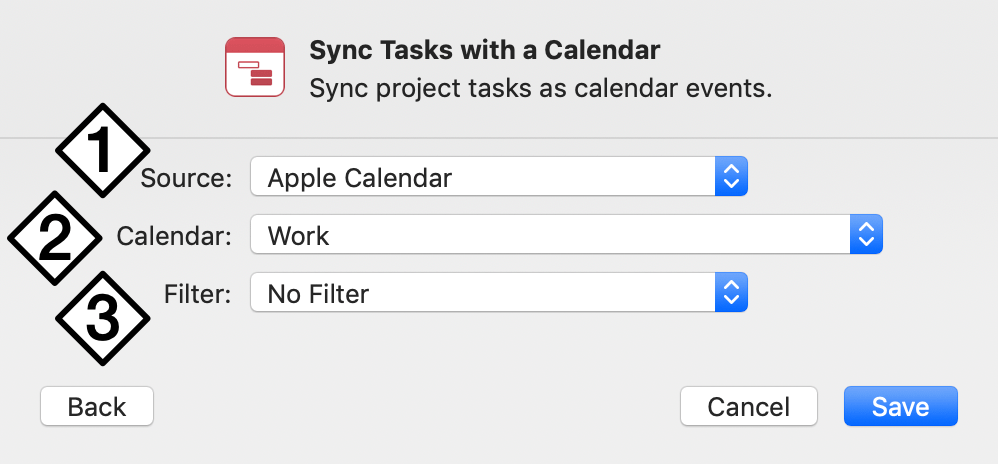
-
Source—Choose an existing calendar source from this dropdown menu, or choose Add Account to open a sheet where you can choose a CalDAV or Google Calendar server to add as a new calendar source.
-
Calendar—With a source selected, use this dropdown menu to choose the calendar you want to sync with.
-
Filter—Set up or choose a custom filter to apply when syncing tasks from the project file. Any tasks excluded by the terms of the filter will not appear in the synced version of the project.
If you didn’t choose to grant OmniPlan access to Calendar the first time you tried to create a Calendar-related publish or update action, you can grant it after the fact with System Preferences > Security & Privacy > Privacy.
Sync Work Hours From A Calendar Options
When creating or editing a Sync Work Hours from a Calendar action, the following options are available:
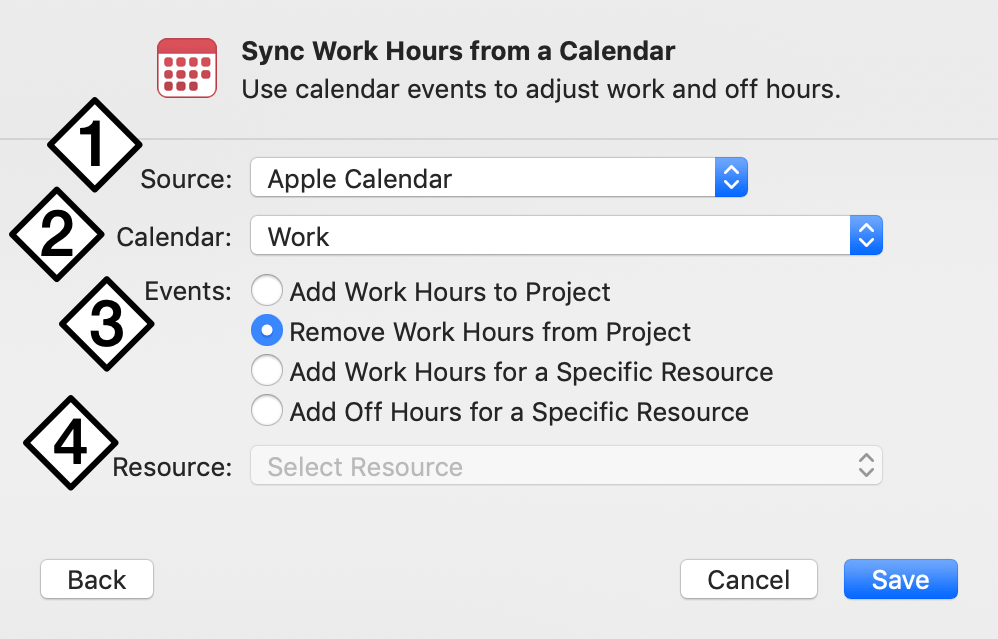
-
Source—Choose an existing calendar source from this dropdown menu, or choose Add Account to open a sheet where you can choose a CalDAV account to add as a new calendar source.
-
Calendar—With a source selected, use this dropdown menu to choose the calendar you want to retrieve events from.
-
Events—Choose what happens when events are retrieved from the calendar. Calendar events can either represent new work hours added to the project, work hours subtracted from the project, or additional work or off hours for a specific resource.
-
Resource—If you chose for calendar events to add work or off hours for a specific resource, choose the resource from the dropdown menu here.
Due to limitations in Calendar sync, OmniPlan is able to fetch data out approximately 11 months from the present when subscribing to events from a Calendar server.
Run A Script Options
When creating or editing a Run a Script action, the following options are available:
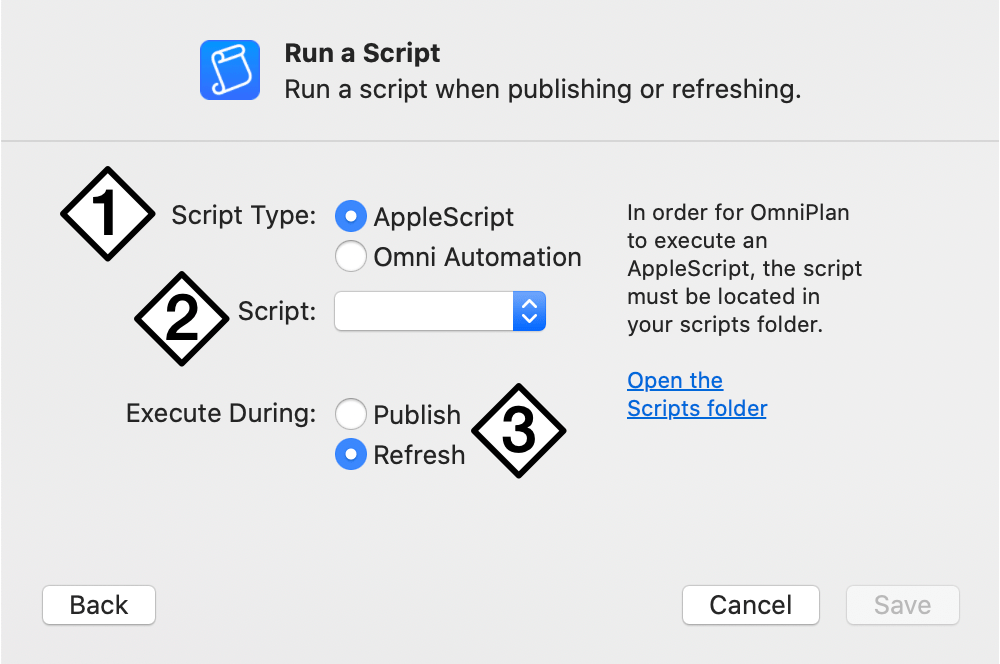
-
Script Type—Choose from between AppleScript and Omni Automation.
-
Script—Choose the script to run from this dropdown menu. The menu is empty until you add an AppleScript file to the OmniPlan Scripts folder, which is linked in the text next to this item.
When you choose the Omni Automation script type, this is replaced by two other dropdown menus labeled Plug-In and Action respectively. Choose an Omni Automation Plug-In using the first, and choose one of its actions to run using the second. The Plug-Ins folder is linked in the text to the right.
-
Execute During—Choose whether the script should run when publishing changes to the repository, or when refreshing to receive changes from the server.
Sharing A Project With Others
To connect other team members to your published project, you will need to provide them with the following information:
- Account Type: Either Omni Sync Server or WebDAV.
- The User Name and Password used to access the sync server account.
- The name of the file to which they will subscribe.
Team members will use that information to add an account in OmniPlan > Server Accounts (see the instructions earlier in this chapter). Once they have created the account, the members of your team can subscribe to the project with the following steps:
- Open OmniPlan.
- Choose OmniPlan > Server Accounts.
- On the left side of the window that appears, click to select the Project Repository.
- Click to select the Project Name from the list of available projects in the repository.
- Click Download Project.
- Save a copy of the project file locally on your Mac’s hard drive.
The downloaded file is automatically subscribed to, and linked to the master copy on the server.
Once subscribed, members of the team can edit and review the OmniPlan project using their local copy of the file. Any changes made to the project are saved to the sync server when the project is published, and when other team members refresh their copy of the project, they receive those changes from the server.
To ensure that your local copy of the project file is always up to date with the latest changes from other team members, we recommend that you follow these steps whenever you open your local copy:
- Open the OmniPlan project file that you have saved locally.
- Get updates to the project; choose Project > Refresh (Control-Command-R).
- Accept or reject changes; choose Project > Show Changes (Option-Command-T).
- Make your changes to the project file, and then choose File > Save (Command-S).
- Publish your changes to make them available to other team members who subscribe to the same project; choose Project > Publish (Control-Command-P).
Change Tracking
Once you have specified the kind of subscribing you would like to do, you can use change tracking to see your changes and accept or reject the changes of others.
To enable change tracking, choose Project > Show Changes (Shift-Command-T). A sidebar appears that logs the changes you make and shows the changes of your teammates, along with a notice bar (beneath OmniPlan’s main toolbar) with controls for accepting and rejecting the changes of others.
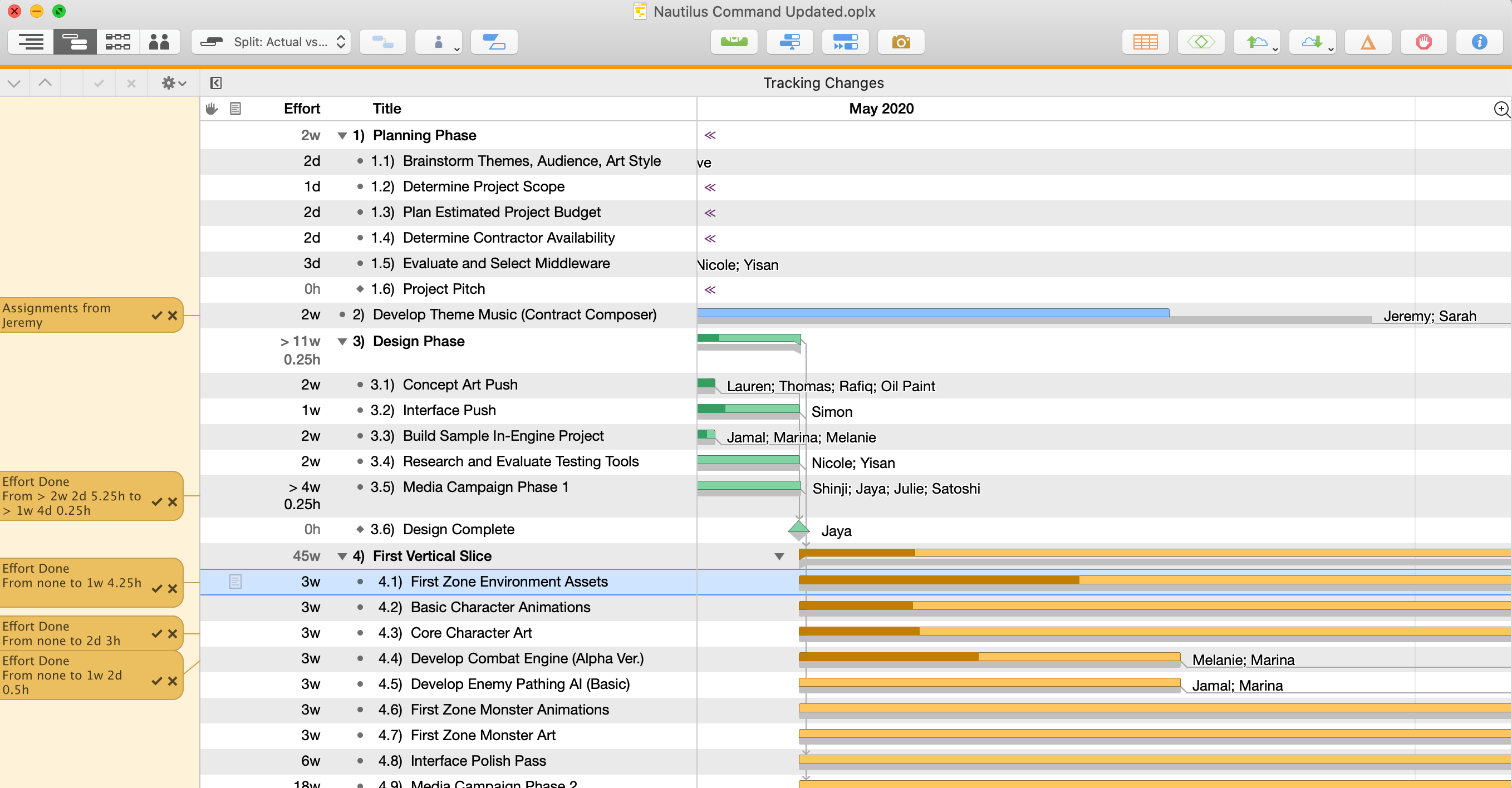
To accept or reject all changes, use the Accept All and Reject All commands in the Gear menu ![]() in the change tracking bar.
in the change tracking bar.
To accept or reject individual changes, select an individual change in the sidebar and use the Accept ![]() or Reject
or Reject ![]() buttons.
buttons.
Balancing Resource Loads Across Projects
If resources (usually human members of your team) are shared between multiple projects in the same repository, you’ll want to decide in the Collaborate action’s options whether you’ll publish the current project’s resource loads to other projects and whether the current project will subscribe to the resource loads of others.
Choosing to publish a project’s resource loads means that other subscribing projects will obey its workload information when leveling; if Julie is working on Project A on Wednesday and its loads are being published to Project B, after leveling Project B won’t schedule her to work on Wednesday.
Choosing to subscribe to resource loads means that the project will obey all constraints by projects in the repository that are publishing their loads. By using only the publish or subscribe option a hierarchy of priority can be established between simultaneous projects—a project that only publishes will always have its needs met first, while a project that only subscribes will be assigned resources only when they can be spared.
By both publishing and subscribing, projects are treated as equals—and if a project neither publishes or subscribes, it ignores external factors and syncs only with its own updates.
The key to balancing resource loads across projects is that individual resources be tagged and identified by a unique email address that is shared across all projects. This can be set in the Resource Info section of the Resource inspector.
Cleaning Up Stale Usage
If OmniPlan finds unused resource load information on the server, it detects the problem and prompts that you clean it up. This can happen if someone removes a project that is sharing resource loads using a version of OmniPlan older than v2.1, or if someone deletes the file directly from Finder or Terminal. Until you allow it to clean up, there may be misleading resource load information shared with your active projects.
The clean way to remove a project from a server repository is to open the Server Accounts window and use the Delete Project button.
Preferences
Use OmniPlan > Preferences (Command-,) to customize aspects of keyboard navigation, set how date formats are displayed, and manage templates for new document creation and reporting.
General
Use the General preferences to customize the way the Tab and Return keys work to navigate through your OmniPlan documents.
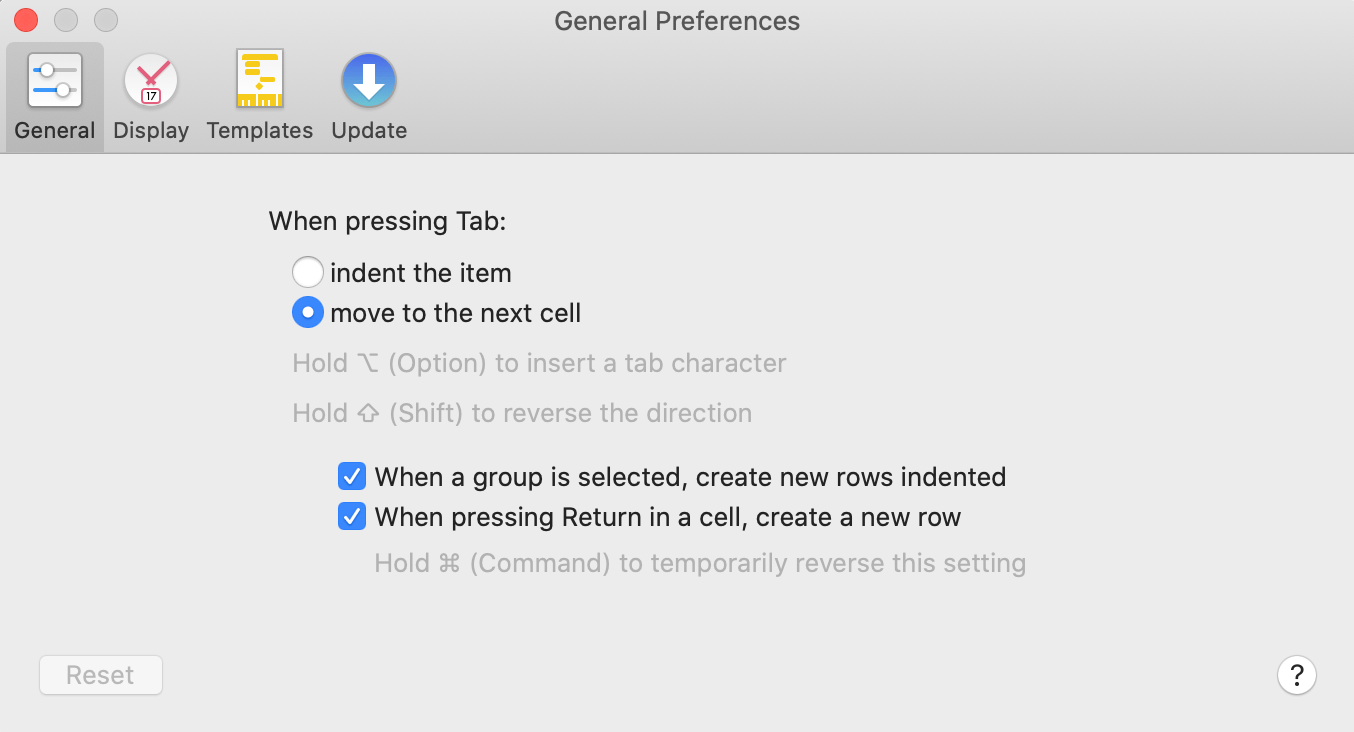
When pressing Tab—You can set the Tab key to do one of two things:
- Indent the currently selected item in the outline, thus making it a child of the item above it. Pressing Shift-Tab outdents the selected item.
- Move to the next cell in the outline. Pressing Shift-Tab moves to the previous cell.
Either way, the Indent and Outdent commands in the Structure menu (and their keyboard shortcuts, Command-[ or Command-] by default) will always work.
You can also always press Option-Tab to type a tab character at the insertion point.
When a group is selected, create new rows indented—When a group task or resource is selected and this preference is turned on, creating a new item automatically adds it as a child of the group. If this preference is turned off, the new item is added beneath the group as a peer of it.
When pressing Return in a cell, create a new row— If this preference is turned on, while editing the contents of a cell, a new item is created immediately upon pressing Return. Otherwise, editing ends and the current item becomes selected.
Whether this setting is on or off, pressing Return while not editing a cell always creates a new item.
You can hold Command while pressing Return to temporarily change the setting; for example you could press Command-Return to finish editing and create a new item, even if the setting was turned off.
Display
Use the Display preferences to control how times and dates are displayed throughout OmniPlan.
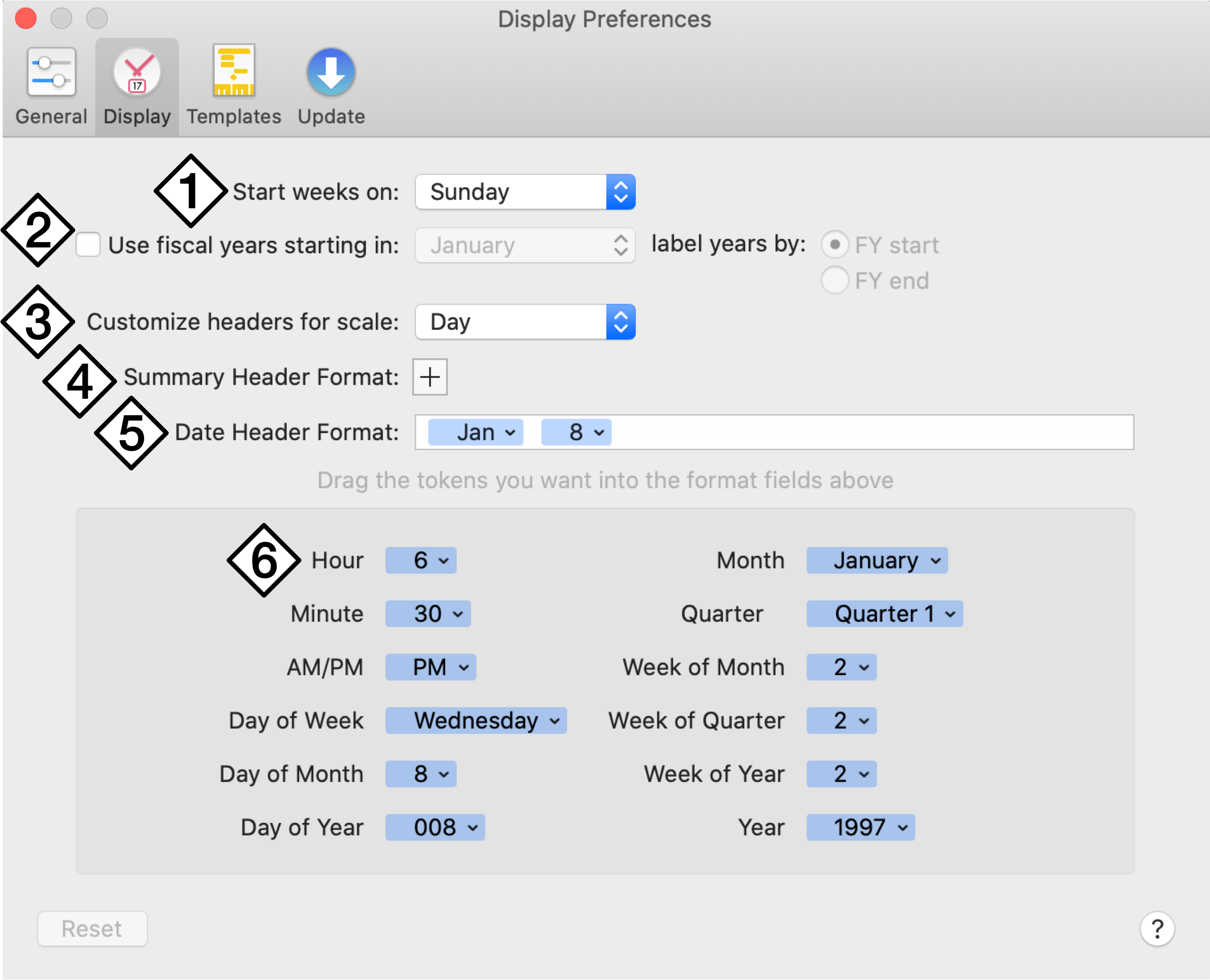
-
Choose which day OmniPlan should consider as the first day of the week.
-
Turn on fiscal years and specify when they start or end. Using fiscal years changes the way quarters (Quarter 1, Quarter 2, etc.) of your year are calculated and displayed in the date headers of the Gantt chart.
-
This pop-up menu determines which chart header scale you’ll be editing below. The different time scales appear in the headers of the Gantt chart, resource timeline, and work week chart, depending on the zoom scale.
-
Click the plus button to add a summary header to the current scale. This makes an extra layer of date headers above the normal one in the Gantt chart and the resource timeline. This extra layer gives you more room to show, for instance, the week above the day, or the month above the week. The summary header format can be customized in the same way as the regular date header format, by dragging tokens from the box below and by typing directly into the field. To get rid of the summary header, click the minus button to the right of the field.
-
Assemble a date format by dragging tokens from the box below, and type spaces or characters wherever you want them to appear. Some tokens offer information about the date at the beginning or end of a week or quarter. This is so that you can, for example, create a week format which indicates the first and last days of the week. Here we have a format that displays the short name of the month, followed by the date.
-
Tokens can be dragged to the format field above to construct a date format. Click the triangle on the right side of a token to change the display of the token. For example, you can choose to display the month as a full word (January), an abbreviation (Jan), a two-digit number (01), or a one-digit number (1).
Available date tokens include:
- Hour
- Minute
- AM/PM
- Day of Week
- Day of Month
- Day of Year
- Month
- Quarter
- Week of Month
- Week of Quarter
- Week of Year
- Year
Templates
Use the Templates preferences to manage the templates that you can use as the source for a new document. Three come built-in with OmniPlan, and you can create your own from a currently open document by choosing File > Save as Template.
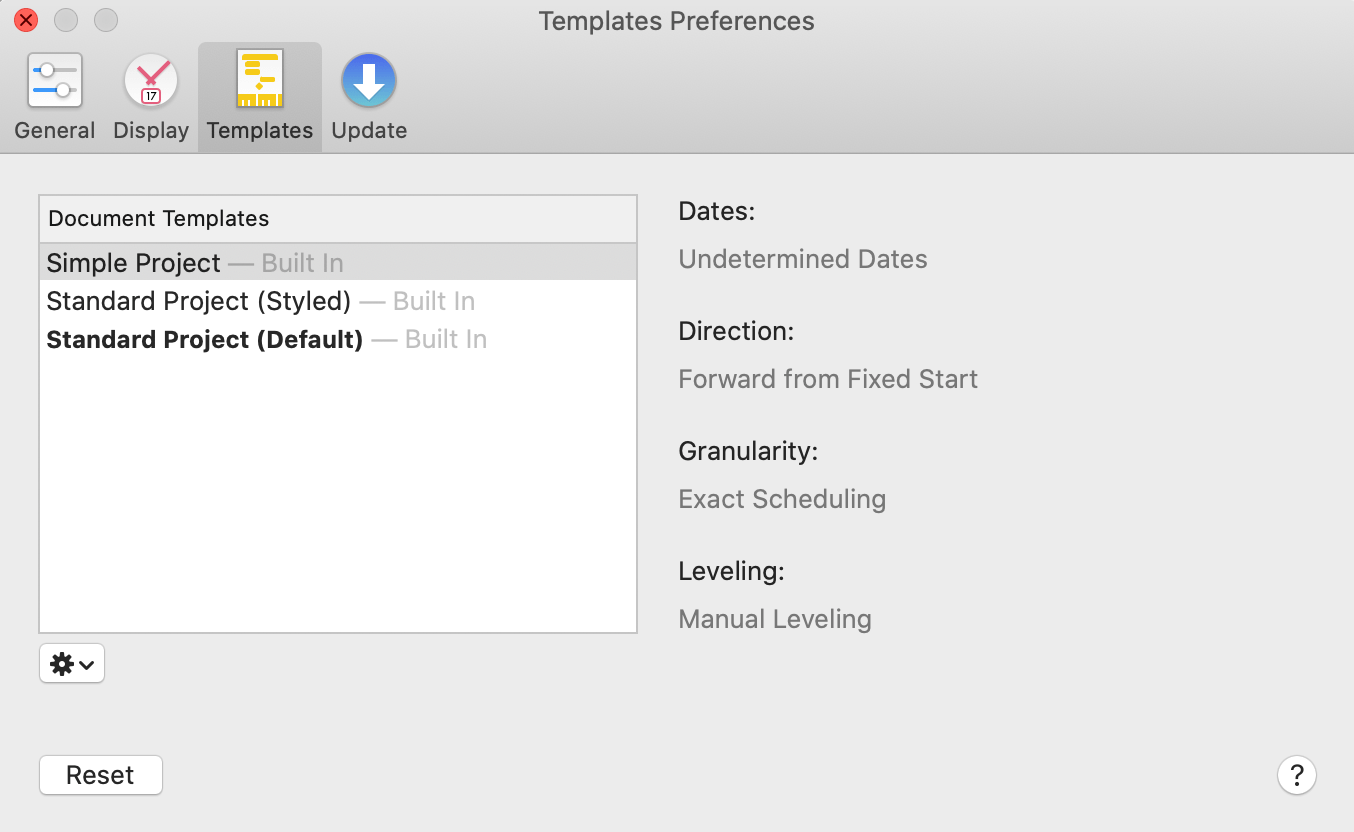
The window on the left lists the templates currently available, including those built in (indicated by grey Built In text next to their entries) and any custom templates you have created. The space on the right displays important attributes of the currently selected template.
From the gear menu below the list, you can:
-
Edit: Open the selected template file to modify it. You can also double-click the template’s name in the list to edit it. When you save your changes, the template is updated.
-
Edit a Copy: Modify a copy of the selected template file. Select this command, type a title for the new template, then change the document and save it as usual.
-
Make Default: Use the selected template when making new documents by importing files (where the New Project Assistant isn’t presented). The template’s entry in the list changes to bold type.
-
Rename: Change the title of the selected template.
-
Move to Trash: Get rid of the selected template by putting it in the trash. From there, you can still recover it if you need it. Otherwise, it will be deleted the next time you empty the trash.
Built-in templates cannot be edited or deleted. To modify a built-in template, select it in the list and choose Edit a Copy from the gear menu.
Reports (Pro)
With OmniPlan Pro, use the Reports preferences to manage existing reporting templates and create new ones.
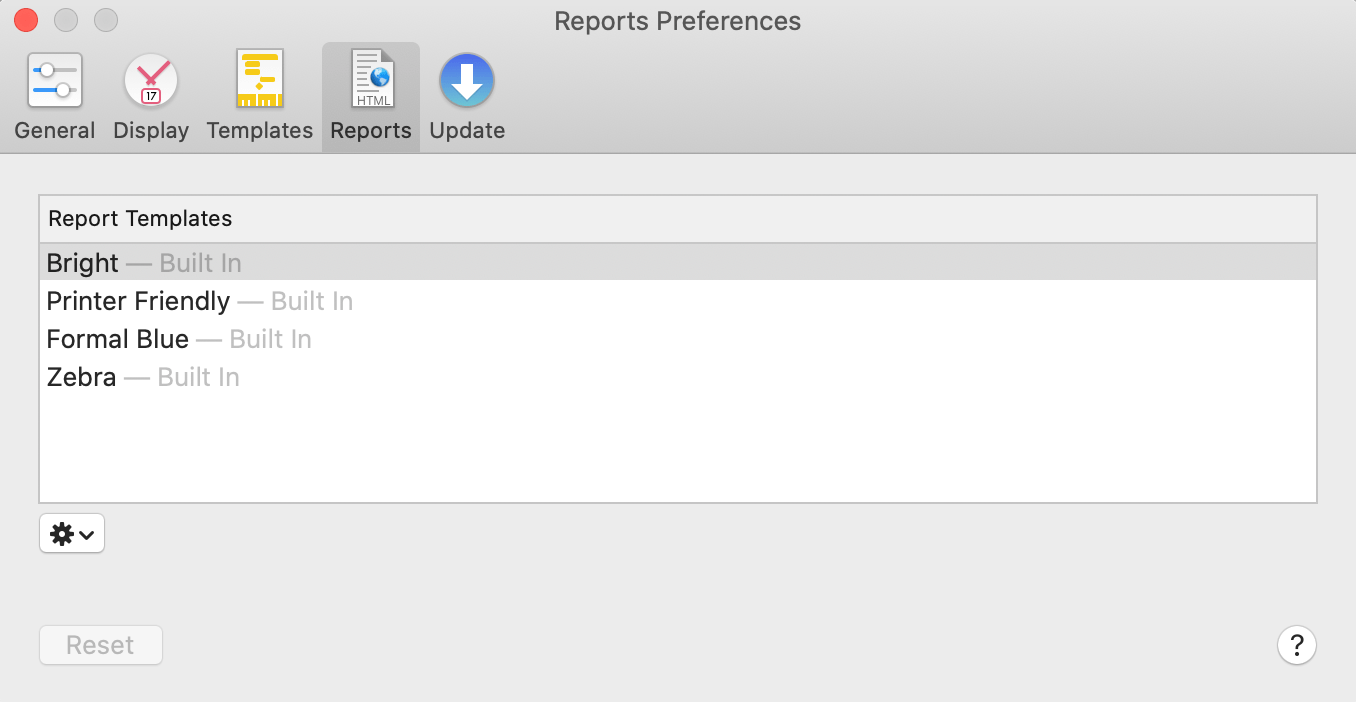
Several templates are included with the app, but if you would prefer to customize the presentation of your project when generating reports, you can create a new copy of a template using the gear menu on this pane, save the copy in a folder you designate, and edit the HTML and CSS to suit your needs.
Template integration with OmniPlan’s custom data types is done via tokens. A guide to setting up your own custom reporting templates is available in the Customizing Report Templates (Pro) section of the Reporting and Printing chapter, along with a reference list of the tokens used to fetch specific data from OmniPlan.
Update
Use the Update preferences to set how OmniPlan checks for new and updated versions of itself.
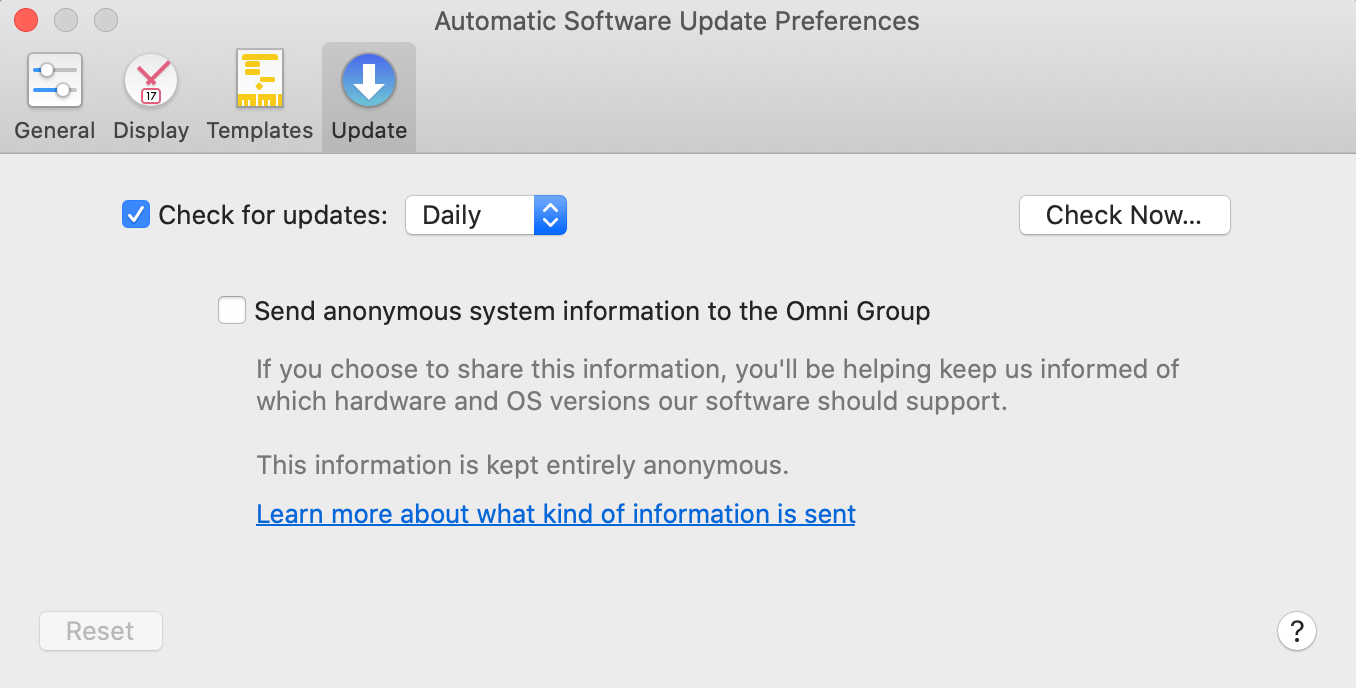
If the Check for Updates checkbox is selected, you will be notified when there is a new version of OmniPlan ready for you to use. Click Check Now to look for the newest version right away.
You can select the Send anonymous system information to the Omni Group checkbox to volunteer some information about your computer’s configuration when you check for updates. For details about what kind of information we collect and how we use it, click the Learn More link on the preference pane.
The Update Preferences pane is not present if you purchased OmniPlan 4 from the Mac App Store. When there is a new version of OmniPlan 4 available, the Mac App Store will alert you to download and install itc.
Getting Help
When you are in need of help—whether you are puzzled by the Gantt chart, stumped by a tricky violation, or experiencing another issue with OmniPlan—it’s good to know that the Support Humans at the Omni Group are available to lend you a hand.
In addition to contacting Omni support directly, there are several online and in-app resources that exist to help answer your questions about OmniPlan.
Release Notes
For a detailed, comprehensive summary of the latest changes to OmniPlan, choose Release Notes from the Help menu. This is a good place to check if something is behaving in a new way after an update.
Finding Help Online
The OmniPlan Support Site provides a wealth of information (including this reference manual) as well as how-tos and support articles which go into finer detail on working with OmniPlan.
Similarly, the OmniPlan product page is always a good place to find the latest information about features and updates to OmniPlan.
Videos
In addition to the online help, we also provide a series of online videos for OmniPlan. These videos range in topics from available features in the latest version of OmniPlan to how-to tutorial videos to help you level up in your OmniPlan skills.
Email Support
If you are stuck, if you have a good idea for the next version of OmniPlan, or if you want to let us know how we’re doing, go ahead and send us an email. Choose Contact Omni from the Help menu to queue up an email message addressed to us, or send us an email with your thoughts. We take support seriously, so you can expect a prompt response actually typed by human hands.
Phone Support
We understand that sometimes you can’t wait for an email response when you are knee-deep in a project and you are stuck or something is not working quite right. When this happens, you can call our Support Humans at 800-315-OMNI or 206-523-4152. Our Support Humans are available Monday-Friday, from 10 a.m. to 5 p.m. Pacific Time (-0700 GMT).
Online Forums
Omni maintains online forums for all of our products, which are available to everyone. Come share your questions and ideas with other users, share tips to show off how you are using OmniPlan for getting stuff done, and seek help from the OmniPlan community.
